




































































































DSS Construction is rebranding as Smithwright - the high mark for custom home building in North Idaho. Just as shipwrights honed their skills in the rugged environments of coastal regions, Smithwright’s expertise was forged in the mountains and forests of North Idaho, where the demands of the terrain cultivated a culture of excellence in construction. Creating a fusion of tradition and innovation, where time-honored techniques meet cutting-edge design to create homes that epitomize elegance and durability.















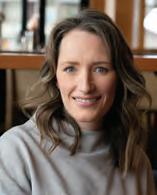


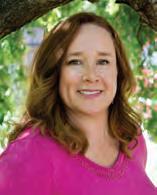




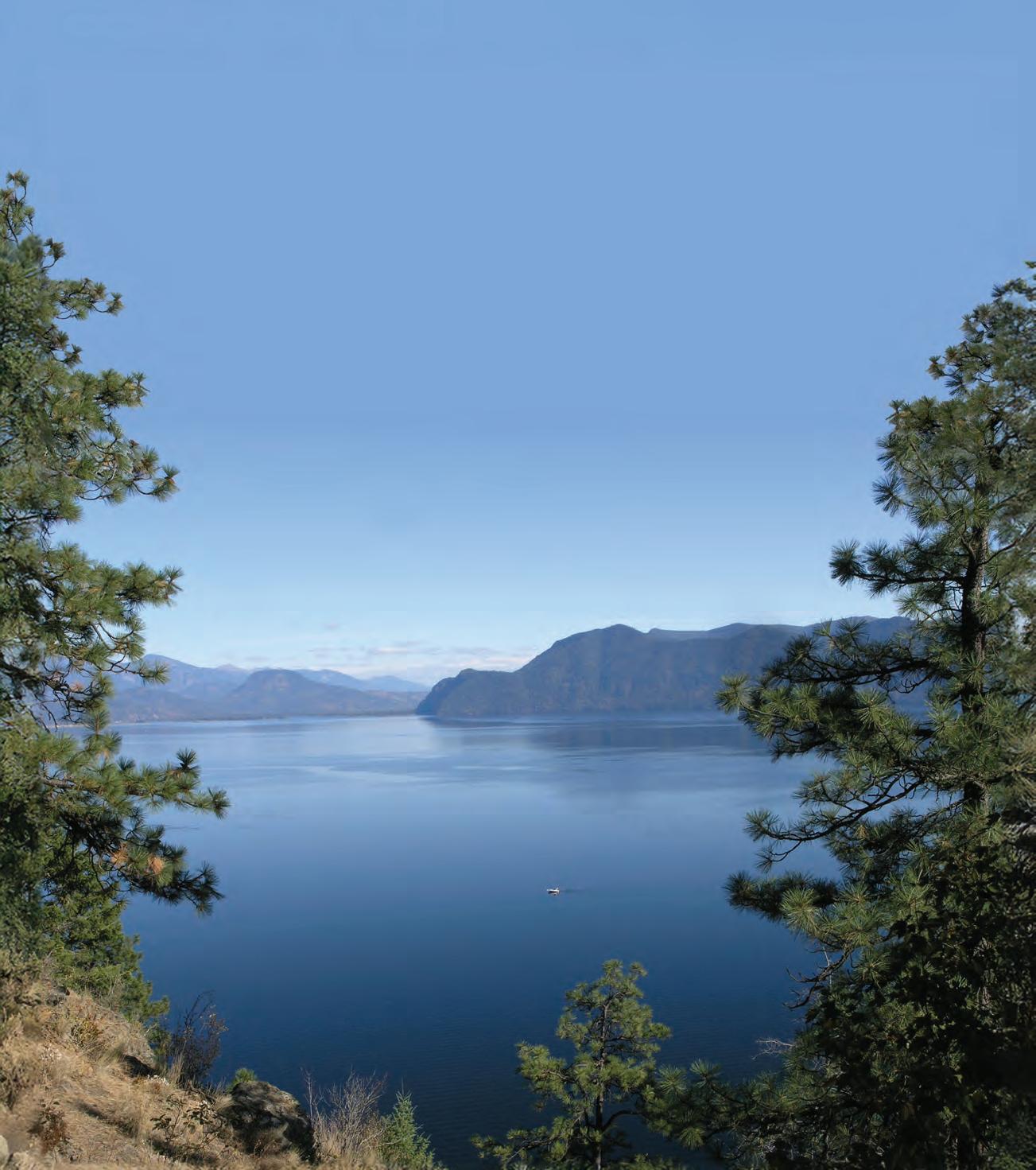




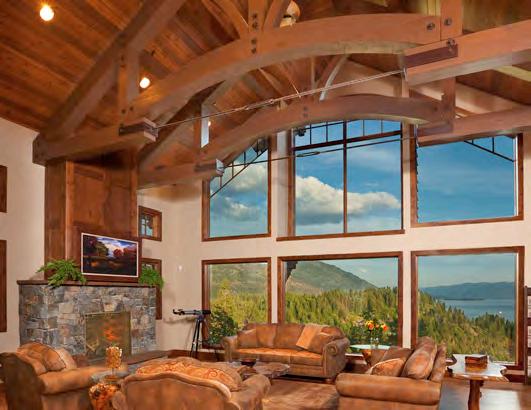
When
Robert Smith hikes 70 lakes with a kayak on his back


What the publisher saw on that fall morning.
Before I tell about the photo above, here are a couple observations about close encounters of the wild kind. The first is that most people here can tell stories about getting up close and personal with our blessedly abundant wildlife. Even those who live right in town have tales, whether of the ubiquitous squirrels, or the ospreys and eagles that nest along the lakeshore. Deer, moose and turkeys are common.
My second observation? This abundance of wild neighbors is indeed one of the blessings of North Idaho life. Most places have a fraction of the wildlife we enjoy on a daily basis. That's one reason we asked local photographers to send us their favorite shots of wild things, along with the tales behind their encounters. Our cover story starts on page 76.
My own tale to go with the photo here came on a fall morning a bit before sunrise, from the kitchen of our home few miles west of town. Looking out the window I saw a large cougar step into our yard. He was magnificent. I rushed to the next room for my camera and managed to snap off two photos as he ambled by a couple sawhorses and a water tank alongside our driveway. Then he was gone.
Alas. I had been shooting with my camera in manual mode the previous day and the focus was way off. The result is the ghostly image you see. You can make out his tail and feet and a bit more. He's the only wild cougar I've ever laid eyes on and, ghostly capture or not, the moment was slightly epic. Wonderful wildlife is but part of what makes this place special. Read on to see many more facets of our town. - CB
Publisher Chris Bessler
COO Jeff Lagges
Editor Trish Gannon
Eats & Drinks Editor Lyndsie Kiebert-Carey
Events Editor Misty Grage
Advertising Director Clint Nicholson
Art Director Pamela Milless
Design Team Dan Seward
Digital Marketing Erica Larson, Shelby Ambrose, Brandy Nicholson
Office Manager Susan Otis
IT Manager Ethan Roberts
Sales Mitchell Fullerton
29 interview: jens Weiden
Pictured in History: Ole Jennestad
history mystery: county poor house
Essay: sounds of summer
Sandpoint of view: Chatty’s take
96 a room with a view
Architects frame the landscape 103 So what IS a Local?
Being ‘of’ a place rather than ‘from’ it
bayview float homes
A unique waterfront lifestyle 109 Welcome home
Trust makes homeownership dreams come true 113 Town landmark for sale
Uncertainty for Sandpoint’s tallest landmark 119 city of industry
Is Amazon joining our industrial hub?
132 pours for a richer community
Taphouses committed to community causes
the beacon of hope
B’s Beacon has quality today, and a dream for tomorrow
the clubhouse restaurant
Where scratch-made meals meet remarkable scenery
Get to know a restaurant pro 143 courting tasty options
Food courts are thriving 144 the local dish
Contributors: Action Sports Media, Rachael Baker, Cameron Barnes, Sammy Berryman, Bonner County History Museum, Jennifer Bloch, David Broughton, Barry Campbell, Dig Chrismer, Tim Christie, Hannah Combs, Kevin Davis, Susan Drinkard, Susan Drumheller, Jason Duchow, Jennifer Edwards, Cindy Eskelson, Mike Gordon, Zach Hagadone, John Holen, Cate Huisman, Ashley Kendall, Jillian Klauke, Linda Lantzy, Kathryn Larson, Jenny Leo, Emily Levine, Saylee Marmon, Jimmy Matlosz, Ben Olson, Steve Ominski, Dawson Owens, Amy Peterson, Rick Price, Cameron Rasmusson, Scott Rulander, Renee Sande, Libby Schoonover, Eric Towle, Mark Vogt, Pam Webb, Woods Wheatcroft, Keilynn White, Judy
©2025 by Keokee Co. Publishing Inc. All rights reserved. Reproduction in whole or in part without written permission is prohibited. Subscriptions: $14 per year, payable in advance. Subscribe at www.SandpointMagazine.com. Sandpoint Magazine is distributed by Panhandle Special Needs, Inc 10 almanac 25 events
York and introducing Chatty Keokee. Sandpoint Magazine is published twice yearly, in May and November, by: Keokee Co. Publishing, Inc. 405 Church St., Sandpoint, ID 83864 208-263-3573 • www.keokee.com
Printed in USA by Century Publishing, Post Falls, Idaho.










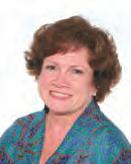








On the eastern side of Bonner County, nestled in the Cabinet Mountains and home to the county’s tallest peak, lies 88,000 acres of the proposed Scotchman Peaks Wilderness Area: public land that’s been managed by the Forest Service as if it were wilderness for almost 40 years. Generations of Bonner County residents have enjoyed it for hiking, hunting, fishing and exploring just outside their back doors.
“When you get into the wilderness you can feel the sense of wonder and awe. To me that’s what wildness is about,” said Phil Hough, current executive director and a founding member of the nonprofit Friends of Scotchman Peaks Wilderness.
Wilderness areas offer essential habitats for wildlife, plants and trees, while also drawing tourists who boost the local economy. They are a haven for hikers, hunters, anglers and nature enthusiasts. Places like the Scotchmans are designated so that natural change can occur over time, allowing future generations to experience the area the same way their parents and grandparents did.
On January 14, 2005 the U.S. was undergoing a forest plans and revision process. A handful of people from Idaho Conservation League, Montana Wilderness Association (now Wild Montana) and the Native Plant Society came together to discuss the best ways to create something that specifically advocated for the Scotchman Peaks.
During that first meeting, they contemplated what it looks like to advocate for wilderness in the forest plans. Specifically, a heavy premium was put on the Scotchman Peaks because it was what united all 20 people in the room.
“By the end of the first meeting we had a basic shell of a plan which was to say we need to put a couple committees together to do outreach, to do an event, to look at the structure of things,” Hough said.
In the years since, the nonprofit slowly built public support for the area to be maintained as it had been. It also created a Trail Ambassador program, hosts volunteer-led guided hikes, a volunteer trail work group and a Youth Winter Tracks program that, as of today, is on pace to reach over 500 students from Bonner County, Idaho and Lincoln County, Montana.
“The hikes are heavy in the summer and designed to get people out to talk about trees, mushrooms and wildflowers,” said Hough. “We design all of our activities and engagements in mind with it being a comfortable space for people of all backgrounds and all different kinds of perspective on wilderness and the outdoors.”
But in 2018, riding a wave of voter dissatisfaction with government management of any public land, a countywide advisory vote derailed the effort to get official wilderness designation for the area. With a little over 10,000 people voting, 54 percent were against the idea. Since then, the Friends of Scotchman Peaks has continued their work to help preserve this area for the generations to come.
“Our programs integrate stewardship, education and outreach to do just that— introduce people to this special area and help keep it maintained,” Hough said. Continued outreach events bring in new supporters to build a community of volunteers and advocates to protect the area for decades to come.
Learn more at www.s cotchmanpeaks.org

—Sammy Berryman

For most people who live in town, the moose who wander through our residential areas and lend Sandpoint its Twin Peaks vibe are a not-so-secret pleasure. When the moose are just babies, that pleasure comes with a healthy dollop of concern for their welfare, amply demonstrated this last winter when three orphaned-too-young calves roamed neighborhoods, happily feeding themselves on winter landscaping.
In winter, moose are scraggly and the temptation to feed them can be overwhelming to some. But don’t. “A fed animal is a dead animal,” Fish and Game warns and for good reason. Moose have evolved to exist on vegetation available in winter, and can
quickly die if given access to food they’re not accustomed to.
One of the young moose died before March. Another calf determinedly tried to enter the automatic doors at the hospital, and at the local Safeway. It was a sign of another problem—an animal that has become habituated to humans. It may seem cute to some, and can somewhat easily be dealt with, but the same will not be true as it grows. “That’s a public safety concern,” said T.J. Ross, regional communications manager for Idaho’s Department of Fish and Game. “When an animal becomes habituated to humans, it can become a problem, especially as it grows. It may become demanding, or be easily startled,” he said. “Our first concern is public safety. [When an animal becomes a threat to that] we only have two options: relocate or euthanize it.”
The two remaining calves in town were captured in early spring by the department and relocated out of the residential area.
Although the removal of the calves was a successful operation, it isn’t always. The procedure carries risk for both the animal and the officers involved, thanks to the unpredictability of the animal, the drugs used and the transport of a heavy object. (One of the young moose already weighed close to 200 pounds.)
It’s inevitable that more moose will show up in town, and when they do, there’s one rule to follow: “Leave wildlife alone,” said Ross. “Interfering with a wild animal never ends well, either for the animal or for people.”
–Trish Gannon

Agood read is one of life’s little pleasures. Yet good stories do have a final chapter. Such is the case for The Corner Bookstore. After 28 years of providing good reads to the community, Jim Orbaugh is closing his bookstore.
The book bug bit Orbaugh hard at a young age. He began collecting books and as a young adult he started a catalog business. Through the prompting of his girlfriend, Paula (they later married), Orbaugh moved to Sandpoint and in 1997 he opened The Corner Bookstore, so named since it was on the corner of Main and First Avenue.
Once business picked up after a couple of years, Orbaugh began seeing regular faces. Many of his customers became friends, and were considered to be extended family. After 20 years at his original location Orbaugh moved to Fourth Street. And yes, it is a corner location.
Although it is a larger store Orbaugh noted, “I used to be in the middle of the tourist traffic at the first location.” People now have to seek him out. And that they do. “Much of the inventory consists of trades and donations,” said Orbaugh, who gives a rough estimate of having at least 10,000 books in stock including what’s in storage.
Currently there is a large closeout sale; however, even if the store doesn’t secure a buyer, Orbaugh, age 84, will close the bookstore at the end of July. He plans on moving back to Southern California to be with family. In terms of retirement, like all dedicated bibliophiles, he will use the extra time to get caught up on his reading.
–Pam Webb



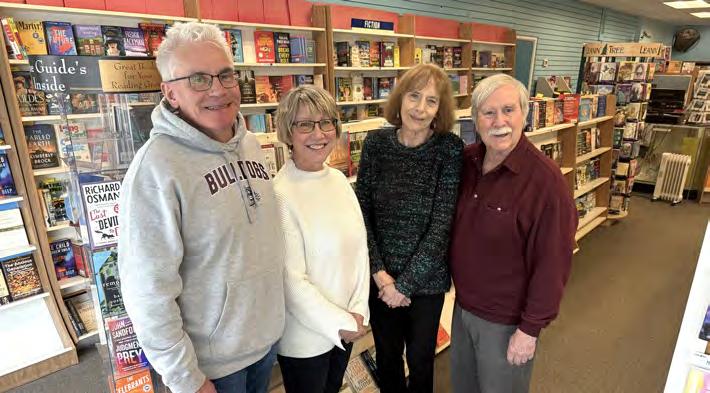
After 47 years Tom and Marcia Vanderford of Vanderford’s Books on Second Avenue have ended their tenure as bookstore owners and have turned over the keys to new owners Stacey and Rod Estes.
Last year the Vanderfords moved their bookstore from Cedar Street, a location held since 1978, to Second Avenue. (The couple operated a second store for 12 years at the Bonner Mall.) Selling their business has created mixed feelings for Marcia.




While glad the new owners are book lovers, Marcia will miss the opportunity to fulfill her inner book nerd. “Nothing is more satisfying for a bookseller than putting the right book into the hands of a reader at just the right time.” She said author events were a highlight of her time as a bookseller; one favorite was when they hosted Marianne Love, Pat McManus, Boots Reynolds and Sandy Compton at one event. “They signed lots of books, but they were having even more fun cracking each other up.”
Marcia admits owning a bookstore has its challenges, like deciding what to stock, and the more recent competition of online booksellers. This is a real issue of concern for bookstore owners, said Marcia. “If people value having a local outlet for books then they must support them by buying and ordering from them.”
Like most people who retire, Tom and Marcia plan on traveling. As they pack their bags and get ready to relax, Marcia expressed her gratitude for all the support provided by customers and the community over the years, and encouraged patrons to support the bookstore’s new owners, Stacey and Rod Estes.
Recent residents of Hood River, the Estes decided to spend their retirement years running a bookstore as a means of fulfilling Stacey’s lifelong dream of owning one with her older sister. “Before we could make it come true she was afflicted with cancer and passed away. So what better way to honor her memory than to live the dream that we had together, and thankfully I have an awesome husband willing to come out of retirement to partner with me.”
With new ownership comes changes; the store’s name is one. Sandpoint Books is now open in downtown Sandpoint at 421 N. Second Ave. There are plans for a larger social media presence, and adding a children’s story time. The Estes value how the Vanderfords cultivated that special bookstore atmosphere and will continue to provide personalized service along with the perks of the Book Lover’s Card and special pricing on book purchases.
A book in hand is one of the values of shopping in a bookstore, and as Stacey said, “Introducing people to those previously undiscovered gems they didn’t know they were missing!”

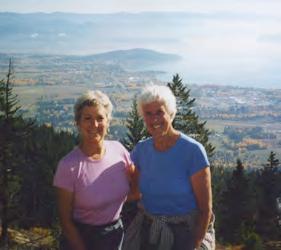
One thing most residents have in common is a “Long Bridge story,” that first moment when we glimpse Sandpoint and fall in love. Subtly hidden within that first view is another key piece of our community’s soul: the Mickinnick Trail.
“That mountain and its trail are the backdrop of Sandpoint,” said Nicky Pleass. Stumbling upon the land rising behind Sandpoint in 1989, Nicky and her husband Mick knew immediately the place was special. Known as Greenhorn Mountain, the couple acquired the property and looked forward to exploring the craggy cliffs and forest around their new home.
Creating a trail for the public was something Mick always wanted to do and after his passing in 1996, Nicky donated 160 acres to create a memorial trail. She and her friend, Jan Griffitts, ribboned out a winding path that led to an expansive view over Sandpoint and Lake Pend Oreille. “We’d start in one direction until we’d find ourselves at a cliff’s edge and then have to regroup and head in a different direction,” explained Pleass. “The Forest Service changed it a bit but overall, that original ribboned trail has remained the same all these years.”
Asked to help make the trail a reality, Griffitts began making the rounds, gaining support from then-Sandpoint District Ranger Dick Kramer, then-Mayor Ray Miller and then-Senator Shawn Keough. “Without their support, I don’t think it would have happened.” The county was harder to convince, but after enlisting another four dozen supporters Griffitts got approval—and the job
of raising the $126,000 the trail was estimated to cost to construct.
Pleass has always felt that sharing her property to create the Mickinnick Trail (a combination of the land-owning couple’s names, and a play on the name of a native plant, Kinnickinnick) was absolutely something she had to do. “It would have been selfish to hang on to it for personal use. Preserving it for the community, so others can take advantage of that solitude at the summit, that was what was important. Donating the land wasn’t necessarily cheap or easy, but it was so, so worth it.”
In the 20 years since, the Mickinnick has become a staple of the local trail system with its easy access from Sandpoint. Conquering the 3.5-mile route to the summit can offer some challenging terrain (“the first mile-and-a-half is all uphill,” said Griffitts) but breaking up the hike by reaching the first or second bench is a milestone that many residents, young or old, don’t soon forget.
“The Mickinnick Trail was always about that view,” Pleass added. “Mickinnick is a hike to a view.”
Griffitts agreed. “The first time Nicky and I hiked to the top, we cried,” she said.
Even if you only make it to the first bench, the incredible vista over Sandpoint and Bonner County is something you won’t soon forget. Almost like that first time across the Long Bridge.
The trailhead is located about a mile up Woodland Drive off the road to Schweitzer.
–Dig Chrismer

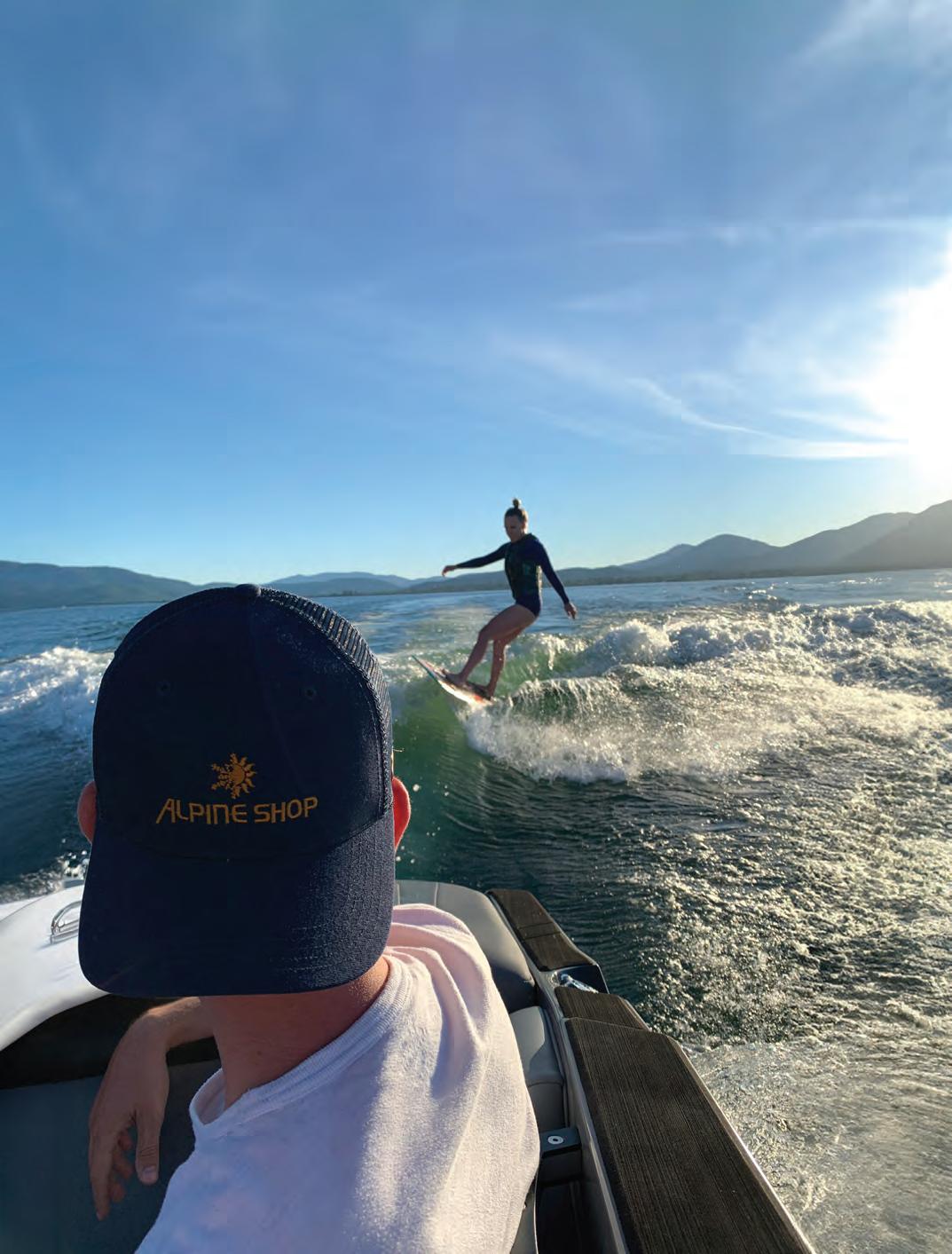







ee SPOT run. Up to 12 hours a day, every day, from town to town, for 14 years. Now see SPOT getting a few much-deserved upgrades.
“We are so excited to have received two new buses to serve Bonner County,” said Donna Griffin, executive director of the award-winning program Selkirks-Pend Oreille Transit Authority—SPOT for short.
Funded by grants, with a 20 percent match by local partners, these buses will replace a 2006 and a 2011 bus with a logged total of 655,163 miles. The retired buses will be sold in the upcoming months.
“Look for them to be on the roads soon with a third bus being delivered here shortly for our Boundary County demand service!”
Since 2011, SPOT has been providing free bus rides to residents of Bonner and later Boundary counties, and the numbers speak for themselves—1,300,000 total rides given—68,271 of those in 2024 alone.
The impetus behind it all was recognizing that providing free mobility to residents who might not otherwise have it could directly impact their quality of life. While the majority of riders are seniors, SPOT also makes it possible for workers,
students and others without their own transportation to get to where they need to be and want to go.
In 2015, SPOT also started offering demand-response service three days a week within Boundary County. A connection from Bonners Ferry and Naples to Sandpoint and Ponderay is now offered on Thursdays as well.
Rides to Schweitzer and special event service are other SPOT offerings that keep cars off the road and help get more residents out to enjoy their community. The week-long Festival at Sandpoint is a good example of this: fewer cars lead to less congestion in the surrounding residential area.
Since SPOT is not supported by area taxes, grants cover an average of 58 percent of SPOT’s operating costs, with the remaining 42 percent provided by the generous donations of communities it serves.
“Receiving all the grant funding we applied for in 2024 is a tribute to our partners and our community who sincerely support this valuable service and keep SPOT buses rolling,” said Griffin. “Thank you!”
Learn more at www.spotbus.org
–Renee Sande
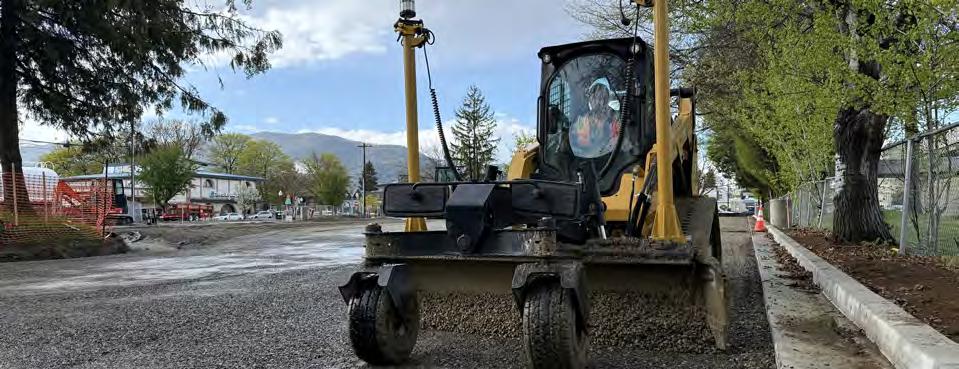
Once the days get warm Sandpoint’s City Beach entices people from miles around to take a swim or launch a boat in Lake Pend Oreille’s sparkling water, grill burgers with family and friends, and lounge on the beach’s fine sand that gave the town its name.
That is, if they can find a place to park. The area’s popularity has created a parking crush for locals who want to enjoy the amenities they live here for, as well as the visitors who come to stay and play.
The city is hoping to facilitate parking for all users with sweeping changes to parking rules. As of early May a new draft master parking plan calls for instituting paid parking at the city’s six parking lots, and possibly on some of the more heavily utilized city streets, with peak season pricing implemented for the city-owned lots along the water.
The plan proposes paid parking by the hour at its lots, but also provides for an annual parking pass city taxpayers can purchase that would allow up to six hours of parking at City Beach and three hours at other lots; those who live outside of Sandpoint could purchase a pass allowing three hours of parking at City Beach and two hours at other lots.
If those time limits are exceeded, all pass holders will pay the additional hourly parking fee.
The plan’s fee model as of early May was based on an hourly rate of $2, with peak time pric-
ing of $3—but an annual pass for city taxpayers would be just $15, or $30 for non-city residents. As of press time these were only proposed fee figures, and subject to change with the plan’s adoption.
Two public parking lots along Fifth Avenue that are owned by the Idaho Transportation Department would remain free.
Businesses and any residents who live within the downtown core’s Commercial A zone will be able to purchase all-day parking passes for the city-owned lots along with some timerestricted street parking zones for a monthly or annual fee.
Of course, purchasing a pass won’t guarantee you’ll actually be able to find parking when and where you want it, but the goal is to create more parking turnover and encourage parking in currently under-utilized areas.
Boat owners also face new charges. Boat launch fees are proposed, at $10 per launch for Idaho residents ($15 for out-ofstate and commercial users) at City Beach and Memorial Field. Annual passes could be purchased at $50 and $100 for private users; commercial users cannot buy a season pass.
Time limits on some under-utilized free street parking would be expanded to allow for all-day parking for all users.
Parking concerns were amplified even more in April after a new 89-unit apartment complex was proposed on Church Street that would take advantage of the downtown core’s exemption for required off-street parking. The draft plan calls for reinstating a requirement that residential developments in the core provide for parking. As drafted, future developments would be required to provide for parking depending on the square footage of their living units.
The draft plan projects the new fees might raise $300,000 to $350,000 per year “that can be put towards maintaining and improving the city’s public parking infrastructure, while providing a funding source for the eventual development [of] a public parking structure for downtown Sandpoint.”
Jason Welker, community planning and development director for the city, noted “Nothing is settled until [the city] council makes a decision on a policy in late June.”
–Trish Gannon

Storyteller Artist Proof
Artist: Lawerence Vargas
Inspirations stem from his rich and varied lineage including the influence of early Aztec Indian beginnings.


by Kevin Gadomski and his son Tanner.
Their native heritage is from the Turtle Clan of the Grand Portage Band of Ojibway. Manitou is the Ojibway (or Chippewa) word for Spirit or Mystery.


This past April 18, generous residents gathered at Matchwood Brewery to share what they love about living in Bonner County. They were celebrating the success of a new annual philanthropy campaign, Live Give 7B, which had successfully encouraged them to express their fondness for local nonprofits with words, actions and monetary donations.
Spearheaded by three organizations—the Innovia Foundation, Kaniksu Land Trust and the Community Resource Envision Center—the project debuted in April. Residents were encouraged to shop at local businesses as well as give to local causes and they overwhelmingly responded, raising over $228,000, well above the $70,000 goal. “Forty-four organizations received donations,” said Dig Chrismer, the rural engagement manager for Innovia Foundation’s northern region. “It was an overwhelming response.”
The idea emerged from an ongoing monthly meeting of executive directors of county nonprofit organizations. “We discussed how nice it would be to have a community-centric focus on philanthropy,” Chrismer said. “It speaks also to businesses that are dedicated to supporting our community.”
Innovia staff drafted a proclamation for mayors to adapt

and use. Katie Cox, executive director of Kaniksu Land Trust, worked with a graphic designer to come up with the logo, while Katie Bedalke of the Envision Center put together the project’s website. At the site, supporters could (and still can) search for their favorite charitable organizations and make contributions directly to them.
There are also plans for an “alternative giving market” in November. At the market, nonprofits will provide information about what they do, and shoppers can make donations to use as gifts for friends and family in lieu of material gifts.
The group envisions both projects as constructive forces in the community. As Chrismer put it, “Making donations to our favorite causes gives us all a chance to focus on positive things, rather than getting in the weeds about parking.”
Learn more at www.7bgives.org






There’s a knack to exploring downtown Sandpoint—peruse the shops at not quite a gander and perhaps a little more relaxed than a stroll, and you’ll inevitably find yourself catching glimpses of the spirit of this town and its residents. Trinkets, bobbles and clothing celebrate our town on each block, yet one can argue that no shop captures Sandpoint’s essence better than Art Works on First Avenue.
Back in 1995, locally and nationally recognized artist Barbara Janusz spearheaded a project to create a gallery where other local artists could display, share and sell their work. For over 30 years, from their first location in the Power House Building to their current spot at 214 N. First Ave., this rotating collection has helped hundreds of local artists showcase their talents.
“In any given year we have about 24 working, paying members to Art Works,” explained Julie Ellis, current board president for Art Works. “We display our art, paying a monthly fee to reserve our space in the gallery, and then support the overall operation by giving back 20 percent of our sales to Art Works.” Ellis noted that members are also asked to work a day or two each month to help out, making this a relatively inexpensive way to share their art with the public while staying connected to the community.
Art Works also offers the option for some artists to use the gallery to showcase their works on consignment. “There can be a lot going on in peoples’ lives so this helps them still get their work in front of our community,” added Ellis. “Our goal is to give back as much as we can to our members and consigners. We provide the space, they determine their pricing and how they want to approach making their art accessible to a larger audience.” There are approximately 30 artists displaying at the gallery at any given time with an additional one or two on the waiting list. The current board is working on plans

to grow the footprint of the gallery and provide even more opportunities for local artists to get involved.
With an impressive collection from various jewelry designers, glass sculptors, photographers, painters—almost every medium imaginable, in fact—Art Works continues the good work started 30 years ago, capturing the soul of Sandpoint and sharing it with all who meander in to visit.
–Dig Chrismer

The Sled Hill

Kaniksu Land Trust received a $238,000 grant for improvements to the Sandpoint Sled Hill from the Outdoor Recreation Fund Advisory Council. The list of improvements includes a parking lot, trail system, new road access and vault toilets. This spring a short film by Tanner French Films, “The Sled Hill,” premiered at the Panida Theater to a packed audience. The film tells the backstory of the Sled Hill and why it’s so beloved in the community. You can watch the roughly 12-minute film at sptmag.com/sledhillmovie

It was a sad day in early April for locals who grew up collecting a personal pan pizza for the books they read in the area schools’ BOOK IT! program, as heavy equipment was brought in to tear down the local Pizza Hut. Located on the grounds of the Bonner Mall, Pizza Hut opened in 1986 under owners Tom and Connie Gotschall and closed in January of 2024. A September 2024 article in the Spokane Journal of Business announced that a branch of Numerica Credit Union plans to open in that location this fall.
Photo by Mike Gordon.

As any area gets crowded tensions can rise... including among birds. The osprey pair who nest each spring at Memorial Field returned from their winter migration to find a goose couple in their nest. Despite attacks by the osprey, the geese maintained and hatched four goslings in April. At press time the osprey had yet to reclaim the now-vacant nest. See the live nest cam at sptmag.com/osprey—or watch a clip of the goslings making the 90-foot jump from the nest, at sptmag.com/goslingjump.

The Army Surplus store, a fixture on Fifth Avenue for decades, shut down after a devastating arson fire on July 4 in 2024. It has now reopened at 30640 Hwy. 200 in Ponderay, just across the highway from the entrance to the Bonner Mall.
This year, concert goers will no longer be allowed to bring in outside beverages or glass containers. In addition, no hard-sided rolling coolers will be allowed through the gates. The Festival has shared that the new rules were adopted to comply with their insurance company’s requirements.







Local film “Missouri Breaks” now streaming Mike Gordon proudly shared, “My son’s movie that he filmed is now available on Amazon Prime!” Liam Gordon was director of photography on “Missouri Breaks, the Ballad of Missouri Bill.” Mike shared his son, “did all the filming, drone footage, and photography,” on the project. The film follows a Civil War veteran (the Missouri Bill of the title) in his life after the war in the Idaho Territory, and the ghosts that followed him. Its creation was a true local effort, with Jarrod Christman as producer, editor, writer, co-director and actor, and Roley Schoonover, Silas Anselmo, Mac Hege, Robert Chavez, and co-director Weston Grillo playing roles in the film. The sound track even features Christman’s band, Missouri Breaks. The film, which premiered at the Panida Theater last summer, has picked up 15 festival wins.
David Keyes, former Sandpoint Rotary President, has a new role beginning July as District Governor for Rotary International District 5080, with 57 clubs and more than 2,000 Rotarians. The Sandpoint and Ponderay Centennial clubs will host Keyes’ District Conference in Sandpoint in May of 2026, where up to 400 Rotarians are expected to attend. As part of the conference, a hand-carved peace pole will be unveiled and a time capsule will be buried at the Pine Street Woods with the help of Kaniksu Land Trust. The committee has many surprises, guest speakers and displays planned for downtown Sandpoint and the hub of the conference will be at the Panida. Globally, the 1.4 million Rotarians are focused on peacekeeping as well as eradicating polio. Locally, Rotary clubs in Sandpoint and Ponderay raise money to support local education efforts, and provide hundreds of thousands of dollars in scholarships for students.











13-31 POAC Artwalk Local artisans, galleries and business owners throughout downtown Sandpoint collaborate each summer for an event designed to showcase all that our unique town has to offer. This is a free, city-wide event. Learn more at www.artinsandpoint.org.
14 CHAFE 150 Sandpoint Rotary presents the Annual CHAFE 150 Gran Fondo. The 150-mile route is a grand loop around the Cabinet Mountains. CHAFE offers magnificent 100-, 80-, 40-, and 30-mile routes, and a family fun ride for riders of any level. Proceeds benefit the Lake Pend Oreille School District's Literacy Initiative and after-school reading programs. www.CHAFE150.org
28-29 Sandpoint Renaissance Faire. Two days of fine entertainment, eclectic merchants and a joyous atmosphere. Turkey legs, fairy supplies, jewelry for your finery, chainmail and pottery. All of your medieval needs. Costumes are encouraged and admired. Event will be held at the Bonner County Fairgrounds, 4203 N. Boyer Rd. For more information, check www.sandpointrenfaire.com
21-22 Race the Wolf Ultra-Marathon at Schweitzer Race the Wolf courses provide a mountain trail running experience with a supportive, front country atmosphere. Takes place on Schweitzer Mountain. 5-miler, half marathon, marathon and sky-climb options. Learn more at www.priestlake.com/racethewolf
21 Find your Strength 5K & 1K 5k and 1k Fun Run. The race starts and finishes at Sandpoint City Beach and down the Sand Creek trail, followed by a family friendly after-party. Learn more at www.bonnergeneral.org/find-yourstrength
26 Sandpoint Summer Sampler The finest area restaurants and caterers

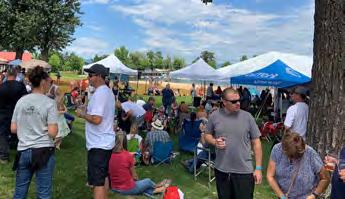




will be in Farmin Park offering all sorts of tasty treats. Drinks, live music, giveaways, and fun for the whole family. Find out why the best restaurants in the Northwest are located in Sandpoint.
28 Monarch Grind Gravel Grinder This 70-mile bike race starts and ends in Clark Fork and includes approximately 8,000 feet of elevation gain. Proceeds support Pend Oreille Pedalers and KRFY community radio. www.panhandlegravel.com
5 Sandpoint Beerfest Featuring over 20 handcrafted beers from local breweries, plus ciders and seltzers. Live music. Must be 21 or older.
11 Sandpoint Antique & Classic Boat Show Public is welcome, and activities for kids are available. Come check out the Boat Show at the Sandpoint City Boardwalk, and then watch the Boat Parade up Sand Creek. Check www. InlandEmpireACBS.com for the most up to date information.
19–20 Northwest Wine Fest at Schweitzer Enjoy two days of wine tastings, live music, food vendors, and all of your favorite mountain activities. Learn more at www.schweitzer.com
1–2 Bonner County Rodeo The annual PRCA/WPRA rodeo is held in the Bonner County Fairgrounds, 4203 N. Boyer Rd.There will also be women's barrel racing sanctioned by Women's Professional Rodeo Association. Learn more at www. bonnercountyfair.com/events
2 Long Bridge Swim Held every year on the first Saturday in August, the Long Bridge Swim attracts a wide range of swimmers—including children as young as 7 and a number of swimmers in their

80s! Learn more at www.longbridgeswim.org
16 Aether's Traverse by POP A pointto-point gravel grinder that starts in Sandpoint and ends up atop Schweitzer Mountain. The 35-mile route is predominantly along gravel roads and climbs around 6,200 feet. Proceeds benefit Pend Oreille Pedalers and KRFY community radio. www.panhandlegravel.com
9–10 POAC Annual Arts and Crafts Fair
Pend Oreille Arts Council's Annual Arts and Crafts Fair takes place in downtown Sandpoint, and features artist booths, food vendors, and a youth art area. Find more information at www.artinsandpoint.org/arts-crafts-fair
12–16 Bonner County Fair Enjoy this old-fashioned country event at the Bonner County Fairgrounds, featuring the Challenge of Champions bull riding, and the Demolition Derby. Learn more at www. bonnercountyfair.com. 208-263-8414
Aug 29-Sept 1 Fall Fest at Schweitzer Spend your Labor Day weekend enjoying beers, live music, and activities in the Schweitzer Village! Over 80 microbrews, wine, ciders, and NA options! Learn more at www.schweitzer.com
8–13 WaCanId Ride A bicycle tour of 395 miles over 6 days covering northern Idaho, northeastern Washington, and parts of British Columbia. Learn more at www.wecanid.org
13 9th Annual Ponderay Neighbor
Day from 1 p.m. to 6 p.m. It all happens at Harbison Field, behind the Hoot Owl Restaurant. Live music, carnival games, kids' crafts, inflatables, bungee trampoline, pony rides and more. A beer garden and food trucks, plus kettle corn, will keep you fired up for all the fun!
18 Harvest Fest at the Sandpoint Farmers' Market The closing celebration for the 2025 market season. Enjoy live music, activities, great food, and more!




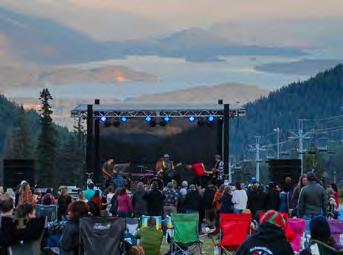

The Festival at Sandpoint’s 41st annual summer concert series at Memorial Field features great music under the stars! Gates for evening shows open at 6 p.m., and concerts begin at 7:30 p.m. unless stated otherwise. The Cheers Tasting Event before the Grand Finale requires a supplementary ticket. Get tickets, maps, and info online at www.FestivalatSandpoint.com.

Since releasing their debut album in 2010, Neon Trees have cemented themselves as a dynamic, engaging band who has consistently put in the work for over a decade. They’ve performed at major festivals and opened for genre-spanning artists, as well as headlined soldout tours of their own. The band has amassed one billion streams and recently logged over 40 million views on TikTok and continue to push boundaries.
july 31

Current CMA and ACM Duo of the year winner, Brothers Osborne’s working-class roots inform their leadership of progressive country music, making them the faces of the new generation of Nashville. Their Grammy award-winning “Younger Me” was inspired by TJ’s recent coming out. “It Ain’t My Fault” is a rollicking singalong and “Stay a Little Longer” has become a beloved fan favorite. Country with a touch of bluegrass and soul keeps the fans on their feet.

One of the brightest young luminaries in roots music today, Sierra Ferrell brings a dose of beautifully strange magic to everything she touches. Ferrell has enchanted audiences all over North America and Europe with her high-spirited and dazzling live performance. Ferrell’s eccentric musicality incorporates freewheeling bluegrass to heartrending oldtime music, to fantastically gritty honky-tonk and beyond.

Toad the Wet Sprocket will be joined by Semisonic, whose recent songs walk a tightrope between power pop muscle and acoustic intimacy, and the twotimes Grammy-nominated Sixpence None the Richer, whose hit song “Kiss Me” was RIAA certified 3-times platinum. Toad the Wet Sprocket is a beloved alternative Rock Band with hits like “Walk on the Ocean” and “Good Intentions.”

With well known hits like quadruple platinum “Carry on My Wayward Son,” triple platinum “Dust in the Wind,” and “Point of No Return” turned a Topeka garage band into Rock n’ Roll legends over five decades, with their latest album, 2020’s “The Absence of Presence” debuting at Billboard’s number 10. They are not just a staple of Classic Rock radio, their songs also feature in popular video games, live sports broadcasts, and commercials.

Dispatch with John Butler (with band) will be joined on the Festival stage by G. Love & Special Sauce and Donavon Frankenreiter. Dispatch forged their own path outside the mainstream music industry as one of the most successful artists in the roots rock scene. John Butler is known as the frontman of the John Butler Trio which had three albums that reached number one on Australian charts.

Since 1997, San Francisco’s Third Eye Blind has recorded five best-selling albums and assembled one career retrospective. Led by Stephan Jenkins, Third Eye Blind has earned worldwide success during a tumultuous group of years when the major-label recording industry was finally losing its grip on an enterprise that, for decades, it had dominated with steely efficiency. Nothing could have made Third Eye Blind happier!
august 3 grand finale

Jason Moody and the Festival at Sandpoint Orchestra, conducted by Morihiko Nakahara, will present the Sounds of Summer on the festival stage, including selections from Vivaldi, Dvořák, Gershwin and more. Each of these musical pieces evokes the warmth, energy, and emotions of summer in a unique way. The finale is a seated show and includes performances by the Festival at Sandpoint’s 2025 scholarship winners, capped off with a magical fireworks display.






by Ben Olson
Jens Weiden grew up in Sandpoint and graduated from Sandpoint High School in 1999. From his early days of playing baseball on Sandpoint fields to working his dream career as chief executive officer of the Rose Bowl Stadium in Pasadena, California, Weiden has kept true to his small town roots, which he claims helped inspire him to achieve everything in life.
Q: How did your childhood in Sandpoint prepare you for the outside world?
A: I still look at things through the lens of Sandpoint. I treat things as you would if you lived in a small town; you’re going to run into this person again, so don’t swindle or cheat them. I
was born in Sandpoint and lived out in Hoodoo across the Long Bridge, moving into town when I was 5 years old to our house on Lincoln Avenue.
My parents worked at Schweitzer and Mom ended up at the school district as a third and fourth grade teacher at FarminStidwell. My parents bought our place in town in 1983 when it was just a big, open horse field behind us, which is now a church and the Centennial Park at Travers.
Growing up in Sandpoint has helped me throughout my career, because you really rely on the relationships you make. There are cities in this country that are so big, you could literally not see someone you’re doing business with ever again. Sometimes that makes you feel you can do whatever you want,






but I’ve never had that feeling and that comes from growing up in a small town. In Sandpoint chances are whoever you meet probably knows your parents and family.
You’ve always been pretty close to sports in your life, right?
I started playing tee-ball on that field across from Dubs, then moved over to Travers and played majors, then at Memorial Field for American Legion and high school.
I was recruited to walk on at St. Mary’s College of California and played two years of baseball.
My mom actually gets a lot of credit for me going to St. Mary’s because I had a couple of scholarships to play at D2 colleges, but I got into St. Mary’s on a partial academic scholarship. She told me, “You’re going to go to the best school. I’ve seen you play baseball and you’re not going to play in the pros, so you’re getting






a good education.”
I got really good at shagging balls in the outfield as others were playing, then I stopped and started playing rugby for the last two years. Unlike most of my friends I graduated in four years because I had to pay for college. I have a degree in communications and a minor in English.
Where did you land after that?
I went into the golf industry right after college, worked for American Golf and managed some courses in the Bay Area. I did that for a few years until one of the guys I worked with went over to 24 Hour Fitness to their corporate office. A couple of years into that, I applied for a position to run the entertainment marketing for 24 Hour Fitness. There was a show then called “The Biggest Loser” and we’d put our branding on it, and if someone got kicked off the show we’d set them up with a trainer and feature them in commercials.
Then, mostly through networking, I got a call from a contact at the San Francisco Giants that I met through her sister who worked at 24 Hour Fitness. She said they had a new position in Giants Enterprises, which handled non-baseball events, like when they’d use the stadium for other things on non-game days. I interviewed and got the role there, spending eight years with the Giants. I left in 2013 and accepted a position as the chief revenue officer of the Rose Bowl stadium—they were trying to do what Giants Enterprises did by promoting more concerts, more corporate meetings, etc. We were very successful in doing that. About three years ago, the former CEO of the stadium retired and I got his job as CEO and now I oversee the entire organization.
I think one of the biggest things I’ve learned in my career is being likable is a strong personality trait. If you can be likable, it makes it much easier for people to work with you, trust you and give you responsibility. That’s an important factor.
Life is like one big high school. When you’re in high school



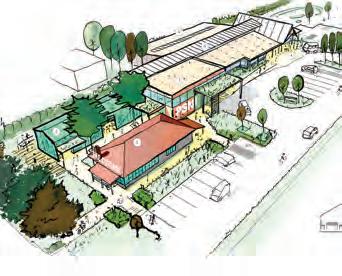
you know the people to go to to get things done. You’ve got to keep track of that.
What’s it like to return to Sandpoint whenever you get a chance to come back?
It has kept a lot of that small town feel. To me, one of the things that’s really unique is even though we’re a smaller town, because of where we are located a lot of kids were bused into school from a long way.
My kids were impressed at the size of my high school when they saw it. We had big classes. It’s like a college town in that you have all the elements of a town you need for it to function, but you have this vitality from younger people trying to learn what’s going on in the world. That combination keeps people young. Sandpoint was big enough that you didn’t have the same 20 people in your grade together. People went in and out of your universe.
That’s why I’m lucky to have gone to St. Mary’s; it’s a college, not a massive university, which would’ve made for a more difficult transition.
Tell me about running the Rose Bowl stadium. It’s one of the oldest, most highly regarded stadiums in sports. That must be something.
It’s 102 years old and one of the neat things about the Rose Bowl is that it’s evolved. It’s called the granddaddy of them all, but it’s a granddaddy with a smart phone who is super hip.
It was built for the Rose Bowl game, one game, but we now host about 25 events a year. Only seven of those events are football games. We host 10 festivals a year, five or six concerts for bands like Oasis, Coldplay, etc. We do soccer, too. It’s the most iconic soccer stadium in the country and we host international games annually.
It’s historic, but it’s a functioning thing that doesn’t feel obsolete. Aside from the concerts, music festivals and football games, we also do hundreds of others, like commercial shoots, plus runs and
walks for nonprofits to loop around the golf course and stadium to raise money for their charity group.
It’s owned by the city of Pasadena, which is a city of 150,000 people, and we can seat close to 90,000 in the stadium. That’s more than half of the entire city that can fit inside this one building.
It’s a community asset that’s owned by the people of Pasadena and we make it very approachable on non-major event days. I mean, close to 20,000 people show up just to attend the flea market here every month.
Did you ever think you’d be running the Rose Bowl stadium when you were a kid in Sandpoint?
No, it was never even on my radar. Growing up, when I was younger, I thought I’d play baseball my entire life. At St. Mary’s I started out freshman year taking high-level science classes because I thought I wanted to get into medicine. I got out of that, though, as much as I loved [SHS science teacher] Mr. Collins.
At one point I thought I wanted to work on TV, maybe behind the camera, so I took communications. Further on, I realized that wasn’t where I wanted to be, so I gravitated toward sports, the golf business, the Giants and 24 Hour Fitness.
It’s a pretty competitive business. A lot of people want to work in sports. For me, I tried a bit of a different path working for venues rather than teams. I was usually out representing the building, and that’s one thing I tell a lot of these kids doing information interviews: Find something that separates you. In sports, a hundred resumes come in to apply for everything, so try to find a way to differentiate yourself that might get you a chance to get an interview and impress them while telling them what you’re about.
Have there ever been any “pinch me” moments in your career, like meeting sports legends that you might have idolized as a kid?
There are a lot of super fans in this industry. For me, I’ve always tried to




remember that even if they are a pro athlete, they’re also people. You have a conversation with them versus treating them like they’re a god. For me, the ones I remember are the people who were the most grounded about it.
Ed Sheeran is a good example of this. Usually our artists turn our massive team locker rooms into a huge green room, but he took a smaller cheerleader room as his space and said, “No, this is fine for me.” He also wanted to meet the building staff and was very engaged.
That’s totally in line with how he became big. The story goes that early on he was at some jazz club in L.A. and he looked like he didn’t fit in. After the show he got called in by the promoter and found himself backstage talking to Jamie Foxx, the actor. He told Jamie that he was living in his car, and Foxx let him live at his house, told him he had pipes and that he was going to be great. Jamie Foxx treated him like a real person and you can see Ed Sheeran doing the same now that he is a superstar. Attitude is impor-

tant and positivity is contagious.
What was it like going through the 2025 fires down there?
It was pretty wild. Nuts. I usually get time off in January after the Rose Bowl game, but the fires broke when the paint was still on the field for the game. Our site turned into the command center for the Eton fires and we had 4,000 firefighters who lived here for a whole month.
This place turned into a city. We had camping and sleeping trailers, a doctor’s office, laundry services. It became a home for firefighters from all over the place: Lake Tahoe, Oregon, Washington state. It’s not what I expected out of January.
That’s one of the cool things about a municipally owned stadium. It’s an asset for the community. What we did that month maybe wasn’t our most iconic event, but it could have been one of our most important ones.
Where do you and your family live now? Were you close to the fires?


We live in Glendale now, a neighboring city to Pasadena. I live with my wife Raelene, who I met at St. Mary’s, my 12-year-old son Parker, and 9-yearold daughter Quincy, as well as Bowie the dog. We were in the warning zone for evacuation, but I told Raelene I had to stay at the stadium to help with the build out and response. She packed the emergency evacuation bag for me and took care of the family so I could stay at the stadium. So many people were impacted—10 percent of my staff lost their homes. It’s a heavy thing. These areas are war zones. The scale of destruction is insane. Full city blocks were destroyed and you likely won’t see the same people coming back into that neighborhood. It’s the equivalent of if a huge amount of Sandpoint burned, a lot of locals would just sell the land because they’re getting older and don’t want to spend the next four years of their lives rebuilding a house.
Looking back over your career thus far, do you credit anyone with helping you achieve what you have?
I give a ton of credit to my parents. They came to Sandpoint 45 years ago now from Utah and originally from Minnesota. They loved everything that was great about Sandpoint. They loved that it was a small town, but they also had a good outlook on how big the world is and how much is out there. They wanted me to go to the best school for me, not just where I could play the most baseball over the years.
My folks and my brother still live in Sandpoint when so many have moved out, which shows they have a huge appreciation for what is so magical about growing up in a small town with small town values.
I’m unbelievably lucky. The author Malcolm Gladwell talks a lot about opportunity, about how sometimes you’re born in a place and you’re very lucky. Bill Gates was very successful, but he also grew up within a mile of the only supercomputer the public could use which led to his success in computing. So I was very lucky to have grown up in Sandpoint in the time that I did. Really lucky to be able to go back to this place and it’s still held onto those really great traits it had while I was growing up.
There are things in life that have stayed the same, just like the Rose Bowl. One of the biggest advantages I’ve had in my life is the fact that I was born and raised in Sandpoint. I’ve tried never to leave that behind.




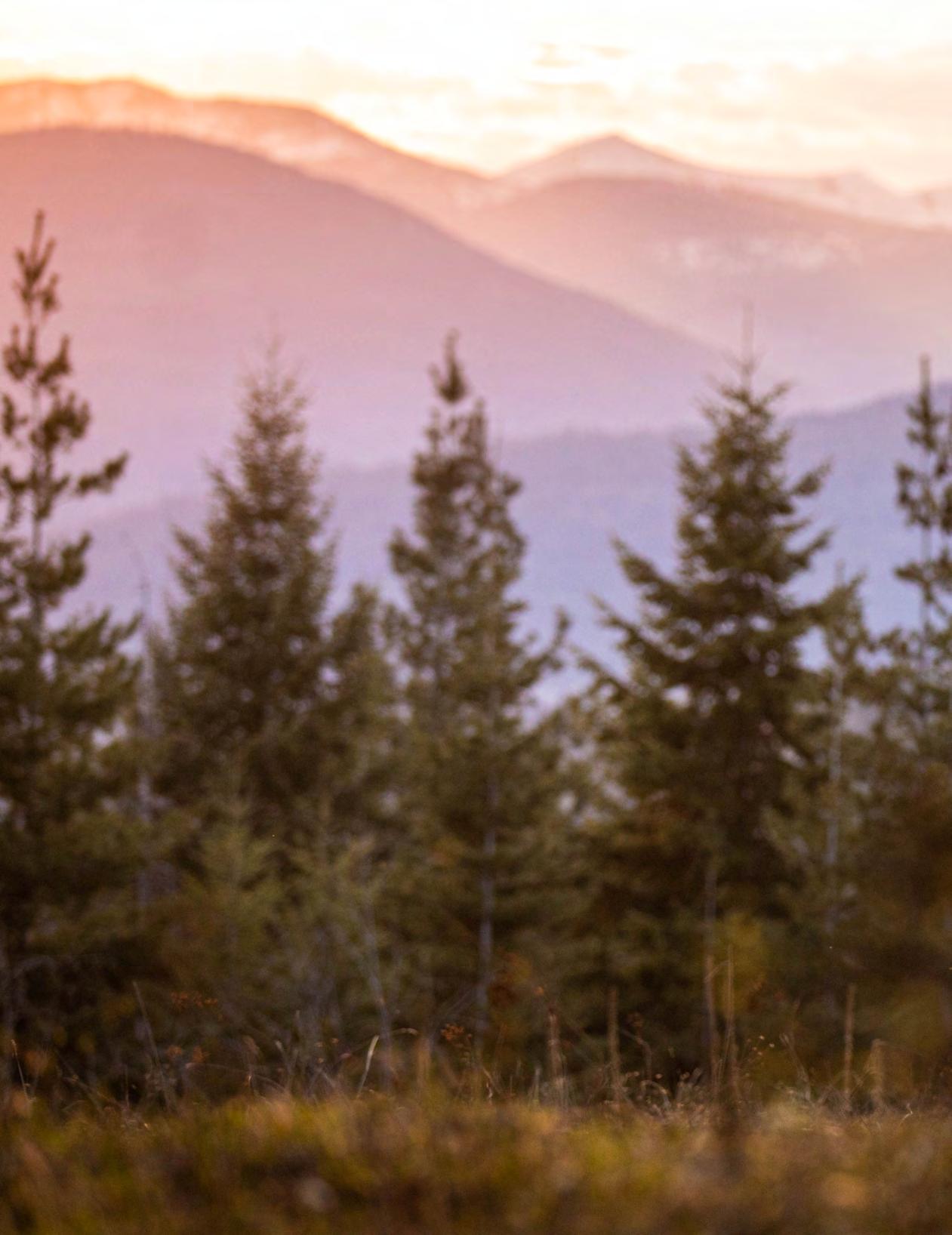
Outfitters offer equine experience for young and old
by Lyndsie Kiebert-Carey
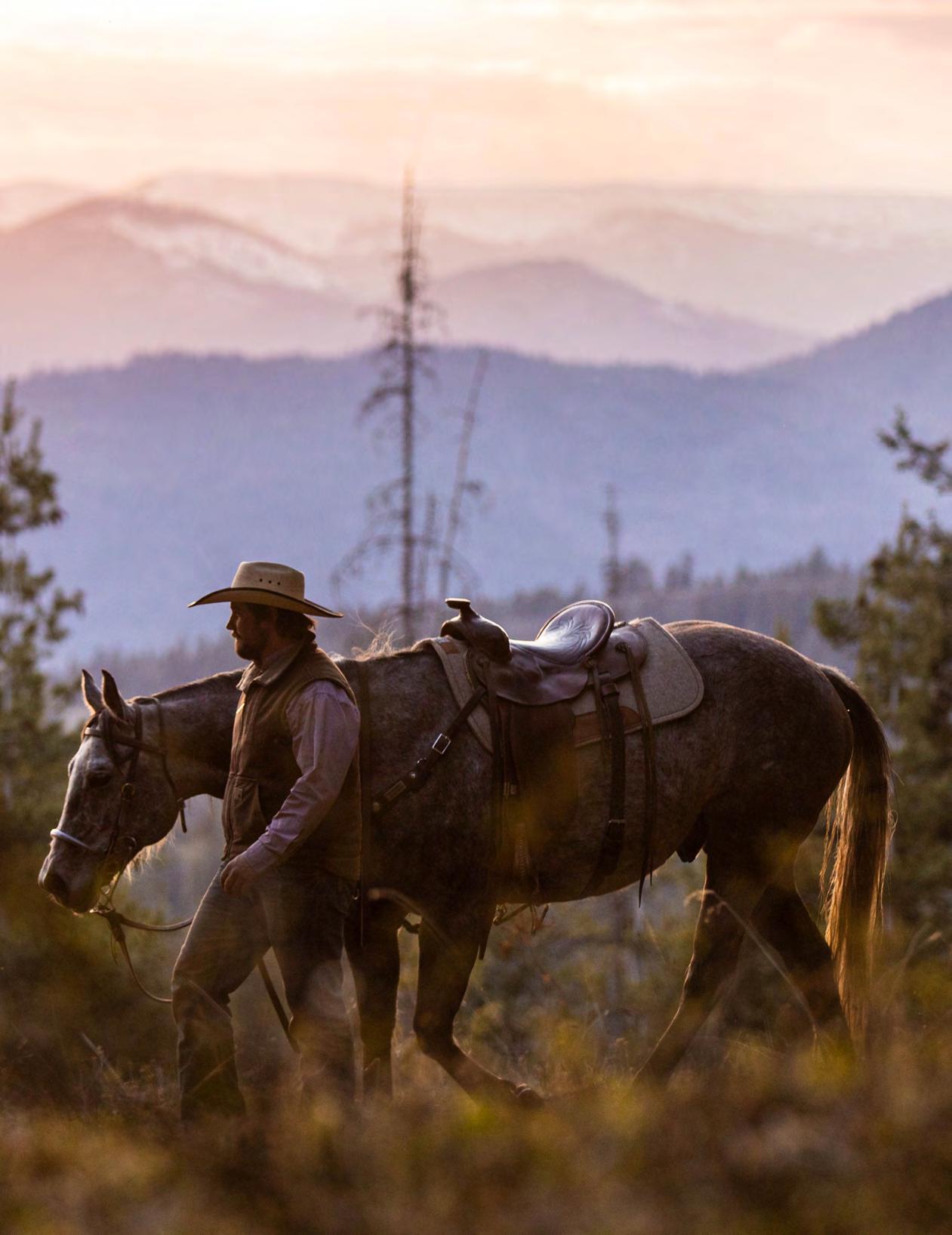
There’s unbridled joy in every North Idaho summer, but why not “stirrup” even more fun by shouting “yee-haw!” from the back of a friendly steed?
With Jennifer Harvey and her business, Adventure Pony Rides, aspiring equestrians of all ages and experience levels can encounter horses in an environment tailored to first-timers.
“The learning curve is fast,” Harvey said. “The only crying kids on my horses are the ones who don’t want to get off.”
Located 20 minutes northeast of Sandpoint (specific directions are given upon booking), Adventure Pony Rides has been in the business of introducing people to the joys of horsemanship for more than a decade—but Harvey, a self-described lover of animals, has been at it much longer.
The experience begins with all ages of children and adults grooming their mount, helping to saddle up, and being fitted with a helmet. Those old enough get steering instruction. Harvey then hand-leads each rider over two courses: the first allows riders to navigate their horse over logs and under branches, while the second has terrain changes culminating in a steeper, exciting hill climb.
Harvey’s main clientele are children, but that’s not to say the adults aren’t included in the experience. Harvey is sure to coach parents along the way, showing them the best spots to take photos, and provides shaded seating for any family members not up to hiking along with the riders.
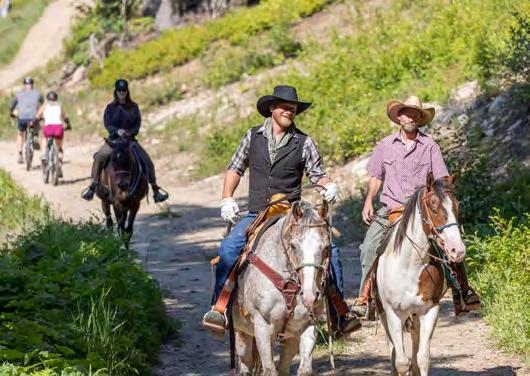


“People from all over the world visit Sandpoint and bring their kids to me,” she said. “Many come year after year. It’s great to watch them grow and offer them new riding experiences.”
On top of the opportunity to ride and brush ponies, Adventure Pony Rides is home to many friendly animals that riders can feed and interact with after their ride experience, including chickens, bunnies, guinea pigs, goats, a pig and more.
“Many people who do the hour ride experience stay for the petting zoo,” she said. “It’s very one-on-one, educational, and enjoyable for the whole family.”
(Learn more by calling 208-290-7423.)
Those hoping to gain a little altitude should seek out Mountain Horse Adventures, Schweitzer Mountain’s horseback riding outfitter. Owner Matt Smart has been at the reins for 18 years, but this business has been sharing panoramic scenery from the saddle for nearly three decades.
Mountain Horse Adventures’ corrals are located at the far side of Schweitzer’s village, past the last chairlift. From there, riders aged 10 and up will explore the mountain’s wide trails (used in the winter for cross-country skiing) and be treated to lake views, wildlife sightings and alpine meadows dotted with wildflowers.
Outings can be done in groups or in a more private setting, given adequate notice while reserving your ride over the phone or online.
Through it all, Smart said he couldn’t do it without Mountain Horse Adventures’ most steadfast employees—those of the equine variety, of course.
“They’re the most consistent staff,” Smart said of his horses.
As for anyone who might be skeptical that their horsemanship is up to the challenge of exploring Schweitzer, Smart said there’s an equestrian companion for any skill level at Mountain Horse Adventures, “from the timid to the experienced horseperson.
“We have a horse for you,” he said. “We hand-select a horse for every person. They are great at dealing with new people.”
(Learn more at www.mountainhorseadventures.com.)
Another option for those seeking a taste of the ranch hand lifestyle could be a stay at Western Pleasure Guest Ranch, where an all-inclusive ranch stay includes horseback riding— rain or shine, thanks to a 70-by-150-foot indoor arena.
But when the weather allows, guests can choose from a wide variety of guided rides through the Cabinet Mountain foothills, including a day ride to Grouse Creek Falls to swim. Western Pleasure also offers the chance for aspiring cowboys to try their hand at moving cattle on this working ranch with a four-generation history at the site.
Apart from the all-inclusive stay experience, Western Pleasure owner Janice Schoonover said the ranch offers two-hour rides in the months of May and October ideal for locals (or even visitors) looking for an opportunity to view the Selle Valley on horseback.
Learn more at www.westernpleasureranch.com.



We’re not just in the community—we’re part of it. We have team members with decades of experience who live and work right here in Sandpoint. We’re deeply invested in the success of the city, supporting local organizations and sponsoring events.
Whether you’re streaming, working remotely or connecting with family, Ziply Fiber brings the reliable service and local support you deserve.
New customers can get fast fiber internet starting as low as $20 a month.
Start experiencing neighbor-powered fiber internet today.

by Pam Webb
One suggested way to start a Sandpoint summer Saturday is a stop at the Farmers’ Market. Located in Farmin Park, the market provides an array of fresh garden produce, unique crafts and delectable treats to peruse and purchase along with the opportunity to listen to lively local music.
Up until the late ’80s Sandpoint did not have an official farmers’ market. In 1988, Lois Wythe, owner of the Peaceable Kingdom, posed this question in a distributed flyer: “Would you
like to put your garden to work?” An initial meeting brought together nearly 60 people interested in forming a farmers’ market. The city of Sandpoint allotted Farmin Park as the site and a local market formed with several vendors and a handful of volunteers to run it.
Now in its 37th year, the market has grown. It has a fulltime manager and operates with an 11-member board. Olivia Gonzales, newly hired as the manager, is expecting as many as 100 vendors this year. A nonprofit, community-based organiza-
tion, the Farmers’ Market at Sandpoint believes in supporting local agriculture through education and a diverse community market which it adroitly achieves through its assorted programs and variety of vendors.
Over time growing pains necessitated adding on more vendor space. Today, adjacent Oak Street is blocked off for more selling area, with the fountain area being utilized. Unlike some farmers’ markets there is no resale allowed. The
market is 100 percent vendor grown and made, and the owner must be present at the booth.
Beyond shopping for locally grown produce, there are also delicious goodies from gluten-free scones to goat cheese to tempt a person. Crafts are also a large part of the market. An abundance of creative wares are available from signs proclaiming “You're on Lake Time Now!” to cozy hand-knitted scarves and hats. There’s face painting, chair massages
and henna tattoos. During market hours lively local music streams from the bandstand, serenading shoppers and talkers, creating a bright, enjoyable atmosphere.
The market is a community event and socializing is par for the course. In fact, it's a given to see friends and neighbors while browsing the stalls. Chatting is part of the agenda. Just pull aside and shoot the breeze. In fact, step over onto the central, grassy knoll to enjoy a full chin-wag, mindful of the score of children romping about as parents chat while music flows from the bandstand.

Enjoy the reliability and resources of a big bank, with the care and commitment of one that knows your neighborhood and needs. Our local lenders are here to help you navigate the numbers and sort through solutions to pursue the proper financing for your future.


While vendors tend to come and go there are a few who are longtime sellers. One such vendor is Kim Spencer, who has been selling a variety of wares since 1990. “I began with baskets and made bread; that is before gluten became a bad guy. I would make 110 loaves of bread Friday for the Saturday market.” Spencer’s success inspired others to sell baked goods so she moved on to different commodities such as soap, and her popular and colorful dreadlock hair accessories. The dreads are made out of spun wool and attach like a ponytail. They were originally created to complete Kim’s belly dancing outfit. So far no one else has replicated this unique item.
Having been part of the Farmers’ Market scene for so long, Spencer has seen several changes. “As the market grew so did the necessity for rules. There is now a paid manager, and the market has added the street as well as the fountain area for vendors.”
Emily Levine, owner of Red Wheelbarrow Produce and veteran market vendor, strongly supports the importance of a farmers’ market, having served on the board for 19 years in a variety of positions. She emphasizes how the community gathers together, especially enjoying the live music. “Folks gather and dance and sing and it's just a lovely scene.”
Levine noted there will be special events offered this year such as a Kids’ Day in late August, and monthly “Taste of the Market” cooking demonstrations
with local chef Alana Eckhart, along with activities provided by the Bonner County Extension Office and the East Bonner County Library.
The Saturday session is busy from the moment the opening bell rings at 9 a.m. until the market closes at 1 p.m. There is also an additional midweek market on Wednesdays from 3 p.m. to 5:30 p.m., also at Farmin Park. The last day of the Farmers’ Market is October 18, designated as HarvestFest. There will be extended hours, raffles and activities.
Each year as Sandpoint’s Farmers’ Market grows so does its agenda to make it even better. Looking to the future, manager Olivia Gonzales said the board is looking at larger locations, opening a winter market, and even considering whether the market could operate yearround.
Learn more at www.sandpointfarmersmarket.com.
• Leave dogs at home. (It’s posted).
• Bring cash. (Not everyone takes cards or checks.)
• Keep a cooler handy for perishables.
• Provide your own bag as a courtesy and a convenience.
• Consider a folding chair to make listening to the music more comfortable.

































by Cate Huisman
In the midst of national discord about seemingly everything, we are fortunate to have among us a group of disparate North Idaho voices working instead to harmonize. For more than 15 years, the Panhandle Forest Collaborative has been meeting to come to consensus on how best to manage the national forest lands in our midst.
The PFC was founded in 2009 by a group of individuals with widely diverging interests in the Idaho Panhandle National Forests. They included everyone from logging company executives and national forest staff to ATV riders, backcountry skiers, conservationists and wilderness enthusiasts.
Although the timber wars had eased by this time, the founders felt that too many issues on our national forests were still decided through litigation—a lengthy and expensive process for all concerned. Instead, they worked to get everyone together
who might have an interest in a proposed forest project, in order to share concerns and priorities.
Although the U.S. Forest Service was initially a little reluctant to work with the PFC, it has come to value the group’s input. “Trust is critical,” said Brad Smith, conservation director with the Idaho Conservation League and one of the founders of the PFC. Other members in the group have grown to value the process more as well. “Everybody’s seeing better outcomes,” said Smith.
Forest projects involve not only timber harvest and thinning, but might also include trail or campground improvements, or enhancements of habitat for fish and wildlife. All proposed projects must be reviewed as required by the National Environmental Policy Act; this includes public input and environmental analysis. At the end of this process, the USFS makes a decision
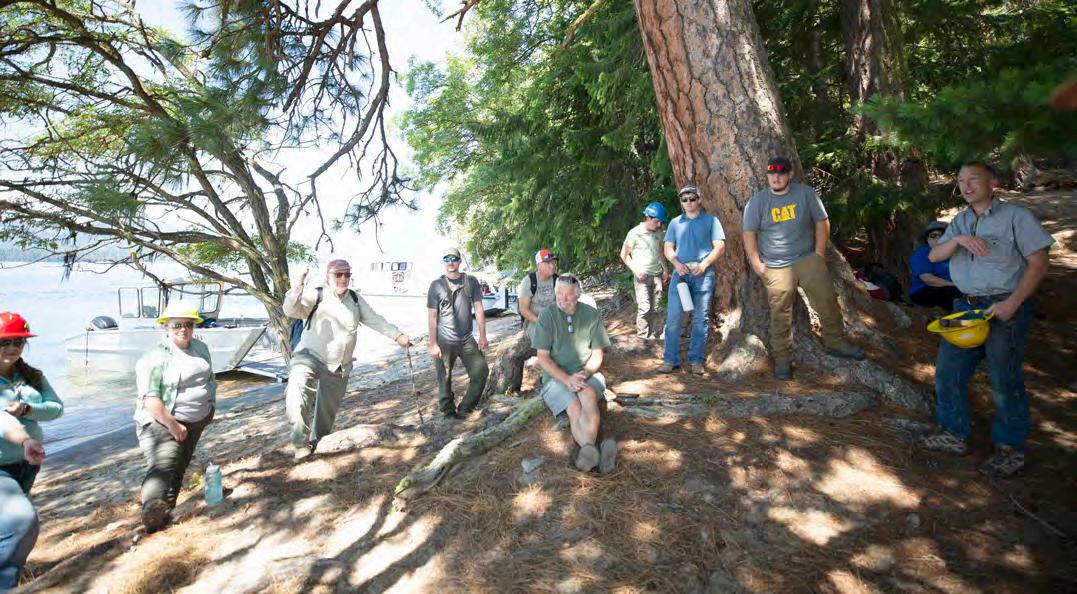
about how to proceed with a project. At that point, people still unhappy with the project can file an objection.
The PFC aims to make sure that all interested parties are included in this process. It reviews proposed projects on the Sandpoint and Priest Lake ranger districts as well as some projects on the Coeur d’Alene ranger district. “Our goal is to have full consensus, so we can avoid the objections process,” said Smith. The wide variety of stakeholders in the group helps make sure that all viewpoints are considered.
An example is the Bottom Canyon project on the Coeur d’Alene Ranger District. PFC members from the conservation community worked with the USFS to reroute some roads in the project to reduce the amount of sediment entering a creek, thus protecting fish habitat. Members from the motorized recreation community helped make sure that their opportunities for recreation were maintained as the roads were rerouted.
The Buckskin Saddle project is currently underway across the lake on the back side of the Monarchs. Over the next
ten years, motorized recreationists will notice that some of their trails have similarly been rerouted to protect fish habitat. And boaters at Kilroy Bay and Granite Creek may notice some thinning of the forests above them, meant to reduce fuels that could feed fires.
It is encouraging to note that the PFC is not alone in taking this cooperative approach to forest management. A comparable collaborative, the Kootenai Valley Resource Initiative, reviews projects on the Bonners Ferry RD, and the Shoshone Benewah Forest Collaborative reviews projects further south in those two counties. In fact, collaboratives like the PFC have come to be common in neighboring states and across the West as well, although not every national forest has them.

ments to their bylaws or consider new goals? The group has recently formed a grizzly bear committee to look at ways to limit conflicts as grizzlies recover and the human population grows. As more users move to our area and recreate in the IPNF, should they focus more on recreation?
The PFC is currently in the midst of one of its periodic internal reviews. “We are trying to decide whether we should do anything differently,” said Smith. Should there be changes in their goals and objectives? Should they make adjust-
The next few months may see some tweaking of the process, or they may add to it or refocus it. But they won’t abandon it, and that’s good to know. With our treasured national forest lands at stake, we don’t want to lose a single tree to the expensive process of arguing.
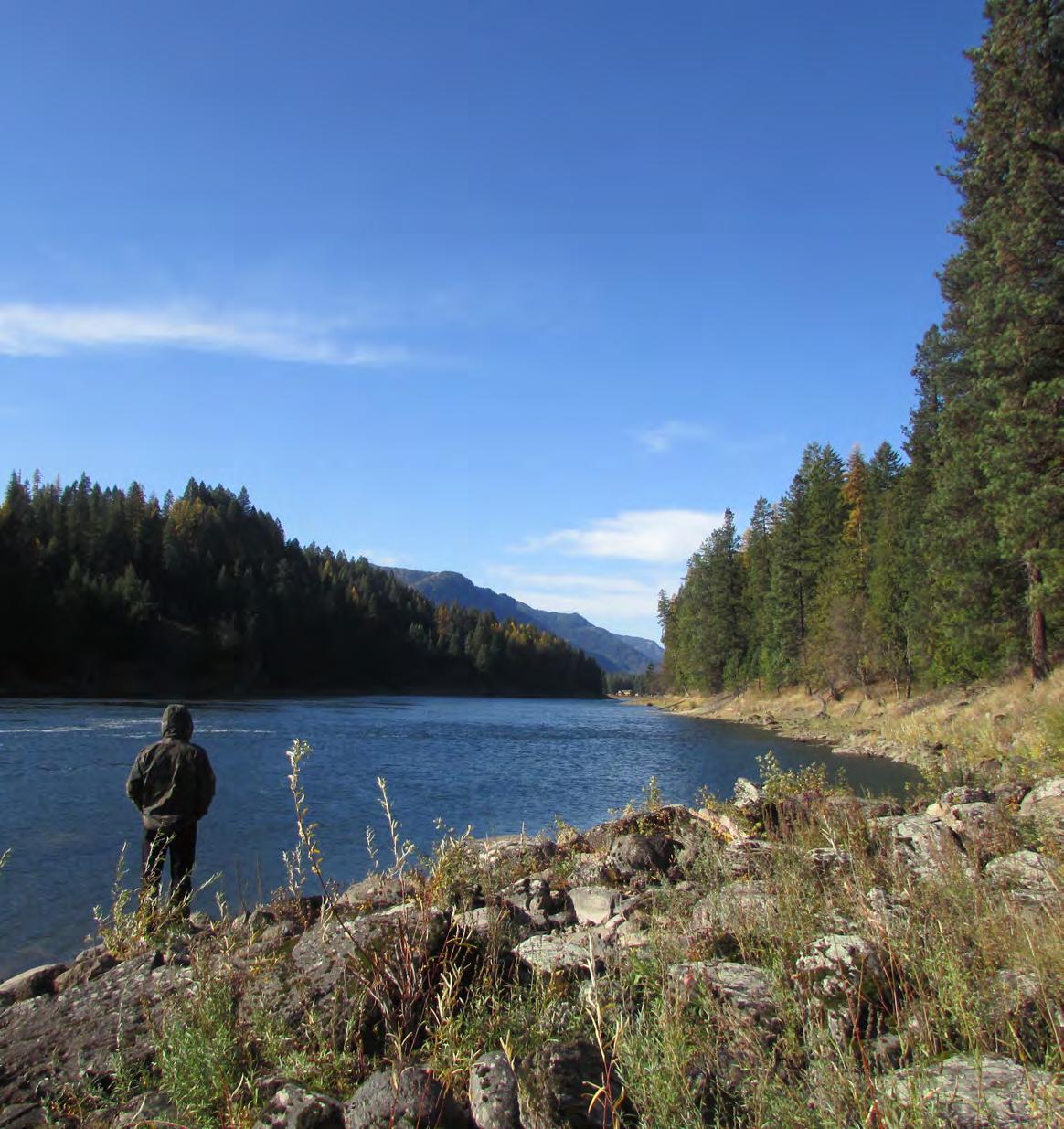


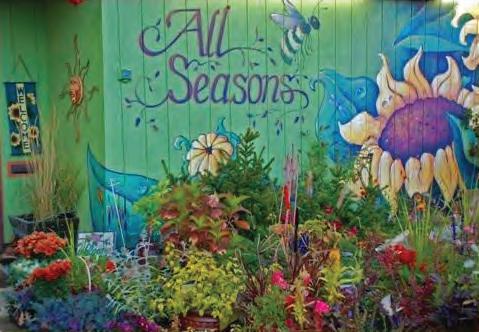



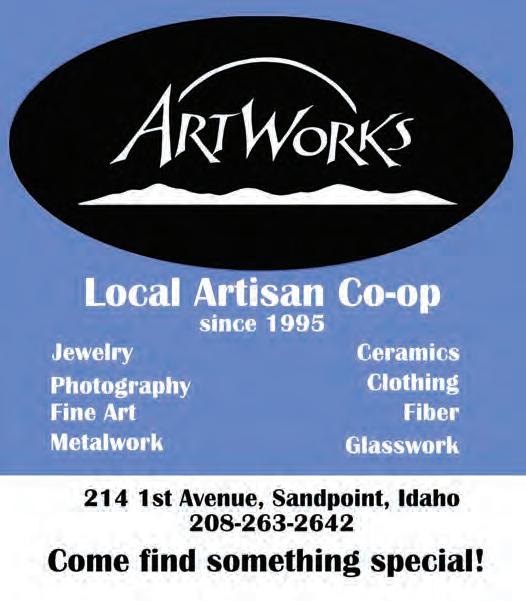




Ole Jennestad, a prominent figure in early Sandpoint, embodied the American immigrant success story. Born in Norway in 1886 to a father who worked as a tailor and small farmer, Jennestad's childhood shaped his future business acumen and work ethic.
As a teenager, he gained valuable experience working in a general store for approximately 18 months. This position, combined with the knowledge of clothing he likely absorbed from his tailor father, laid the groundwork for his future career in the clothing industry.
In 1901, just 15 years old, Jennestad made the bold decision to immigrate to America, settling initially in Mason, Wisconsin, on the advice of a Norwegian pastor friend. He supported himself through physically demanding work in the lumber and railroad industries, developing the resilience that would later serve him well as a business owner.
Jennestad moved westward, first to Bellingham, Washington in 1904, then to Sandpoint in 1905. Upon arrival in Sandpoint, he hired on at the Humbird Lumber Company, but logger life didn’t appeal to him the way the clothing trade did.
In 1908, he made the pivotal decision to open his first haberdashery, The Viking, at 410 N. Third Avenue. He entered this venture with partners Antone Haughness and Rangvold Larson, as well as Rangvold's cousin, Chris. The business underwent an early change when Chris bought out Antone's interest, establishing the partnership known as Jennestad and Larson. The clothing store relocated several times during its history. From Third Avenue it moved to First Avenue, initially occupying the building where the Pastime (now home to The Hive) would later be located. A 1912 fire forced a temporary relocation across the street, before the business settled at 317 N. First

in 1920.
Also in 1912, Ole married Hannah Carlson. Their marriage would last 58 years until her death in 1970. Recently, the Bonner County History Museum was privileged to receive a collection of letters Ole wrote to Hannah before their marriage, while she was working in Spokane. Store employees might remember him as a stern taskmaster, but these letters reveal his softer side. The couple raised two daughters, Helen and Edith. Edith remained in Sandpoint and worked alongside her father in the store for many years.
Jennestad was known for his innovative approach to business. Recognizing the needs of the local logging community, he would travel, by foot and by ski, to logging camps during winter months, armed with fabric samples, measuring tape and an order book. This service allowed loggers to have suits ready upon their arrival in town come spring.
The Jennestad-Larson partnership thrived for over three decades until 1940, when Ole purchased Chris' share of the business. Chris subsequently partnered with his brother, Thor, to form Larson’s, located just a few doors north of Jennestad’s.
During World War II, Jennestad expanded his tailoring services to include measuring and ordering officers' uniforms for nearby Farragut Naval Training Station. In 1952 the store added women’s apparel.
Beyond his business endeavors, Jennestad was active in community organizations, including the First Lutheran Church, the Masons, the Elks and the Sons of Norway. He worked in the store until age 94. He died in 1981, and the store was sold in 1982. His life and career exemplified the entrepreneurial spirit and community engagement that helped build Sandpoint in the early twentieth century.
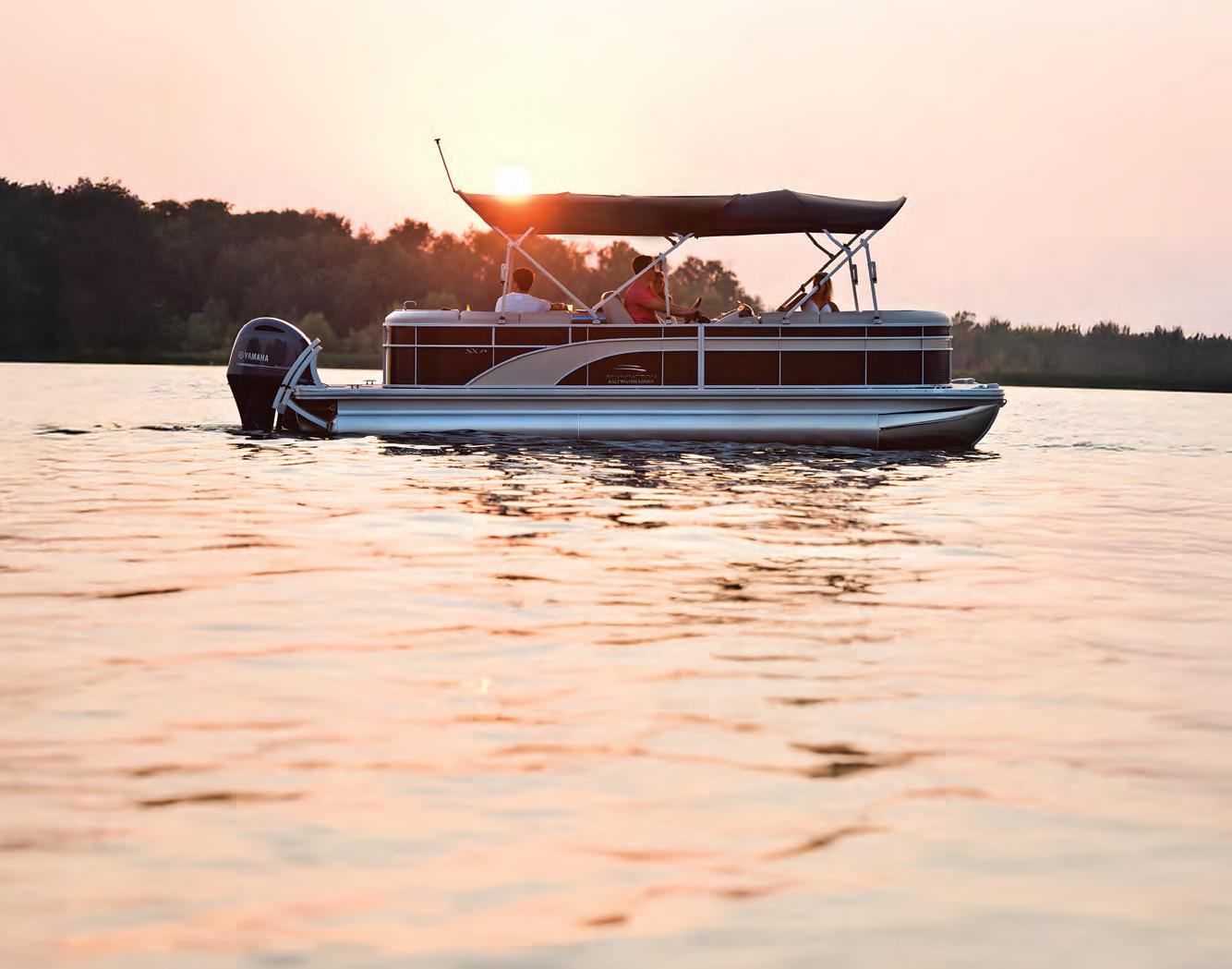

Get ready for a boat-load of fun on Lake Pend Oreille! We offer top-quality pontoon rentals at great prices with easy, 24/7 online booking—no waiting, no hassle. Launching from Long Bridge Marina in Sandpoint, we’re here to help you enjoy North Idaho to the fullest!
Discover the ultimate blend of luxury, safety, and sustainability on the water with Spacruzzi— handcrafted electric spa boats featuring a USCG-compliant heater, eco-friendly sanitization, and virtually tip-proof stability for the perfect, worry-free escape.

by Rick Price
We see them every summer, starting in early June and lasting through fall, riding bicycles loaded down with saddlebags full of gear on the front and back and, noticeably, often smiling. About a dozen a week by some estimates, they pass through town. We wonder, “Who are they? And where are they going?”
These are bicycle tourists. While some are heading north to Canada, or to points south, many are traveling U.S. Bike Route 10. Route 10 is an east-west route that reaches across the country. The western point of this route is in Anacortes, Washington and it continues to the Atlantic Ocean in Bar Harbor, Maine.
Touring cyclists call this ride the Northern Tier. In Idaho it runs for 66 miles, all in Bonner County, from Oldtown, through Sandpoint, and on to Montana. The main route follows Highways 2 and 200 across the Panhandle to Clark Fork, before
leaving the highway to join up with River Road on the south side of the river. This allows bicyclists to avoid the section of Highway 200 where there is no shoulder, and a steep drop into the water. Riders will travel through Heron, Montana before heading up the Bull River and on to points east.
Many riders follow alternative routes to get off the busy highways. Alternatives include heading south from Oldtown to Old Priest River Road, where riders then continue on Dufort Road to Highway 95 and the Sagle bike path, or take Lakeshore Drive into town. Riders then hop on the Sand Creek Trail. This trail gets bikers to Kootenai Cutoff, before jumping on Highway 200. These descriptions are all for eastbound riders, though riders go both ways on this route.
Natasha Buffo and Dan Deemer are a couple from Lake Tahoe, California. They traveled the Northern Tier route in the summer of 2024 on a trip from the West Coast to Glacier National Park. They remember their two days in Idaho fondly,



following along the Pend Oreille River, Lake Pend Oreille and the Clark Fork River. Many locals comment about how crossing the Long Bridge transformed their lives. Imagine experiencing it, for the first time ever, on a bicycle. Natasha said, “The Long Bridge crossing was a highlight of the entire tour. Riding with that wide path, with no cars, we were carefree and without fear as we soaked in the view on a beautiful morning. It was so rare and so special. It felt like a big welcome coming into Sandpoint.”
Bike tourists often camp along the route. Some, traveling lighter, stay in hotels. Many use an organization called Warm Showers to find hosts to put them up for a night or two. Warm Showers is a worldwide collaborative that matches bicycle tourists with willing hosts like Airbnb. The difference is that it is free.
Sandpoint’s Steve and Judy York are among a handful of Warm Showers hosts who often welcome touring cyclists. As cyclists themselves, they like helping other bikers. They have hosted about a dozen touring cyclists each year for the last five years. They say they love the variety of people who encompass “all ages, from all over the world,” said Judy. “Last year we had a guy from Spain who started riding in Argentina a year and a half earlier. He was riding to Alaska.”
For eastbound riders Sandpoint is the first bigger town after leaving the West Coast and the grueling passes of the Cascades, a week or so of riding for most. Bicycle tourists often take a rest day to enjoy town, gear up for the rest of the trip and get their bikes tuned at local shops. They take time to do laundry and enjoy a good restaurant meal. Steve mentioned, “Sandpoint could use more hosts as camping is so limited close to town.”
Touring cyclists ride because they like the pace and the chance to really immerse themselves in the countryside they are traveling through. Natasha from Tahoe mentioned a few parts of this route were, “gorgeous, but uncomfortable,” particularly Highway 200, where parts have no shoulder.
“Cars passing closely is really scary for bikers,” she said. “That one moment, where a car passes too closely, can shake you to your core, stick with you all day and maybe even weeks and years to come. It can make a cyclist not want to get back on the bike. And unfortunately, lives have been lost. But the effort it takes for a car to move over three feet, or more, is minuscule to the driver. Aim to be the driver that cyclists wave at and thank.”
It’s free to be a host with Warm Showers. Learn more about the route at www.adventure cycling.org, and about becoming a host at www.warmshowers.org
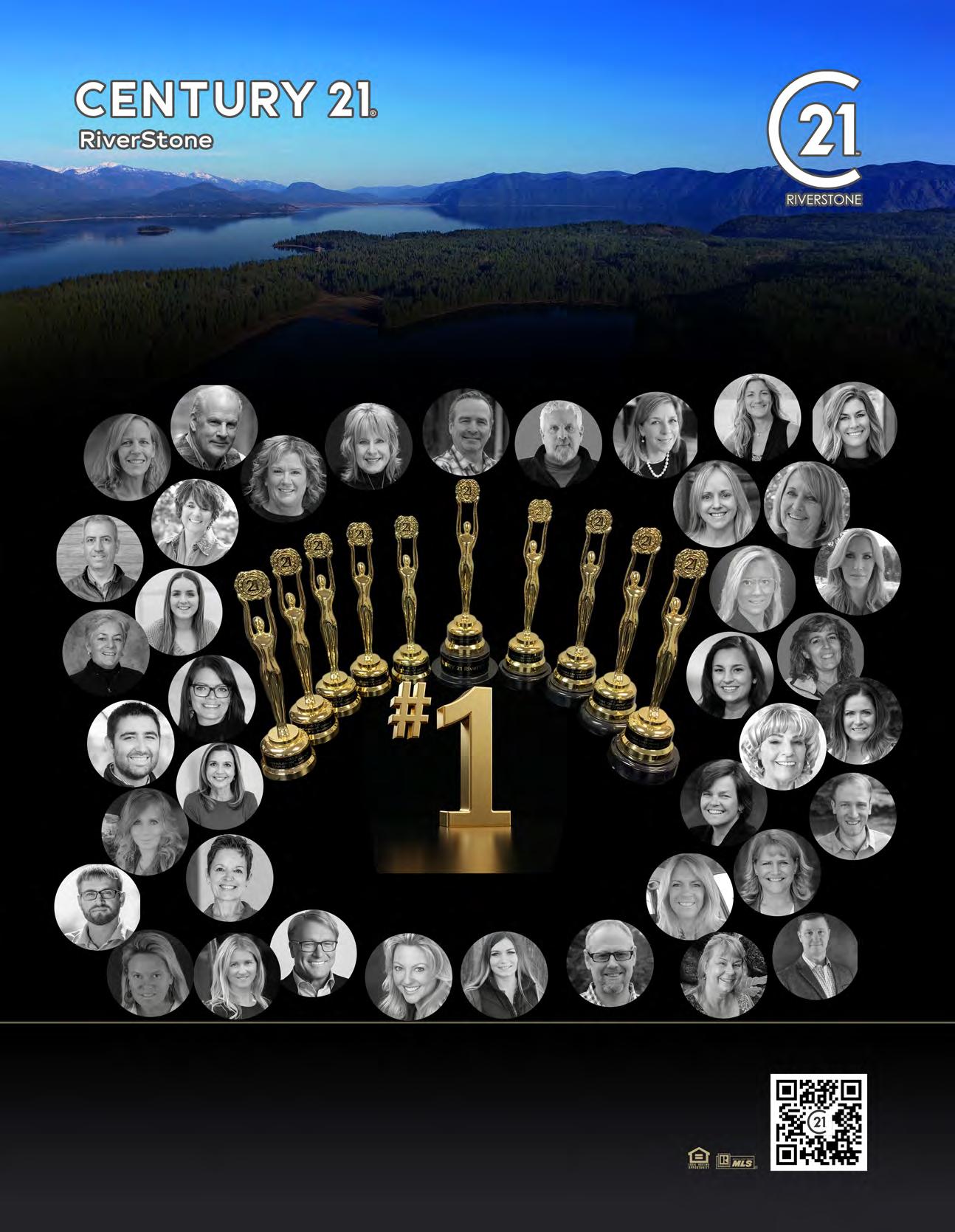



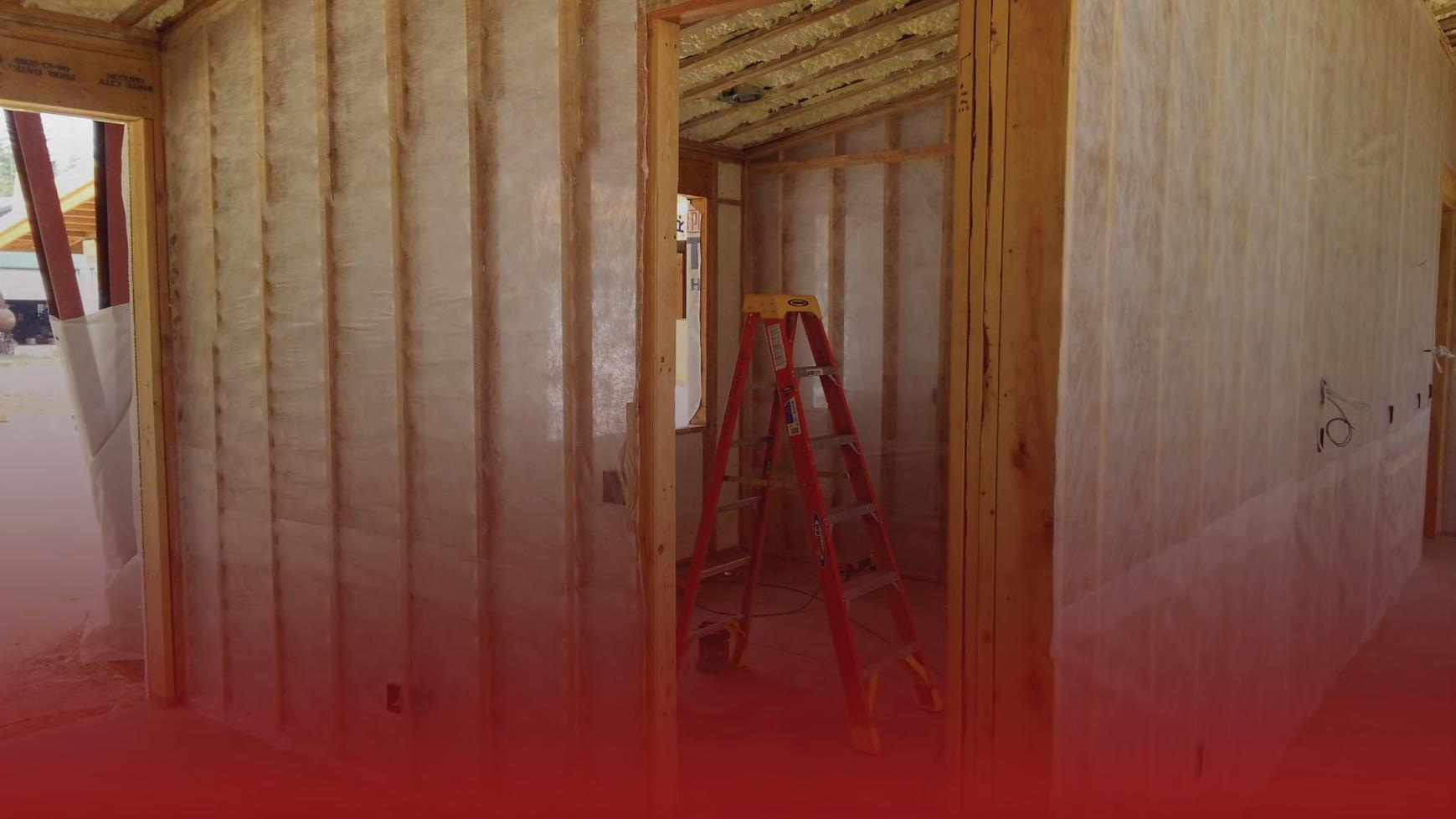





you
by Hannah Combs
You may have noticed it on a Sunday drive… crossing the railroad tracks on Gooby Road, the state’s largest black cottonwood tree to your right; to the left, a tawny brick building set against yellow willows. Two stories of black windows gape toward the road. Most distinctly, the east end of the building is, well, missing. A jagged stack of bricks reaches for the sky, with nothing for it to hold onto.
I’ve heard dramatic rumors over the years, most involving nefarious explosive accidents, to justify its bombed out appearance. People are keen to find explanations (sometimes outlandish) for the mysteries around us—and that’s where history comes in to set the record straight.
In 1907, 30 years before Social Security taxes were first collected, Bonner County’s newly installed commissioners were tasked with the care of elderly, destitute and disabled citizens. Though many depended upon family members for support and housing, there were always people who didn’t have relatives nearby and for one reason or another fell through the cracks.
At the time, W.G. Hunt was operating one of the county’s three successful brickyards on the west side of town. A 40-foot-deep clay deposit near the Great Northern railroad depot provided booming business for a few years, but by 1910, Hunt faced foreclosure and was forced to sell his business, effects and property to satisfy his mortgage debts.




The county bought the 24-acre property, situated on the south side of what is now Gooby Road. Using leftover bricks from the factory, they added on to the Hunt family’s brick home, making it three times as large. The land and brick home were deemed ideal for a “poor farm” able to accommodate up to 25 mostly elderly men.
The farm employed a caretaker couple, as well as a kitchen helper and farm hand, who were usually teenagers in need of foster care. They cleared the land, planted an orchard, and established dairy cows, chickens and other livestock to sustain the operations. Men came to the farm at different ages and from different backgrounds, though many had done hard physical labor on the railroads or lumber camps and walked away with wrecked bodies or traumatic brain injuries. If able, residents helped with chores on the farm. The caretakers lived in the former Hunt residence, while residents lived bunk-style in the new addition.
Charles and Alice Albertson supervised the farm for the last 20 years it was in operation. The Gooby family bought the property north of the farm in 1942, and Pat Gooby shared his first memory of playing with cousins on the Poor Farm property. Shortly after, at the age of four, Gooby’s father, thinking his three boys didn’t have enough to keep them busy between the morning and evening milkings on their dairy farm, sent them to the Albertsons to lend a hand. Pat helped out at the farm for the next ten years, until it was shut down.
Splitting wood for the kitchen stove was often handled by hobos in exchange for a meal. Gooby remembered a hobo once telling him the Poor Farm was known as a friendly stop among freight hoppers as far away as Florida.
Everyone, including the Albertsons’ grandson, Jim Peterson, fondly remembered holidays at the farm. "I miss those bygone Christmas mornings when Grandad and I went from room to room delivering presents. It never occurred to me that someone had to pay for those gifts. In later years, I learned that my grandfather had worked out an elaborate bartering scheme involving local merchants, charities, and sides of beef and pork he traded for trousers, gloves, shirts, socks and coats to keep out the cold. Simple gifts from the heart.
"After [dinner], we would gather in the parlor for stories and memories of young men filled with hope who worked their way west building the railroads that bridged America. I have such admiration for them—these young men grown old. They were my heroes; in some ways they still are.”
By 1959, with new costly regulations in place, the Poor Farm shut down in favor of better-equipped rest home facilities. The Gooby family purchased the land and the old brick building that had served the poor for five decades.
As for the missing walls? In a practical and economical move reminiscent of how the Poor Farm operated, the bricks were carefully deconstructed to build another home nearby.
Connect to more local history at www.bonnercountyhistory.org


















Hop on the world’s longest free ferry, breathe in that fresh mountain air, and discover the hidden gems of the Kootenay Lake region. From the quiet charm of Balfour to the creative corners of the East Shore, this is your invitation to explore winding lakeside roads, artisan studios, cozy cafes, scenic golf resorts, and crystal-clear waters.



New bookmobile van provides a ‘roving library’
by Susan Drinkard
The colorful Mercedes Sprinter bookmobile you see parked at different locales around eastern Bonner County with its whimsical wildlife artwork is a roving treasure to hundreds of people who appreciate its ease of use and proximity to their homes.
The East Bonner County Library outreach effort seeks to get books, DVDs and more into the hands, minds and hearts of children who attend private schools, to parents who don’t live close to the library who are making serious efforts to home school their children, and for older residents who can’t readily get to town. To achieve this, the bookmobile is a critical service. But the library on wheels is not just for targeted populations; it’s for anyone with a library card.
People who live in remote areas like Vay, or up Rapid Lightning Road, or closer in at Laclede, and now even Ponderay (11:30 to 12:30 p.m. Fridays at the Rusty Trunk) and Dover (at the new post office, 11:30 p.m. to 12:30 p.m. Mondays) don’t have to drive to Sandpoint to return materials.
Ben Olson of the Sandpoint Reader delivers the newspaper every Thursday to the bookmobile before it takes off for the day. “There are so many people in Hope who come just for the Reader,” said Michelle Shorman, who is the principal operator and driver.
It is amazing how many people fit into the bookmobile, she said. “My favorite days are in the summers when I will have 70 to 100 people—kids, parents, grandparents—perusing through

• General & Family Dentistry
• Restorative Dentistry
• Cosmetic Dentistry
• Implants/Tooth Replacements
• Dental Emergency Care
• Oral Surgery



the books during the day when I am parked at the Farmers’ Market. They may not check any books out, but the kids get so excited just being on the bookmobile.”
Shorman said the vehicle itself is not hard to drive, unlike the former bookmobile that was so big it was scary to try to pull out onto the highway from Dufort Road and then to accelerate fast enough, “as the wind whips you.” The Sprinter, an all-wheel drive vehicle, replaced the former Bluebird 26-footer in 2022.
Shorman restocks the shelves, handles requests for books and cleans the vehicle. It’s not just a job to her; it’s also about the many relationships she’s made over the years with her regulars.
“We have a family of four boys who are home-schooled, and it seems like a highlight for them to come to the bookmobile,” she said. They made an origami crane for her and one of the boys gave her a sticker of a truck he liked many years ago, so she put them on display. Now he is seven years older and has purchased the model in the sticker and drove it to her stop to show it to her.
Another driver of the books on wheels is Manny Rose, aka “library dude” by teens in the community. Rose drives the roving library two days a week. On Thursday mornings, service alternates weekly between the Kids Castle in Kootenai and Selle Valley Carden School, followed by an afternoon stop at Old Hope School in Hope (parked in front of the market building). Friday mornings, you’ll find Manny and the bookmobile in the parking lot of the Rusty Trunk in

Ponderay. He’s been told he doesn’t look like the librarian type. “If the CIA finds out I’m here, I’ll have to be relocated,” he joked.
Rose goes to one private school where the children gather in the mobile library with their teacher to check out books for school projects. “Some of the kids don’t have library cards. I encourage them to get a card because it builds responsibility.”
Rose is looking forward to the arrival of “Bob,” a dancing inflatable with a big smiley face the library is purchasing to attract attention to the bookmobile.
“Our statistical report from the end of the last fiscal year, September 30, 2024… we circulated almost 10,000 items on the bookmobile with slightly over 3,500 visitors,” said Vanessa Velez, library director. Librarians would like to see visitation numbers increase, especially at the new stops.
Boundary line changes between East and West Bonner library districts went into effect in January, said Amy Flint, chair of the library’s board of trustees, “but the fiscal impact will not begin until our next budget year starting in October. That will eliminate several of our stops that fall within the new boundary, such as Vay and Laclede. The additional stops being added lately are, in part, in anticipation of eliminating (those) stops, as well as expanding bookmobile services,” she said, noting that these adjustments follow the library district lines’ recent changes.
Patrons and organizations may request the bookmobile at an event if scheduled a few weeks in advance.
The schedule for the bookmobile can be found online on the library’s website at www. ebonnerlibrary.org
We have a family of four boys who are home-schooled, and it seems like a highlight for them to come to the bookmobile “


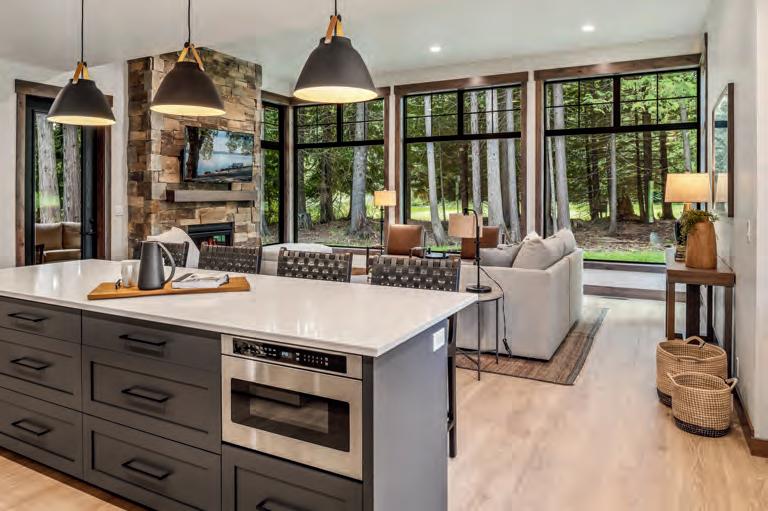


by Lyndsie Kiebert-Carey
The knowledgeable minds and collaborative spirits behind the Ice Age Floods Institute would be the first to admit the irony of celebrating 30 years of an organization dedicated to understanding the magnitude of geologic events that happened between 18,000 and 13,000 years ago.
Regardless of irony, three decades of IAFI’s steadfast efforts have made a notable impact on the region’s appreciation for the floods that shaped it, just like those floods left behind the lakes, valleys and so much more that make up the physical contours of life in the Pacific Northwest.
With 11 chapters across four states, IAFI continues to grow. Tony Lewis, president of Sandpoint’s chapter, known as Coeur du Deluge (it means “heart of the floods) said, “Our chapter, being in a small town, is the smallest chapter in the IAFI, although our location at the place where the floods started makes up for our chapter size.”
It is impossible to overstate: the Panhandle was ground zero during the last Ice Age, where an ice sheet some 40 miles wide and 3,000 feet thick dammed the mouth of the Clark Fork River where today it spills into Lake Pend Oreille. Back then, the dam held back Glacial Lake Missoula until it no longer could, resulting in a massive flood that flowed all the way to the Pacific Ocean.
The spot dammed and flooded again many times over the years, the floodwaters leaving in their wake the land as we know it today. It is argued that the Missoula Floods are among the largest geological events in Earth’s known history.
Geologist Bruce Bjornstad has authored several books about the Ice Age floods, including “On the Trail of the Ice Age Floods: The Northern Reaches,” which serves as a field guide to the floods’ geologic mark on North Idaho. Bjornstad—who described IAFI as a “leader” in Ice Age floods education—minces no words when it comes to the lasting impact of the floods on the


region, in particular as they relate to the areas south and west of Sandpoint.
“Sandpoint lay underneath several thousand feet of slowly moving glacial ice during the last Ice Age, but just south of Sandpoint, along Rathdrum Prairie, a huge fan of flood sediment was deposited, which progressively raised the level of Rathdrum Prairie,” he said. “This massive buildup of flood deposits upon the floor of Rathdrum Prairie led to the creation of eight natural lakes we see today, including Spirit, Twin, Hauser, Newman, Liberty, Coeur d'Alene, Fernan and Hayden.
“Furthermore, the expansive Rathdrum-Spokane aquifer would not exist except for megafloods,” Bjornstad continued, “which provides the Spokane Valley with an almost unlimited supply of fresh groundwater.”
Bjornstad said that, in his opinion, the most impressive floods’ feature lies in eastern Washington in the “width and depth of the Channeled Scabland.
“It’s hard to imagine so much water filling a vast interconnected network of channels, many hundreds of feet deep, spreading out for almost 100 miles across eastern Washington.”
It is easy to take for granted that the current state of human settlement across the northwest is a direct result of the Ice Age floods. Between the natural aquifers, rivers, lakes and fertile farmland left behind, the present was literally carved in stone.
“Locations of recreational opportunities and the communities between Farragut State Park and Spokane are where they are because of the Ice Age floods,” Tony Lewis said. “In fact, without the Ice Age floods there would be no Spokane, Coeur d’Alene or Sandpoint.”
Lewis has led Sandpoint’s chapter for the last decade, though he said he is ready to pass on the baton. In his time with IAFI, Lewis lauded the efforts of the board to build an invaluable resource for the sharing of flood knowledge: the Idaho Ice Age Floods Institute website. The site is home to countless maps, ex-
planations, and an up-to-date calendar featuring scheduled field trips and educational talks across the nonprofit’s 11 chapters.
“I must give enormous credit to the IAFI board members with the computer skills necessary to get our website up and running, who made it easy to use, visually inviting and informative,” Lewis said. “They really made it happen and got the word out about the physical and cultural impacts of the Ice Age floods.”
With an explicit mission to increase public awareness of the floods, IAFI continues to offer tours and talks, collaborates with the National Park Service to manage the driveable Ice Age Floods National Geologic Trail, and is even in the process of finalizing a floods-based science curriculum for fourth graders. IAFI Board Vice President Gary Kleinknecht called it a “30th anniversary present for youngsters.
“How many times have you passed by things during your daily travels without giving those things a second thought? Then, once you learned that something remarkable happened there, you began to make connections and see that one of those mundane things is actually part of a bigger story,” Kleinknecht said. “Opening that bigger story at a level that you can relate with makes it more personal and understandable. And now you've just opened a new window to your world.”
By opening that window, Lewis said IAFI is doing its part to ensure preservation of the area’s natural geologic wonders for the next 30 years and beyond.
“Numerous recreational and sport-related activities that are part of our local culture and economy are the result of the Ice Age Floods,” he said. “Knowledge is power, and any information regarding why and how our landscape was formed improves our appreciation of the landscape and the environment in which we live—and, hopefully, that culminates in an increase in the protection of these natural resources.”
Visit the institute website at www.iafi.org.













by Chris Bessler
As the Panida Theater approaches its 100th birthday in 2027, Sandpoint’s beloved cultural landmark is not only preparing to celebrate a century of artistic vitality—it’s undergoing a dynamic transformation that promises to carry it far into the next.
Helmed by an energized team of staff and board members, the Panida is deep into a new era of ambitious programming, long-overdue restoration and community-driven fundraising— all under the steady gaze of its historical past and the vibrant promise of its future.
“I’m super excited about the future of the Panida,” said Sean Behm, who took the reins as chair of the Panida board in 2024. “The Panida had been languishing. The pandemic hit it hard.
It was just sitting in a frozen museum state. But now, with the board we have and the staff that Robb’s put together, I think we can achieve tons of stuff.”
Indeed, the activity inside the historic downtown theater is buzzing. Under Executive Director Robb Talbott, the Panida hosted an astounding 129 public events last year; it’s on track for 150-plus this year. The programming reflects its mission to be a true performing arts center for the whole community— presenting everything from music and theater to film festivals, comedy, dance and more.
“The first thing is to keep alive the community and the culture that is the Panida,” said Talbott. “Maintaining the structure is important, but so is keeping a schedule that fosters the most community engagement. And really making sure the staff is happy and has a say in where we’re going.”
That sense of engagement extends to community groups that rent the space, who now experience a smoother, more welcoming process. “We worked hard to make it easier and more uniform,” Talbott explained. “Now, it’s as simple as reaching out to me—we make sure we’ve got the space, the schedule, the staffing. It’s become more efficient and accessible.”
Talbott’s keen attention to programming reflects both com-
munity values and diversity. “Are we doing enough for kids? For retired people? Young parents? Conservatives, liberals? We try to make sure we’ve got something for everyone. Then we look at the movies we offer and ask, ‘What gaps can they fill in?’ It’s a fun balancing act. Honestly, I love it.”
What may be less visible to audiences is the strategic evolution behind the curtain. In early 2024, the Panida had just one full-time staffer—Talbott himself—and three part-timers. Today, it has two full-time and four part-time employees, with longer lead times and a more coordinated approach to programming.
“Last year, we were throwing events together a week or two out,” Talbott said. “Now we’re planning 12 to 16 months ahead. That’s a much healthier place to be.”
A growing army of volunteers is also part of the Panida’s secret sauce. “They’re the face of the Panida,” said Talbott. “They interact with the public more than I do. Their smiles, their love of the theater—it transfers directly to the customers. It makes a huge difference.”
For Behm and the board, supporting this momentum means building consensus, delegating smartly and staying out of the staff’s way. “Everyone on the board is about forward momentum,” said Behm. “We work in committees, talk everything through and rarely disagree. It’s all about, ‘How can we best support the staff?’”
Big projects are underway to restore the Panida’s aging infrastructure—work that’s essential to preserving its historical character while accommodating modern audiences.
The most visible project slated for this fall is a full restoration of the north interior wall plaster in the main theater, funded in large part by a $100,000 grant from the Idaho Heritage Trust. “It’s going to be beautiful,” said Behm. “We’ve brought in a great plaster artisan, Greg Marsters of Custom Plaster. And Robb’s done a fantastic job of scheduling it around our programming so it won’t impact shows.”
Also in the works: a major redesign of the Panida’s often-congested lobby. “We’re still in the design phase,” said Behm. “We’re working with Boden Architecture to develop concepts and get pricing so we can move forward. The community weighed in through public outreach, and we’re down to two design options.”
Meanwhile, attention is turning to the Panida’s adjacent Little Theater, a more intimate 80-seat venue that Talbott sees as both an artistic gem and a strategic asset.
“It’s kind of like our farm team,” Talbott said with a laugh. “Smaller acts can grow an audience there before stepping up to the main stage. But it’s also just a beautiful space—for both audiences and performers. It’s where we can really focus on the art.”
Beyond local acts, the Little Theater plays a surprising role in broader talent development. “It gives us a way to build relation-





ships with performers and agencies,” Talbott explained. “If someone sends a smaller act who has a great experience here, it’s easier to bring in bigger talent later on. It’s about building community, not just in Sandpoint, but across the entertainment world.”
As the Panida expands its ambitions, the need for funding has become a central focus—both to cover day-to-day operations and to fuel restoration and long-term sustainability.
Fundraising coordinator Olivia Gonzales is leading the charge with a mix of creative initiatives and community partnerships. Chief among them is the Century Fund, launched in anticipation of the Panida’s 100th anniversary. Thanks to a major sponsorship from Ting Internet, which matches all individual donations, the fund has gained serious traction.
“I don’t know that the Century Fund would be where it is without Ting,” said Gonzales. “Their matching program has been a huge support. And we have a lot of exciting things planned between now and 2027.”
One of those is the new Panida Moms Red Carpet Gala, a festive, star-studded evening that honors the three women who saved the Panida from demolition in 1985. The first-ever gala was held on May 9. “We had music, magic, comedy, dance—all the things our community loves about the Panida,” said Gonzales. “And it was amazing. It’s going to be an annual tradition on Mother’s Day weekend.”
There’s also the Panida Endowment Fund, established with the Innovia Foundation to ensure long-term support. “It’s a legacy fund,” Gonzales explained. “The donations are never spent— just the interest. People can include the Panida in their wills and know it will keep supporting the theater year after year.”
If there’s a single thread tying together the Panida’s current efforts, it’s the sense of momentum. From infrastructure projects to artistic collaborations, from red carpet galas to meticulous plaster repair, the Panida is on a path toward renewed relevance and sustainability.
“The last year has been about building a foundation,” said Talbott. “Now we can spring forward. We’re in a much steadier place.”
And looking ahead? Talbott has his eye on community unity. “I’d love to see a summit of the arts—get the Panida, the Hive, the Festival, POAC, LPORT, the Conservatory—all together. Let’s knock down the walls and lift the whole community up.”
As the Panida approaches its centennial, its stewards are making sure the theater remains not just a cherished relic of the past, but a living, thriving centerpiece of Sandpoint’s cultural life.
“This place,” said Behm, “is going to be the same—and completely different in the best ways.”
See current schedule and more at www.panida.org




We’ve got this fun thing figured out by Reneé Sande
ocated on the edge of town on Pine Street, Travers Park is a community gem. Grab your softball glove, skateboard, bicycle and pickleball paddles. Pack a lunch, take in the mountain views, bask in the sun. There’s something for everyone—of all ages and abilities—to recreate or relax within these 18 acres.
Skaters can now enjoy twice the fun as the skatepark is now twice the size. Young bike riders will love the new youth bicycle skills course. while little ones will be entertained for hours at the new inclusive playground and splash pad. These additions augment the park’s fields for softball, baseball, soccer and football.
Standing over it all is the recently completed James E. Russell Sports Center, currently set up for tennis and pickleball lovers, but with plans to host even more sports.
“Our goal is for players of every sport to have a court or a field, indoor or outdoor, to play on,” said Jason Welker, Sand-

point’s community planning and development director. “We’re doubling down on empowering local partners to deliver sports and recreation experiences that matter.”
Learn more at www.sandpointidaho.gov
Five miles north, the city of Ponderay built it and the people came. Thirty years in the making, the Field of Dreams’ official opening last summer brought the vision of two soccer enthusiasts to fruition with the completion of phase one of a regional sports complex.
“This project is testimony to the commitment and dedication to our community’s youth,” said KayLeigh Miller, city of Ponderay’s planning director and project manager.
Phase one built four turf fields with lights, concessions and restrooms. Phase two will bring batting cages and bullpens, a pavilion, playground and flex space for other sport uses.
“Since opening this spring, the soccer fields have been booked solid,” said Miller.

The biggest advantage is that youth are now able to start practice six weeks earlier in the year due to the turf fields, Miller said, which has opened up opportunities for additional tourneys in the area.
Learn more at www.cityofponderay.org
Pend Oreille Pedalers—or POP as you may affectionately know them—not only knows how to build trails, they know how to build a loyal following; POP offers after-school clinics, summer camps, free bikes to any kid in need, and all with the goal to make it so fun, kids become lifers in the sport of biking.
“There’s a vibrant outdoor recreation economy here as not only do we have kids who have grown up mountain biking with POP, but who are now teaching the clinics and working on the trail crews,” said Emily Strizich, POP executive director.
In the midst of creating their own professional trail-building company, Strizich says POP is all about giving kids the chance to thrive.
“It becomes this really cool leadership training for them to give back to their community and learn life skills.”
Learn more at www.pendoreillepedalers.org
Kaniksu Land Trust is bringing two popular mountain biking trails in Pine Street Woods —Deer and Tea Kettle—that much closer to riders this summer.
“A generous grant from the Outdoor Recreation Fund Advisory Council will be used to make road and parking lot improvements so people can park directly off the county road


for access,” said Reagan Plumb, KLT’s conservation director.
Toilets will be installed and a universal access trail will be added around PSW’s beautiful pond, featuring fishing piers and benches.
“We’re super excited to bring these big improvements for the public to use and enjoy.”
KLT has also applied for funding for a connector trail between the Lower PSW parking lot and the main Sled Hill parking.
Learn more at www.kaniksu.org.
Another notable addition to area recreation is the Panhandle Bike Ranch, slated to launch this summer. Owners Scott and Jennifer Kalbach are opening 170-plus acres in Sagle for mountain biking of all skill levels on a variety of trails.
“Our family is beyond stoked to open up the ranch to the community and visitors to our beautiful area,” said Jennifer. Amenities at the ranch for its first season will be a welcome center with a bike shop, bike rental and retail. There will also be dry camping spots available.
While mountain bikers gave strong support to the new park, it has drawn opposition from neighbors concerned how increased activities will affect the neighborhood. Opponents presented an appeal in district court in April, which the judge had under review at press time. If the court doesn’t intervene, the ranch plans an opening in June.
Learn more at www.panhandlebikeranch.com.





Part of life in North Idaho is the thrill of living with a wide variety of wildlife. Sometimes we find them in our back (or front) yards, but more often they’re spotted when we are out and about in the mountains around us, recreating in this paradise we call home. When it happens to a photographer, with camera in hand, we can vicariously experience the thrill. Here we have a roundup of some great shots taken by local photographers, plus stories about some of their favorite close encounters… of the wild kind.
by Trish Gannon wild cats

Renowned wildlife photographer and author Tim Christie was up in Boundary County early one August day “scouting an area looking for deer sign. I was walking along a trail and just above me on a little rock ledge, the bobcat was watching me. I stopped and it stared at me,” he said. “Ever so slowly, it walked along the ledge, stopping several times to look at me. I was able to shoot several images in the encounter. Pretty special experience I might add.”
Mark Vogt was out near Elmira “on a day no different than any other” when “I had a weird kind of eerie feeling. I could feel the hair on the back of my neck standing up, telling me that I was not alone.” Grabbing his camera, “I turned around (and) saw movement out of the corner of my eye. A mountain lion!”
A photographer to his core, Vogt said “My first reaction was hurry, get a picture before it takes off. Then the thought hit me—what’s he going to do? He could be looking at me like I’m a potential lunch.” That didn’t stop Vogt from taking a few pictures. “The lion never took its eyes off me and started sneaking toward me,”

which caused Vogt to do what needed to be done—scare or intimidate the lion with big movements and waving arms and yelling. And the lion left. Vogt’s reaction? “I was so excited!” The result was the striking photo on the cover of this issue. Although cats—particularly cougar—are around us more frequently than most are aware, actually spotting one in the wild is a rare occurrence.
“I had hiked up to Two Mile Lakes,” said Kevin Davis. “In the marshy area between the two lakes we popped out of the trees and there he was. He didn’t seem afraid of us at all.” Davis shared that the caribou was so calm, “it was like we could have walked up to it and given it a pet. But he was pretty antlered up and you know, that really wouldn’t have been a good idea.”
The picture, however, was a great idea, especially as since 2020, there are no longer any mountain caribou to be found in our area. The last of the herd, considered too small to remain genetically viable, were captured and sent to live in Canada, where there are more of their kind.
Perhaps someday the caribou can make a comeback here.
Mark Vogt’s photo of a bear up close and personal came about thanks to that tantalizing purple fruit that draws many into the woods. “I was hiking around near the trailhead and found some huckleberries. I started picking them and heard a noise. I looked up and this bear was looking right back at me, doing the same thing I was: picking and eating the huckleberries. It was one of the most beautiful black bears I’ve ever seen.” Vogt left the mountains that day with both berries and the photo on the opposite page.
Corey Vogel, who finds all kinds of reasons to get out in our wild areas, was hiking with his border collie, Rowdy, in the Clark Fork area. “Rowdy would trot ahead of me about 20 yards, pause until I caught up, and bound off down the trail again, no matter where we went,” said Vogel. “This particular morning we were after huckleberries. I knew where a good patch was a little further along so that was our destination.
“As I made my way up to Rowdy, and very close to the huckleberry patch, I noticed that he was sitting down in the middle of the trail looking ahead. I wandered up to him and passed him by, but he didn’t budge one inch.” Looking around, Vogel said, “I saw a big ole black bear about 15 feet from me. He looked up from his huckleberry bush, stood up, his eyes widened, and then he proceeded to crash down through the bushes at breakneck speed; falling, rolling and sprinting until he was out of sight about 50 yards below.”
Vogel said the encounter kept both him and Rowdy motionless for a while before they finally continued on… and brought home “a lot of huckleberries.” But no photo.
Tim Christie was attacked by a grizzly bear at Glacier National Park that chased him up a tree, pulled the shoe right off his foot, and left him thinking, “I’m in deep *** here.” Despite the close call, he’s taken over 15,000 photos of grizzlies since. But here in our local area he mostly runs into black bear. He once spent days photographing a black bear that was hanging out at a friend’s property. The first two were productive in terms of photos but on day three the bear took notice of him and charged. Christie knew not to run so stood his ground until the bear got within 10 or 15 feet, then blasted him with pepper spray. “It’s the only time I’ve ever used it,” he said. “The bear skidded to a stop, coughed, then turned around and sped off.
“Yes,” he added, “I did kiss that can of bear spray.”
Spend enough time in the woods and you’ll likely run into a bear eventually. Keep the bear spray handy.
Tim Christie also got up close and personal with some whitetail deer when he spotted a doe standing in the middle of the road. Next to the road two bucks were determining who would have the honor of courting said doe. Christie turned his back on them to photograph the doe when he heard blowing behind him. Turning to look he realized the victorious buck was now headed for the doe with Christie directly in his path. “I had time to move about three steps before he went by me,” he said. “He was no more than two or three feet away.” Luckily, the buck was laser focused on the doe and decided not to teach Christie a lesson about getting between a male and his true love.
Some of the most common wildlife we see in these parts, deer can be a nuisance… particularly given their tendency to dart into roadways at the last minute. Be deer aware when driving. And when they wander into your yard to decimate your landscaping, remember that many people not lucky enough to live here have never seen them in the wild.
Matthew Jorgensen’s capture of a mama and baby moose was serendipitous. “I was driving to spend the day fly fishing a small stream. On my way, I noticed the moose eating in a little marsh patch and immediately pulled over. Luckily, I had brought my camera with me just in case an opportunity like that came about. I watched them for a while as they gradually fed across the marsh. Although the fishing wasn’t the best that day, those two sure made the adventure a success.”
Mark Vogt also ran into a mama moose with a young one early one morning while hiking the trail to Scotchman Peak.




When photographer Kevin

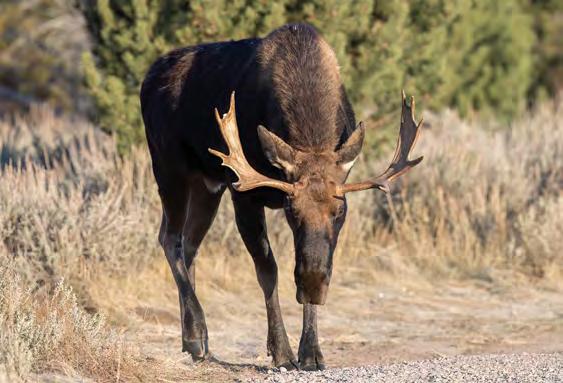


“They were fun and very curious, followed me up the trail for a bit,” Vogt said. He did, however, keep walking, understanding that moose can be unpredictable, especially when they have a little one to protect. Hanging around is not a good idea.
Moose are so common, they’re often spotted hanging out in town.
A really rare sighting occurred when photographer Amy Peterson was hiking with a friend.
“[Walking] down a remote dirt road with my friend, who was busy snapping wildlife photos, I noticed a sudden movement ahead. Curious, I lifted my camera and zoomed in, only to be amazed by the sight of three badgers walking single file down the trail, headed straight towards us. It was the first time I had ever seen badgers in the wild, and to this day, I haven’t encountered them again. We made sure to keep our distance, but as soon as they spotted us, they quickly scurried off into the brush. I managed to capture a few photos of the rare moment before they disappeared, a fleeting encounter I’ll never forget.”

Odds are high you’re never going to see a badger in the wild.
“One morning, I recall hiking up a steep mountainside just before dawn with my husband when we caught a glimpse of an elk in the thick open timber,” said Amy Peterson. “We froze in our tracks, trying not to alert her to our presence. For what seemed like forever, we stood completely still, balancing and holding our breath, hoping not to spook her and give away our position. After what felt like half an hour, the elk slowly moved down the mountain, out of sight. We continued on our way, feeling both the discomfort of standing still for so long and the satisfaction of the quiet encounter.” Peterson has taken many photos of elk over the years, but said, “That moment taught us a valuable lesson in patience and awareness—wildlife is all around you, but it’s easy to miss if you’re not paying attention. It’s a reminder of how rewarding these moments truly are.”
You may run into elk in the wild, but unless their favorite eating spot is nearby, it won’t happen often.


When photographer Dawson Owens spotted a barred owl, he instantly reached for his camera… only to realize he’d left it in his truck. After rushing to grab it and returning, “I started to panic because the owl moved locations, and I had no idea where it went,” he said. “So, I took a quick moment and prayed. About two minutes later that owl landed in a tree right next to where I was standing!”
Owls of all types make this area home. You’re more likely to see one at dusk or dawn, when they are most active, and during winter and spring, when there are fewer leaves to hide them.


In summer mountain goats are some of our large wildlife that can most predictably be spotted, but they don’t necessarily make it easy. Up-close experiences on Scotchman Peak require a strenuous four-mile uphill hike with 3,700 feet of elevation gain. That’s where Chris Bessler spotted this fellow during a hike with wife Sandy. “Basically, he was utterly unconcerned about us,” said Bessler, adding that, for the safety of both parties, hikers should never approach the goats. “That doesn’t mean the goats won’t approach you,” said Bessler. He captured a video clip of one coming a bit close for comfort; you can watch it at sptmag.com/goat.


There are three categories of unexpected encounters aside from wildlife: UFOs, Sasquatch and the Pend Oreille Paddler.
Sightings of the Paddler are analgous to the Loch Ness Monster. A 1989 article in the Bonner County Daily Bee tells us that "As of 1984, 27 sightings of the monster were made," citing James R. McLeod's North Idaho College Cryptozoology Club report, "Mysterious Lake Pend Oreille and its Monster."
The earliest known reference to some type of unknown creature that makes its home in the depths of Pend Oreille is said to date to 1944; it received the "Paddler" name in 1977, when what turned out to be a papiermache catfish supposedly attacked a young girl near city beach.

Some say sightings purporting to be the Paddler are likely just really large sturgeon, though Andy Dux, Idaho Fish and Game’s Panhandle Region fish manager, said “We have never documented a sturgeon in the lake,” adding, “Sturgeon are native to the Columbia Basin, but they never colonized Pend Oreille because of downstream migration barriers.”
Paddler reports might be related to the unmanned submarines that ply the lake, thanks to the Naval Acoustic Research Detatchment, originally a part of Farragut Naval Training Station since 1955, and still located in Bayview.
In a cover story in Omni Magazine in 1996, McLeod advanced the idea that the Paddler legend originated back when the submarine tests in Lake Pend Oreille were classified top secret. He said one of the first reports of the monster, in fact, came from Farragut in 1944.
UFOs (UAP, for unexplained aerial phenomena, is now the preferred term) have also been reported in the area. A 2021 Idaho Press headline "Idaho's UFO Connection” states that “the state ranks No. 1 per capita for seeing unexplained things in the sky." Here in Sandpoint, we average about one reported sighting per year. That doesn't include the dozens of sightings reported on local Facebook pages, many with photos, that generally fall into the category of "yeah, that's the Starlink satellites."
In a November 2024 story, Local News 8 (out of Idaho Falls) reported that Sandpoint ranked No. 8 in Idaho cities for UFO sightings, with 28—a tie with the city of Caldwell. We fell to Boise (No. 1) and Nampa (No. 2) but beat out Post Falls (which came in last). I'm not sure what all these people have seen in the sky, but my good friend Giorgio Tsoukalos assures me: it's aliens.
Sasquatch is another thing entirely. Bonner County has more reports of Sasquatch sightings than any other county in the state. (Read all about it in "Summer of the Sasquatch" in our Summer 2018 issue of the magazine.)
A Spirit Lake fellow was recently prepping to hunt west of Sandpoint and his game camera captured what he believes to be a ‘Squatch. He shared the video with us. It clearly shows a moose in the foreground but something ... shadowy ... moving behind it.
I can't even see babies on an ultrasound, so I can't tell you if I think he saw what he says. You can view it online at sptmag.com/squatch.
As for the photo of the Sasquatch shown above, that was taken while rafting on the Moyie River. Unlike most photos, this one is refreshingly clear and easy to see, and may well be someone playing a prank on unsuspecting rafters. Or maybe it’s real.
–Trish Gannon








by Sammy Berryman
It’s easier than ever to succumb to the allure of mountain sailing on Lake Pend Oreille thanks to Jon Totten, owner of Dogsmile Adventures.
“Our lake is huge! You get out into the middle and the mountains are very dramatic. It’s beautiful,” Totten said.
Dogsmile Adventures is a 501c3 nonprofit centered on therapeutic sailing. The nonprofit works by collaborating with other organizations who serve special populations such as Bonner Homeless Transitions, veterans, youth and those facing the challenges associated with addiction, domestic violence and physical or mental disabilities. To date, they’ve hosted 1,254 sailing experiences since their inception in 2021.
“We have people with wheelchairs, amputees, overweight, elderly,” Totten said. “If I can physically get you on and off the boat, you can sail.”

A lifetime outdoorsman and educator, Totten left Idaho in 2015 to run charters and yacht deliveries in the southern Caribbean. The nature of the job felt like being on vacation the whole time, including long benders and lots of partying.
“On Saturday they go home, on Sunday I go sailing again. The toll over time became really hard on me.”
So hard that in 2019, Totten checked himself into rehab. While in rehab, a new appetite began building inside of him— he wanted to do something that mattered but couldn’t put his finger on what it should be. A One-Design J/105 sailboat he owned was sucking up money in Grenada and he needed to get it to Seattle, where there was a bigger market to sell. This was in March of 2020 and a rethink was needed when a pandemic arrived.
Though he had previously lived in Stanley, Idaho, Totten chose Lake Pend Oreille for a new home because of the connections he had here and the mountains that surround us. Due to the pandemic, many people opted out of putting their boats in the water so he was able to get a boat slip out of Bayview.
Totten was determined to break down the barrier to entry in the sailing world and in Sandpoint, he found others of like mind in the Sandpoint Sailing Association, who for a long time had been inviting those interested in sailing to show up at Windbag Marina, where they would be put on a sailboat (at no cost) for an evening on the lake.
It was a program that dovetailed with Totten’s dream. “I wanted to bring these outdoor experiences to folks that don’t get to go,” Totten said. “I always hated how much my trips cost; most of my friends and family could never go sailing with me because it was way too much money.”
When out on the boat with a group of people, he sees firsthand how in tune everyone is. The vessel moves thanks to tasks each person is helping perform—it engages their body and mind.
“Sailing holds people in the moment. The flow state. You’re not anywhere else,” Totten said. “In that state there are no intruding thoughts because there’s not room for them. It takes all

your mind to operate the boat.”
Totten doesn’t bring crew other than himself so that it can be a truly immersive experience. He believes that the best way to help people push through fear and discomfort is to give them a job.
“When I tell you to pull on the black line, you don’t need to know what the black line is called or what it’s going to do but I need you to help me.”
This responsibility, and even a small sense of fear of the unknown, locks you in.
“In that, there’s nothing else. Their recent loss or their trauma, whatever it is, they get away from it for a while and that’s the essence of the whole deal.”
Totten decided to expand this experience beyond just Thursday nights. He incorporated as a nonprofit—Dogsmile—and set up a program whereby those who purchase a boat ride are actually buying two—one for themselves and one for someone who needs it. Through partnerships with community organizations, those ‘extra’ rides become part of sailing programs that focus on supporting under-resourced groups, including veterans, youth, and individuals dealing with challenges like addiction, domestic violence or physical and mental disabilities.
There are a handful of ways you can join the fun. You can buy an experience on the website, volunteer to help run races or show up to Sandpoint Marina on Thursday nights and join the Sandpoint Sailing Association’s fun community races.
If you’ve ever been slightly curious about sailing, Totten advises you try it. Thursday nights starting the middle of June through September are open and free to all. You don’t need a boat or need to know how to sail. There will be 40 to 50 people at the Windbag Marina, located on the far side of the Edgewater, who will place you with a skipper and crew of people to sail with.
Or you can become a part of Dogsmile’s more expansive offerings. “There are a lot of barriers to getting into sailing so Dogsmile Adventures is our answer to getting as many people out as possible.”
Learn more at www.dogsmileadventures.org

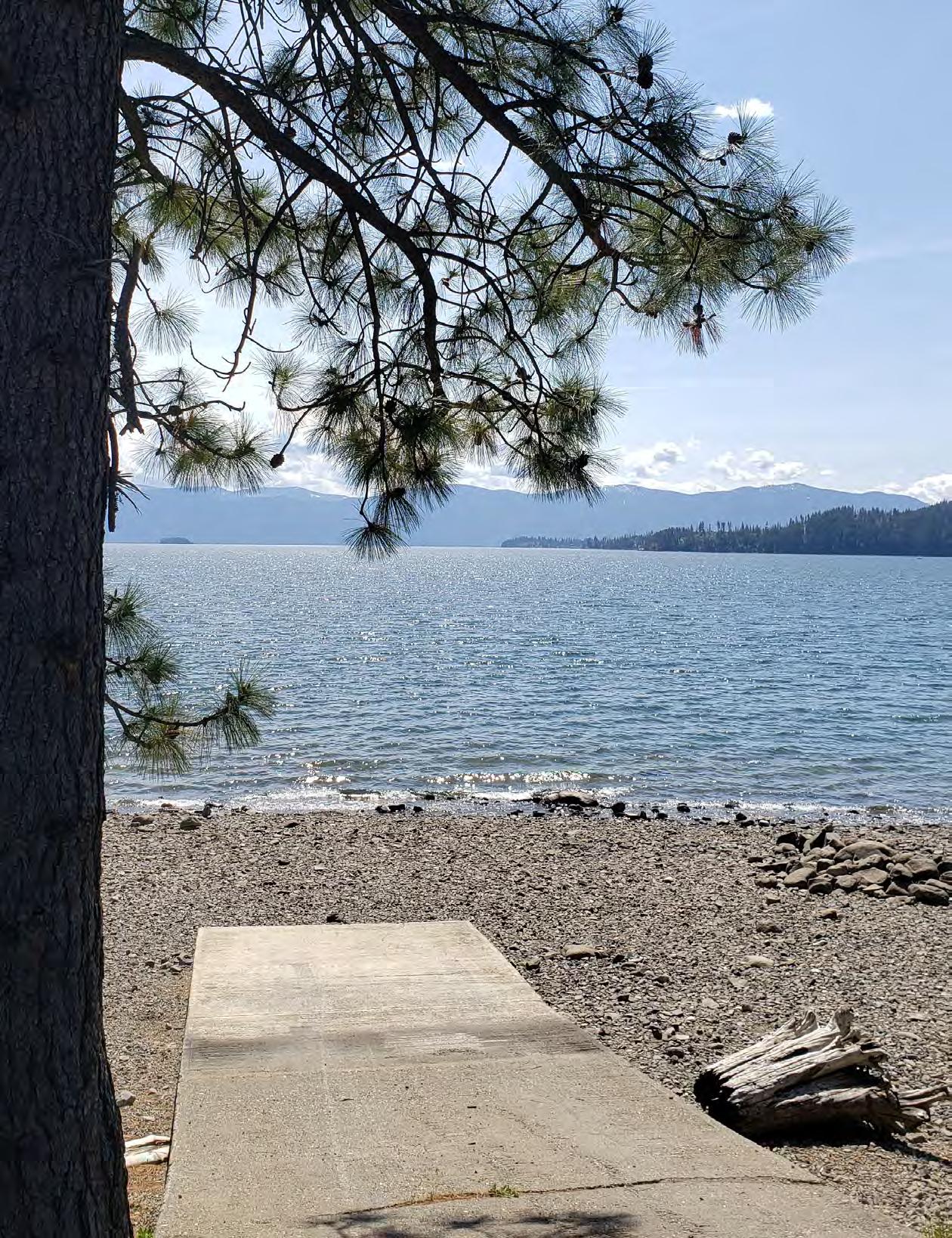

by Cate Huisman
Last year, after a lengthy legal process, the citizens of Bonner County lost most of a historic approach to Lake Pend Oreille: Private developers were allowed to close a public road to the shore at Camp Bay and replace it with a narrow trail. Residents felt the loss keenly, and their disappointment has energized a movement to protect what remains of public access to the lake.
The Pend Oreille Lake and River Water Trail is one result. It’s a joint project of Kaniksu Land Trust and many partners. It is not so much a new trail as an old one, following water routes that were used for millennia by the people who lived here before the current crop of residents arrived.
Many of the historic access points along the lake are obscure. Often they are little-used bits of waterfront where public roads dead-end at the shoreline (as was the case with Camp Bay). “Some of them have been historically used over time, but others have not,” said Katie Cox, executive director of KLT. “Some have been taken over by neighbors for their boats, or their gardens, so they don’t appear very public.”
So the trail does not need to be built so much as it needs to be rediscovered and remembered. Last summer, partners traveled the entire lakeshore documenting access points. Some, such as old rights of way or wildlife management areas, have few discerning features. Others, like Samowen State Park and Albeni Falls Campground, have developed campsites with shelters, running water and road access. And many are somewhere in between, with maybe a boat ramp or a
picnic table.
The trail will link this collection of public places to help boaters know where they can go ashore and where they can camp. And the documentation and mapping will, it is hoped, protect these sites from development or usurpation. For members of the Kalispel Tribe of Indians, this protection is particularly meaningful, as it will confirm access to waters that have long been part of their heritage.
Partners do not intend to add amenities or improvements. They don’t want to create new attractions or add new parking areas and outhouses to the long lists of maintenance chores that already fall to the Corps of Engineers, Idaho Fish and Game, Idaho State Parks and other agencies responsible for land maintenance at established sites.
Instead, data about existing sites and amenities will be compiled onto a waterproof map. Funding to print this map has already been secured, and at press time the partners were in the process of going through the list of sites and noting distances between them. The map should be ready by fall.
The importance of this resource to the human-powered boater can hardly be overstated. The lake is 45 miles long, with a 30-mile fetch that can quickly kick up boat-swamping waves if a wind picks up out of the south. While motorboats can often outrun these hazards, paddlers and rowers need to know where they can escape ashore.
The project has unearthed more than facts and figures. While gathering information on sites and distances, partners have discovered so much else of interest
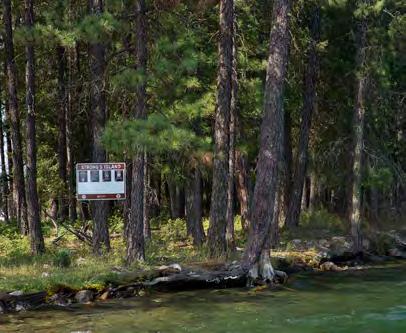


Within Sandpoint city limits there are a number of developed parks where the public can access the lake—foremost among them City Beach, the pier at the end of Main Street, the Pend d’Oreille Bay Trail, along the Sand Creek trail, the boat launch at Memorial Field and a pier at the end of Third Avenue.
There are a few other city properties that remain in the public domain. Undeveloped public access remains at the end of Euclid Street, on the west side of the water treatment plant off Ella and Elm, and at the end of Division Street.

Jason Welker, the city’s planning and community development director, said that while there has been some talk about potential (though quite minimal) improvements to those three, due to “limited funding and a long list of deferred maintenance [that] would not be high on our priority list at this time.”
Organizers of the Pend Oreille Lake and River Water Trail have a nearby model to follow: The similar-sounding (but not the same) Pend Oreille River Trail follows the river downstream from Oldtown, Idaho, to Boundary Dam, a mile below the Canadian border.
While this trail starts in Idaho, it passes quickly into Washington state. The project was initiated by Washington State University Extension in 2009 and put in place with the support of numerous state and local government partners, as well as the Kalispel Tribe of Indians, whose reservation at Usk is on the river and the trail. This section of the river passes several small towns, and there are a number of features not found on the lake trail: a dam that requires a portage, a waterfall (Peewee Falls) that you can paddle up to, a set of rapids at Metaline Falls and the narrow and striking Box Canyon. The trail’s comprehensive website includes lists of birds and mammals along the route as well as fishing tips.
River travelers can buy complete sets of waterproof maps for this trail in Newport, Washington (just across the border from Oldtown), or download maps from the Pend Oreille County Parks website. You can also find it online at sptmag.com/watertrailmap.
–Cate Huisman
that an accompanying smartphone app is also in the works. Curious travelers will be able to turn to it to uncover the stories and histories that surround the lake. The app will take longer than the map, as that project has yet to find funding.
The trail begins at River Mile 88 on the Pend Oreille River, just upstream from Albeni Falls Dam, and just a few miles from the Pend Oreille River Trail that extends downstream (see below). From the dam the new trail continues up the river and into Lake Pend Oreille, where it continues in a clockwise direction around the lake. Readers will be able to find the map by checking at www.kaniksu.org
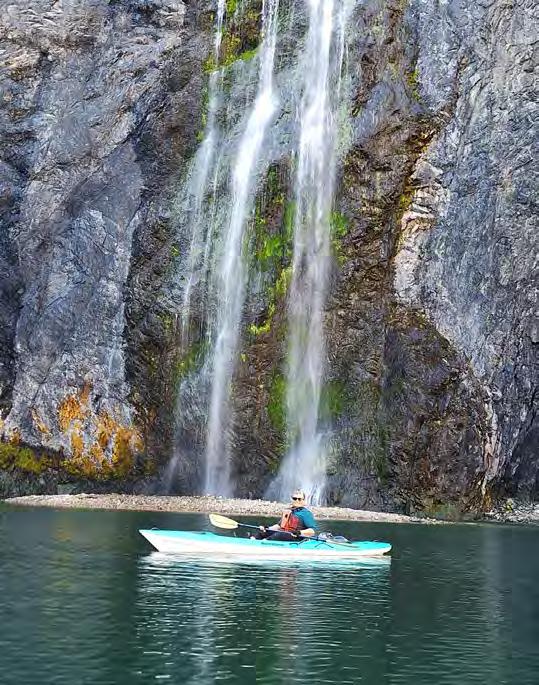
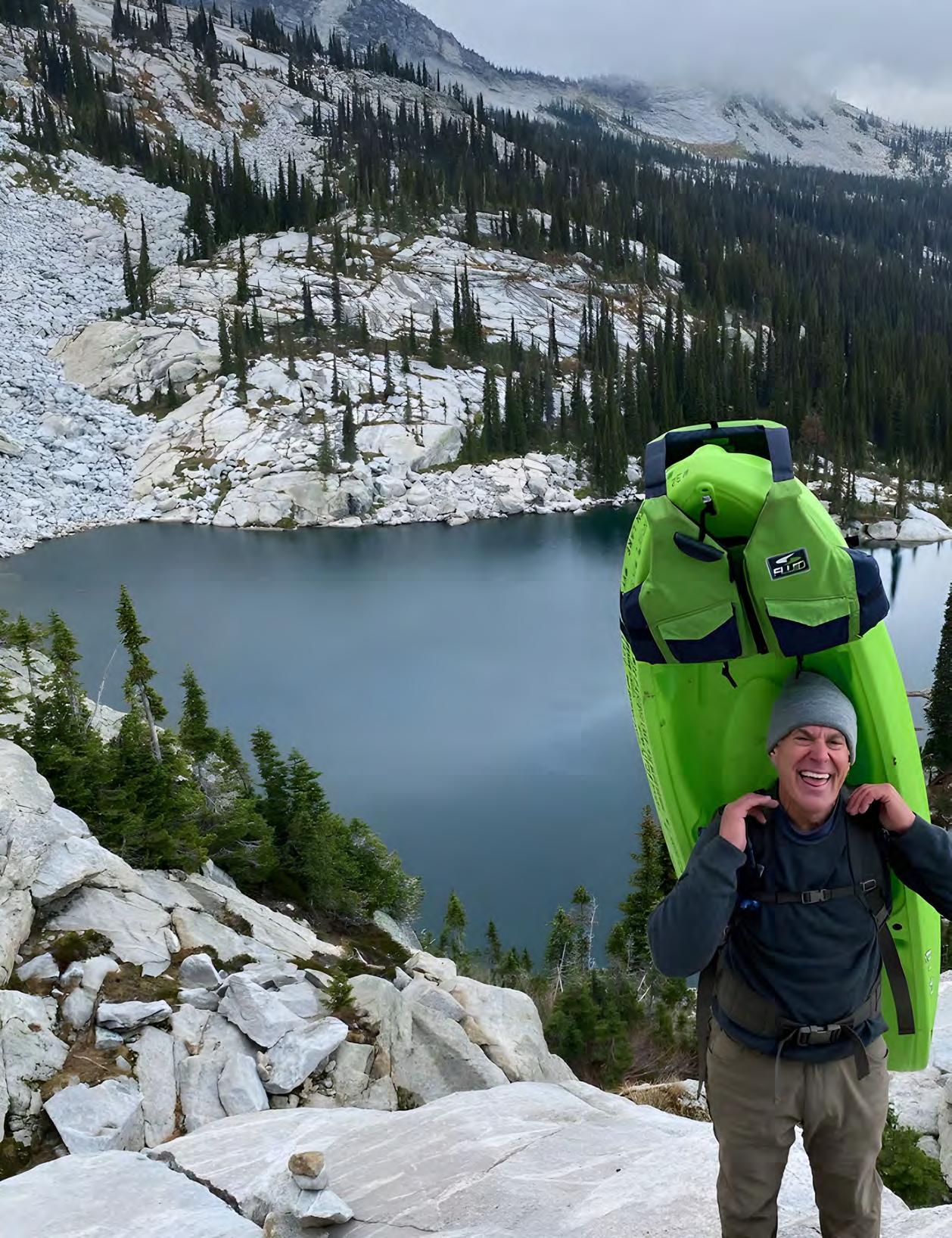
by Kevin Davis
Robert wasn’t certain yet that he was lost. He was certain that he was somewhere on the side of a mountain, post holing through the snow, with a boat on his back. He was looking for Pyramid Lake, high in the Selkirk Mountains, where he intended to go kayaking. But when he finally found the lake, it was 90 percent frozen. That didn’t deter Robert; he got his paddle in, strapped his boat to his back and headed out. He was tired from sinking to his knees to be pitched forward and sent sprawling headfirst into the snow, so he kicked his boat down the snowy slope and watched it pinball through the trees to the bottom. He was three weeks into his journey to kayak 70 lakes in just five months. Robert Smith was born and raised in Washington. His


father instilled in him a strong environmental ethic and he read lots of books about the forefathers of conservation, like John Muir. He found his way to Sandpoint in 2013 after raising a family and retiring from a career in long-haul trucking that took him across the country many times.
While exploring his new surroundings paddling on Shepherd Lake, he encountered numerous dead turtles in the water and called Idaho Fish and Game to inquire. IDFG told him the turtles were dying from salmonella and asked if he was out on any other lakes that he report back if he found more.
Later, Robert was filtering through resources on other local adventures and read a Sandpoint Magazine article about Scott Bourassa (“Meeting the Goal,” Summer 2023), who hiked to all Boundary County lakes. Inspired to adventure by Bourassa’s story, and compelled by Idaho Fish and Game to pursue environmental stewardship, Robert locked in to the idea of kayaking as many lakes as he could.
First, he would need a boat. He found a lime green sit-on-top kayak that was about as long as he is tall. He fashioned some straps through the drain holes so he could carry it on his back. His first put-in was Shepherd Lake on May 13, 2023, where he found the dead turtles. Soon, he was hiking miles and miles in to alpine lakes in the surrounding mountains while carrying a
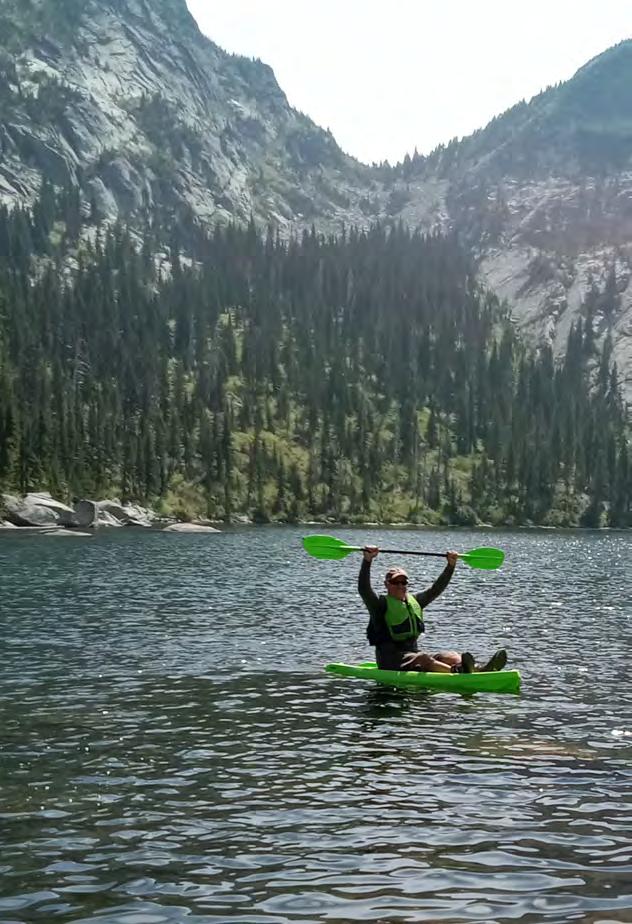
kayak on his back; he was officially a ‘hiyaker.’
To reach his goal of 70 lakes in five months he would have to knock off a new lake just about every other day. As he ticked off the easy ones like Shepherd, Antelope and Kelso the adventure got more demanding. “The hike into Hunt Lake was very treacherous,” Robert related as he explained the dangers of climbing through a boulder field with a boat on his back. “I got lost in the fog trying to find Cooks Lake. It was raining and the brush was over my head so I was soaked to the bone. Then I got lost on the way back to the truck!”
With all the adversity you would naturally wonder why he does this. “I love jumping in the truck in the morning with my cup of coffee and heading to a new destination.” He likes the different perspective he gets of the mountains from paddling around the lake. John Muir once said, “The mountains are calling, and I must go.” Robert hears this call and has responded in a way the wilderness sage would likely appreciate.
Robert had some solo trips but often had a partner. None of the dozen or so people who joined him over the course of five months were crazy enough to pack in their own boat. On the trail, Robert would encounter other “normal” hikers and was amused by their reactions. “Everybody had encouraging words for me and usually it was some variation of ‘Hell yeah,’ ‘Hell no,’


or ‘What the hell!?’” Robert’s response was, “If I can do it at 62 years old, you can do it.” He encourages everyone to get out into the wilds and challenge themselves and discover new things.
On October 23, 2023 Robert had one last lake to reach, number 70. Ahead of a snowstorm, Robert hiked in to Little Harrison Lake via the Beehive Lakes trail. He hiked about a mile up a steep trail, climbed over a ridge, scrambled down a boulder field, descended granite bedrock and launched his lime green kayak on his 70th lake. Paddling on a clear blue lake with the soaring granite peaks of the Seven Sisters around him must have been very satisfying.
The day I called Robert it was cold and windy and I was out for a walk at the Clark Fork Delta. Waves were crashing into the shore and piling up mounds of ice. It was a scene from the arctic and it looked like certain death to be caught out there. But Robert, the ‘Hiyaker,’ had plans to go kayaking that day on Lake Pend Oreille and was thinking he could find a calm piece of water in Pend d’Oreille Bay. He has plans to do more kayaking in Montana this summer. He says he’s always looking for an adventurous partner.

After hiking in to Hunt Lake—what AllTrails calls a moderately challenging route—Smith enjoys a celebratory paddle.
Above: Smith preparing to descend from ‘Nosebleed Ridge’ down to Big Fisher Lake to camp for the night. Photo by Eric Towle.
Below: Smith utilizes the tried-and-true circle on a map to record his hikes—only a few of which are pictured here.




Previous page: The high-pitched whistle of a bald eagle is familiar to those lucky enough to live in this area. Photo by Mark Vogt.
This page top: Sandpoint’s a train town, and the lonely wail of a whistle is a familiar and comforting sound. Photo by Mark
This page left: The


Previous page top:
Previous page bottom:
This page below: Every summer, the sounds of the Festival at Sandpoint ring throughout town.




by Pam Webb
When designing a structure, view is one of the project challenges architects face. How a view is addressed as a design element was posed to three architectural firms: Boden Architecture, Studio Ascent and Hendricks Architecture.
“View can be a driving factor when it comes to design,” confirmed Tim Boden of Boden Architecture. When it comes to a project, the award-winning Boden team believes in a three-sided collaboration: the client, the firm and nature, especially when view is an essential component of the design.
When it comes to view being an integral component, the Sky House Lodge, located at the top of the Schweitzer Mountain, is a prime example of how the Boden firm combines function and splendor as the building serves as a restaurant, lodge and ski patrol station while accommodating a high volume of the ski resort’s traffic.
On the other hand, what happens when the view is not spectacular or presents a problem? “We use architectural screening to block problematic views with rooms, walls, fireplaces and landscaping,” commented Boden. Scott Wohlschlager, Boden’s partner, said among the first steps in a project is listening to the client. “We need to understand what is important to the client. What is it about the view that is special to the client?” Scott emphasized how the process becomes
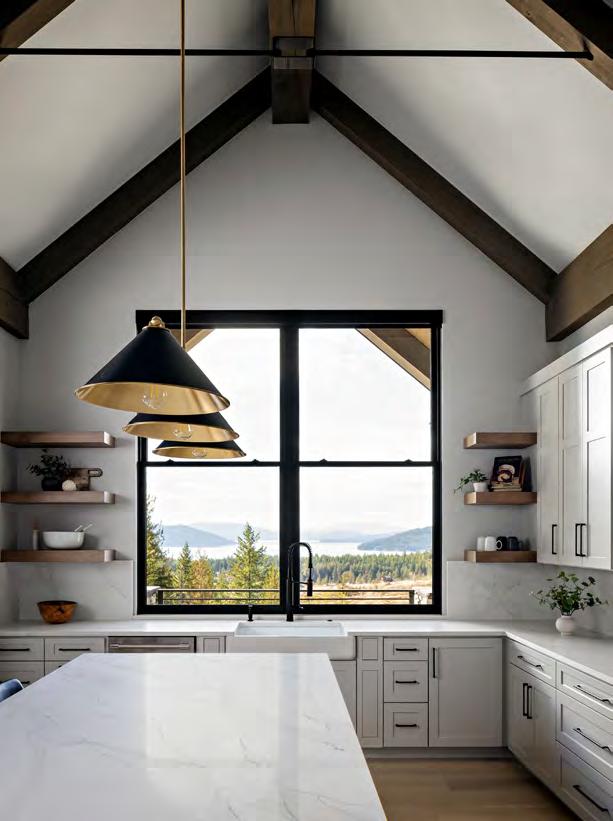
a collaboration between the design team and the client as the balance between function and view is created.
Sometimes the client needs to see a different perspective when it comes to a project, how the opportunity for view is not an actual impediment. Johnelle Metz, the firm's interior designer, provided an example of a client who wanted to see the lake while bathing, yet the hesitancy of a bathroom window allowing a vista seemed a stumbling block until it was pointed out that the drafted design allowed her to see out while no one could see in.
Windows are typically how views are captured, yet they require placement attention. “Windows can be a solution but also be a problem since solar gain is a consideration,” mentioned Boden. Wohlschlager noted the importance of the sun's angle and seasonal exposure when placing windows, while Metz expressed how different rooms can influence a person’s feelings depending on what the view provides, such as watching a storm roll in across the lake. Respecting what the site offers and listening to the client’s needs motivates Boden Architecture to strive towards creating a design worthy of the view.
Brennen Chasse of Studio Ascent also considers the client's priorities, noting how the best views are a high priority. “We start every project with a site walk to understand the hierarchy of views," said Chasse. “We have a house under construction in Oden Bay that is all about the view. It is stretched along the waterfront so most of the house gets lake views, while also


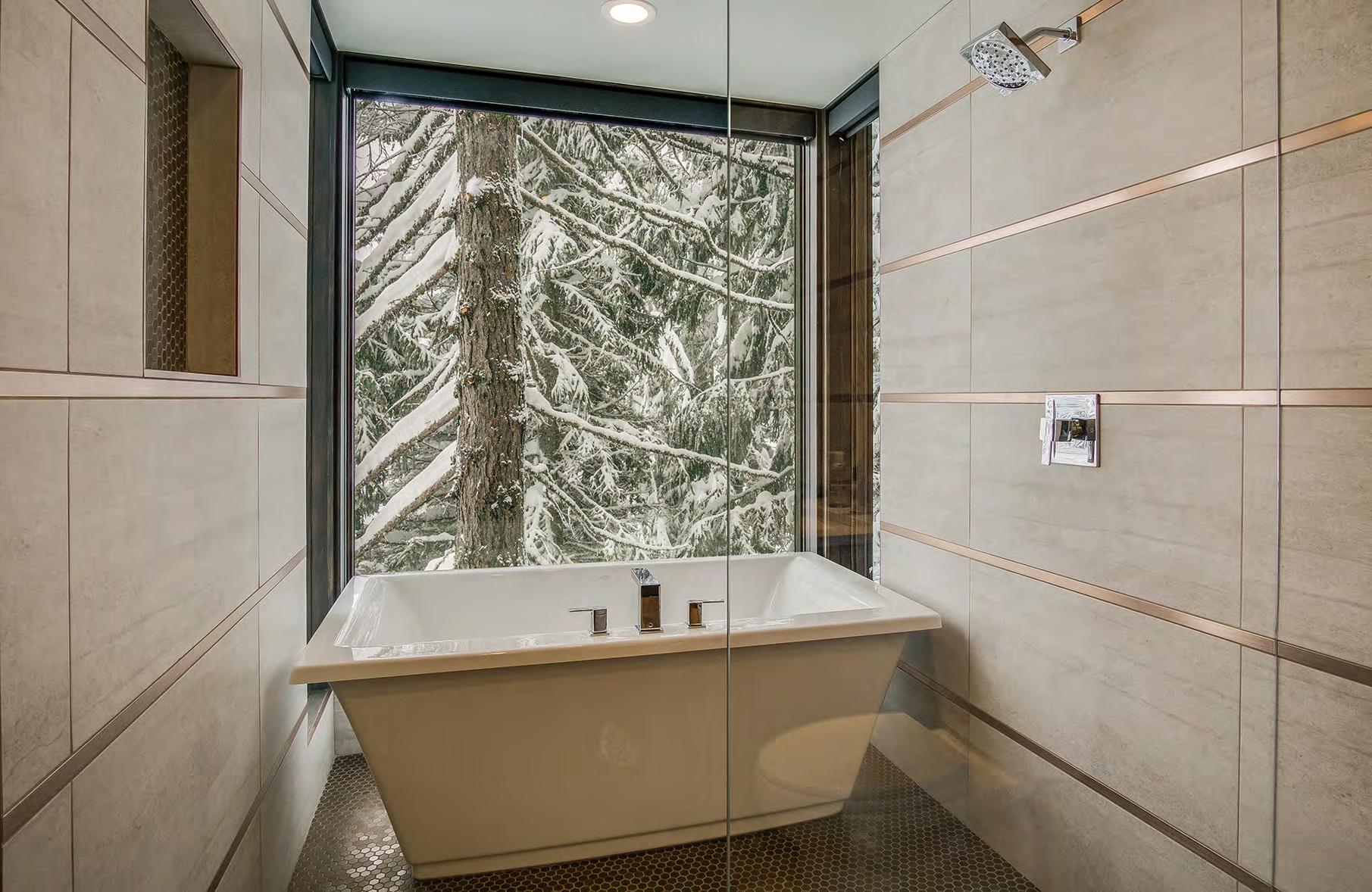




opening to a courtyard that then spills into the waterfront.”
Chasse notes that view options for urban lots can be tricky and one consideration is to create courtyards or garden areas to offset the lack of expansive views.
Bringing the outside in, seeing the view as a work of art, is an aspect of how Hendricks Architecture approaches incorporating view into their projects. This tenet is apparent when considering how the firm approached the rebuilding of the Idaho Club’s lodge, razed after a tragic 2008 fire. Vistas of the stunning surrounding scenery are available throughout the new buildng.
Listening to John Hendricks, principal architect and to Annie Hendricks, the firm’s office manager, it’s evident why the firm repeatedly earns the accolade of “Top Mountain Architect” from Mountain Living magazine. As Annie clicked through the various projects, merging the outside with the inside is a recognized trademark. “We like to frame views with lots of windows,” noted John. “We incorporate view as much as possible,” agreed Annie.
Another design factor is a client's lifestyle. John gave the example of how someone desiring a scenic vista upon waking is not going to want the sun streaming in the bedroom if they are not an early riser. "Other essential aspects when incorporating the view into a design are site and orientation as well as the placement of primary living spaces."
Annie showed several examples where the view is integrated into the overall design through liberal use of windows, even relying on NanaWalls, which are folding glass walls. “Unfortunately windows can increase the budget,” Annie said.
Seasonal changes can radically alter view considerations. John brought up a Coeur d’Alene house situated on a ridge with an expansive vista of the lake. Due to the elevation, snow would accumulate, diminishing the once prominent lake scene. John worked with these seasonal fluctuations when designing the house.
Creating a room with a view requires skill and a desire to bring the outside a little closer when inside.











Becoming ‘of’ a place, rather than ‘from’ somewhere
by Zach Hagadone
here is no greater social currency in a small town than the label of “local.” It’s the recognized guarantor of authenticity, which itself is the most treasured commodity in places desperate to maintain their sense of self. When everyone wants a piece of a place, the locals are the ones who stake their claim on the pieces.
But what makes a “local” minus a birthright can be tricky to define. Obviously, no one becomes a local in any place the moment they’ve unpacked the moving truck. It’s even hard to justify “local” status after a year or two. Some deny their “local” status by saying they’ve “only” lived here for 10 or 15 years. Others claim it the minute they get their 7B license plates.
Being born at Bonner General Hospital, my localism is assured. As is my dad’s, my brother’s, my son’s, my aunts’, cousins’ and cousins’ once-removed—all of whom were born here. I sometimes meet second and third cousins I didn’t even know I had until we got to talking about how long we’ve been here and who our “people” are.
This is all thanks to my great-grandparents, two sets of whom came to Sandpoint from Montana with their families in the first decades of the 1900s. Neither of my paternal grandparents were born here, but they came to Sandpoint young enough to have few memories of Big Sky Country. They spent the rest of their lives here, and it was at my grandma’s kitchen table that I heard her stories of what it was like to see Sandpoint evolve from dirt streets, boardwalks and bootleggers to a place that she called “over-organized, overpriced and overproud.”
Clearly we like the place, and appear to have little inclination to wanderlust. It’s hard to describe being sedentary as an

accomplishment, yet there is a distinct pride in being “of” a place, as much as “from” a place. And anybody can become “of” a place if they try.
I know Sandpointians who’ve been here for fewer than 10 years, but have incorporated themselves into the life of the town with such enthusiasm and generosity of time, effort and good faith that no one could argue they aren’t true locals. I’ve also known people to reside here for decades but contribute so little to the culture and personality of our shared home that they will forever be “transplants.”
Localism is an investment that cannot be made simply by planting a property line and retreating to a life spent perpetually on vacation. It’s to the entrepreneurs, the volunteers, the doers and makers, the donors to causes and participants in the community that the “local” label may be applied without qualification nor generational justification.
We care about the healthy functioning of our community’s institutions and its human and environmental past, present and future. We know what we have and what effort it has taken to make it the place from which we do not wish to move—and to which so many people wish to come.
I’ve lived in other places, but never considered myself a “local” in them; in fact, they’ve served to reinforce my allegiance to Sandpoint. If I have a political party, it’s Sandpointianism. Its tenets: love the land and don’t harm it; know and respect its history; admire and protect it, warts and all; have respect for and contribute to its eccentricities; understand that short-term gain is a retroactive thief; and, from sidewalk to hillside, don’t mess with the moose.
They’re ‘locals’ now: four case studies







Here is a great opportunity to own one of these remaining 25 of 28 homesites. These 10 Acre parcels have amazing views of the Pend Oreille River! All the parcels are 10 acres in size with underground power to the property line for each lot and have limited CC&R’s with no minimum timeframe to build. Several lots border public land and there is an easement for the remaining lots to have access too! These homesites are located just 20 minutes to downtown Sandpoint and 45 minutes to Schweitzer Mountain Ski Resort and The Idaho Club golf course. The public boat launch for river access is just 2 miles away and Willow Bay Marina is nearby with seasonal boat slips for rent. Come and enjoy thousands of acres of public lands in Bonner and Boundary County for all of your four season recreational fun!


by Renée Sande
Imagine waking to the sway of the waves beneath you, the smell of coffee mixed with sweet lake air rousing you to step onto your dock and into the hushed morning, as the sun rises slowly over Bernard Peak, where a mountain goat quietly grazes.
Welcome to float home life, on Lake Pend Oreille, in beautiful Bayview, Idaho.
Located in Scenic Bay at the south end of Lake Pend Oreille—Idaho’s largest and deepest lake (the navy tests submarines here)—this gem of a community is unique.
Not only has Bayview made a name for itself by giving water lovers the spectacular opportunity to live directly on the water and be literally tucked into the heart of all that nature’s beauty has to offer, but also by keeping its small town vibe (with big personality) alive.
Geographically speaking, however, even if it wanted to get bigger, it actually couldn’t.
“Because it’s bordered on two sides by Farragut State Park, one side by the lake and the other side the mountain, it’s always going to be a small place, which is good,” said Gary MacDonald, third generation Bayview resident and owner of MacDonald’s Resort, which operates one of the five marinas in the bay.
“The thing about Bayview is, it’s at the end of the road—the highway doesn’t go through it—so you’re either going to Bayview, or you don’t go,” he said.

But many do decide to go, not only for the beauty, but for the fun.
One of the goals on the Bayview Floating Homes Association’s website is to “have the MOST fun,” stating they “haven’t met a (responsible) party they didn’t like.”
“You’ll see someone occasionally fall off the dock and possibly they’ve partaken in some adult beverages—there’s always that,” laughed another third generation resident, Bert Batchelder.
“My friend, Jack, determined the best way to navigate long stretches of dock after a night on the town was to run rather than walk,” continued Batchelder.
“And I must admit, it does seem to take the stagger out of your steps, but only up to a certain level of intoxication.”
But like any good community, the residents here balance the fun with being (responsible) homeowners, which is why they formed the Bayview Floating Homes Association in 1995, in response to moorage fees being grossly increased. They realized they had no protection or

rights under Idaho state law, and were not covered by any landlord/tenant acts within the state of Idaho.
When the Bayview floating home com munity started in the early 1900s, they were simple fishing shacks—that could be moved from job site to job site—for fisher men looking for Kokanee salmon.
But as boating and recreation on the lake became more popular in the 1940s, the float home idea became appealing on a whole other level. More and more float homes popped up and by the 1970s occupied space in all five marinas. Then and today, there are 100 float homes within Scenic Bay.

Since then, however, the state of Idaho has not allowed any new float homes to be added; only renovation to the original footprint can be approved.
“Over the years, the homes have gotten bigger [by building up], more modern and well-equipped, but the basic structures were made of 2’x4’s, with not much room for insulation. [They] were considered a poor man’s lake cabin as you don’t



own any real estate, you just sit over Idaho real estate,” said MacDonald.


Pat Phremmer and her husband, Dick, who live in southern Oregon for most of the year, live in their Bayview float home the four warmer months, opting to close up for the winter and head home.
However, not all homeowners look at their Bayview float home as a vacation home, but rather as their permanent abode. These 10 or so “year-rounders” are what Batchelder calls “hardy individuals.”
“Depending on where they are—how exposed—it can get pretty nasty. The waves come in and splash up on the dock to create an ice skating rink. Then there’s the matter of hauling your groceries, et cetera, from your car down the length of the dock, in the snow.”


Luckily the year-rounders have fared pretty well, and thus get to enjoy the beauty of the area all year, as well. Phremmer understands.
“We did come up one Christmas/New Year, and loved it! The scenery was like a charcoal drawing, all shades of black with white.
“One of the things I love about this community is the uniqueness of this lifestyle that brings people of all persuasions together because we have the enjoyment—and challenges—of this special community in common.”
Trust makes home ownership dreams come true
by Cameron Rasmusson









time buyers.
Like many millennials now in their 30s and 40s, Ray didn’t expect that a home of her own would be within reach. With the demand for homes exceeding the supply, younger buyers are often priced out of the market. According to Boston Globe Media Partners, millennials born between 1981 and 1996 are now “the largest group of U.S. home buyers, ahead of baby boomers.” Yet the home ownership rate by age 35 for millennials is 56 percent, down from 59 percent by age 35 for Gen X and 61.5 percent for baby boomers. And the second Trump administration’s tariff-focused economic policies may raise housing costs further as material and construction costs increase.
To make matters worse, Ray has a history of addiction, and while she’s since transformed her life and works as a lead lumber grader, her history made an already-distant dream even more unattainable.
“I’ve turned my whole life around since I was an addict, so something needs to happen in my favor,” Ray said with a laugh.
So when Ray spotted a Facebook flyer detailing new Priest River housing being built at affordable prices, she jumped to put her name in the drawing and was accepted after a stint on a wait list. Her early application and investment in the Priest River community— applicants receive more chances to have their name drawn for each year living in Priest River—worked in her favor. Applicants must also get preapproved for home loans, the slowest and most problem-prone stage of the process.
Kaniksu Land Trust, an organization with over 20 years in land conservation work, designed the program so a partner organization—in this case, LEAP Housing—holds the land in trust and leases it for 99 years on a renewable basis, while the successful applicant owns the home itself. In combination with donation-based subsidies, it’s an effective method for driving down the purchase cost, according to

Ray is
to be
KLT executive director Katie Egland Cox.
And it’s designed to reward individuals who choose to work and live in the Priest River community. Successful applicants must show they derive at least 67 percent of their income within a six-zip code area reaching south to Blanchard, east to Laclede, and north to Priest Lake.
“We wanted this to be for people who would add life to the community,” Cox said.
“The locations of the homes are close to downtown Priest River, so the families will contribute toward making the town a more vibrant place to live,” she added.
According to Cox, the housing project got off the ground with grants from Land Trust Alliance, Avista Foundation and individual donors. After forming its coalition with BCHA and LEAP Housing, the program found its building partner in Daum Construction. The goal in building the homes was to match the neighborhood houses in quality.
“We wanted people to have pride in their home,” Cox said. “If they walked into the house next door, it would look the same as their house.”
For Ray, it would mean finally leaving an apartment with a leaky roof and a fire hazard of a baseboard heater. And a little more space for her teenage children to stretch their legs.
“When something goes wrong, I can fix it. Because it’s my house,” she said.
It’s that pride of ownership that makes all the difference. And it’s a pride that LEAP Housing Chief of Staff Brian Woodward believes can be extended to more people. With LEAP extending its
sights beyond the Treasure Valley to the rest of Idaho, they’re in search of housing solutions that work for a new economic era. Just like home ownership itself, it’s a task that requires a little creativity and a lot of love, but it’s well worth the effort.
“Slowly we are realizing that, as simple as it may sound, the market itself is not a moral creature, but we are,” Wood-
ward said. “When we look inside our own families and neighborhoods, we can feel like our communities are up against it with market conditions. And when we look at the traditional options for mortgages and financing, we are up against it. So it’s up to us to create the conditions for new rules and new norms.”
Learn more at www.kaniksu.org





Sandpoint’s tallest landmark, but sellers hope it will evolve into a thriving
by Barry Campbell
The Co-Op Gas & Supply Company complex, including its iconic grain elevator, was built in 1943 and served as a grain processing facility until the late 1990s. Walking east on Church Street, the towering structure stands as a nostalgic reminder of the area’s agrarian past.
The Granary District, which was a hub of grain processing activity, is now home to Matchwood Brewing Company, Evans Brothers Coffee, Syringa Cyclery and other businesses. In the main granary building, which is for sale at $2.5 million, are Sandpoint Rock Gym and local good-times entrepreneur Shotzski.
Measuring 8,600 square feet, including its 75-foot tower, the structure comes with good bones and a wealth of opportunity. The sellers aim to preserve the building’s legacy. "We would love the grain elevator to be restored as a historic landmark and anchor the Granary Arts District," said Steve Holt, who co-owns the property with John Edwards and his family.
They purchased the property in 1999 with the idea of responsibly developing it into a space that would continue to bustle with commerce, community and events. That mission was achieved with current businesses fitting that description, but now its biggest building is up for sale.
In 2017 architect Dustin Chapin was part of a team that conducted an adaptive reuse feasibility study. The Sandpoint native found the
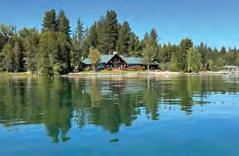

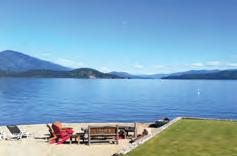
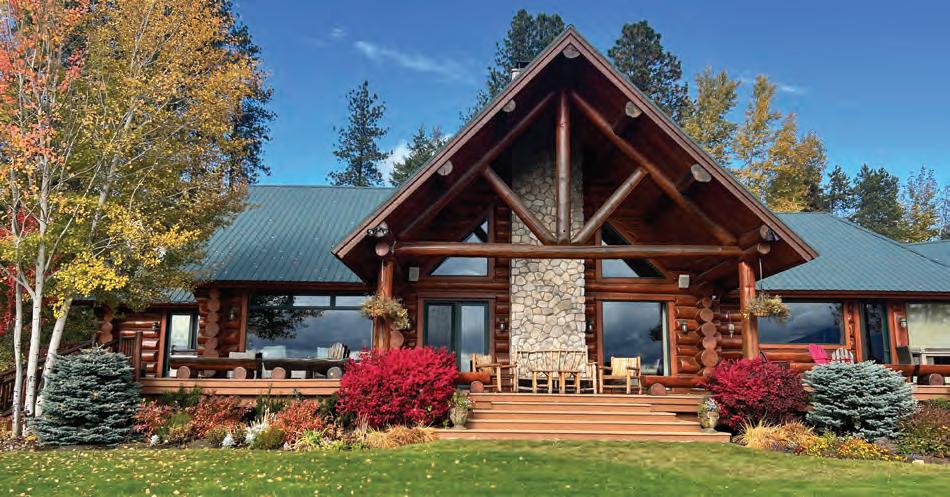
At the end of a quiet, tree-lined paved road, this custom Northwest Lodge-style log home offers 610’ of low-bank, crystal-clear waterfront. Just minutes from downtown Sandpoint, the 3.51-acre Oden Bay property is completely flat and usable to the water’s edge. With seven bedrooms, four full and two half bathrooms, plus two guest apartments (one with a full kitchen), a detached shop, and an art studio/guest space, this rare lakefront retreat must be toured to be fully appreciated. Offered at $8,000,000




This beautiful Bottle Bay waterfront home boasts a complete interior and exterior remodel. Featuring 4 bedrooms, 2 bathrooms, a manicured lawn, and a lakeside beach leading to your private dock, this is a spectacular opportunity. There’s also a second building site with pre-paid sewer!
$2,300,000
A rare opportunity to own a large 1.84 acre lot in beautiful Dover Bay! This lot boasts privacy, water access to Browns Inlet, open pasture land where the deer bed down, and a mature grove of Cedar trees. With four-season resort living at your doorstep, how will you choose? Will it be a day spent on the lake leaving from the full-service marina? Perhaps enjoying the 9 miles of beautiful nature trails in the Dover Bay community? Or maybe volleyball, tennis or just a day lounging at the pool?
$295,000
Just 3 miles from Sandpoint, this 5-acre property—potentially subdividable—has a 4 Bedroom, 2 Bathroom home with unique interior and exterior spaces. Complete privacy but great access on a county-maintained road, the home features a main-level primary and 2 living areas. Outside, a wraparound deck overlooks a fire pit, garden beds, mature trees & multiple storage buildings.
$959,000
A clean 5-bedroom home in Sandpoint. Outside, this home offers beautiful curb appeal, including a welcoming covered front porch, mature landscaping, a large, fenced back yard. There’s also covered patio, garden space, a fire pit and a storage shed. Inside you’ll find a spacious and open floor plan with a main level primary suite. $639,000
It s not enough to have the dream Live it.









Overlooking Lake Pend Oreille, this nearly new custom 4B/3B home in The Spires at Schweitzer blends elegance with functionality. The main living area features a gourmet kitchen, dining space with a stone gas fireplace, and a spacious living room with panoramic lake views. Two covered decks offer stunning views. With natural buffers for privacy, groomed ski access, a two-car garage, and rare overflow parking, this home is a true mountain retreat for year-round adventure. Offered at $2,450,000.
Welcome to Crystal View at Schweitzer! A truly unrivaled location just above the main resort, this ski-in/ski-out enclave offers an extraordinary opportunity to own a piece of the area’s most sought-after real estate. Crystal View boasts the most desirable view homesites with panoramas of Lake Pend Oreille, The Cabinet Mountains & Schweitzer Village. Lots starting at $750,000.
This condo evokes that quintessential mountain vibe with a welcoming remodel including hand hewn logs overlooking a tranquil snowy landscape. This top floor condo has 2 bedrooms and can sleep 7. There’s also a private laundry and a newly remodeled bathroom. Walking distance to lifts. $564,900
A comfortable studio condo with nice common amenities that easily sleeps four. Offering an open living area, a full kitchen and bathroom, and nice breakfast bar with storage. This building has a private parking, a large recreation room, a cedar sauna, laundry area as well as private ski lockers. There are great resort views from this front side condo with a walk out slider. Just a two minute walk to the ski trails. $380,0000
5 Needles at White Pine—Brand new, turn-key studio with stunning lake and mountain views ideally located in the Schweitzer Village. This fully furnished mountain contemporary condo features premium European appliances and all electric HVAC. There’s also new hot tubs, ski lockers, a fitness center and owner’s lounge. $699,000




structure remarkably sound and well preserved. "It reveals little stories—wear patterns on the wood from grain loading, and stunning views spanning east across the lake and west down the river," Chapin said.
The granary website (www.granaryllc.com) presents multiple study findings, a distillery prospectus and a feasibility study done by the Bonner County Historical Society & Museum. BCHSM Executive Director Hannah Combs emphasized the building’s significance.
"It’s an anchor of the Granary Arts District and one of Sandpoint’s most recognizable structures. Visitors may recall the ‘Long Bridge moment,’ but for many locals, the warm rusty color of the granary says, ‘Welcome home,’" Combs said. While BCHSM considered relocating to the granary building, the necessary investment required precludes that right now.
Combs said BCHSM still has interest in participating in any development and helping to preserve local history. Though the building is eligible for the National Historic Register, official designation could restrict renovation efforts.
Katie Egland Cox, executive director of Kaniksu Land Trust, said that the iconic structure is part of the community and is a building well worth saving. “The granary and its tall tower and faded red walls are emblematic of the history of this town and tell a story of yesterday. Our skyline would drastically change if we were to lose this historic structure as would our daily lived experiences."
The top of the building is filled with huge grain bins that could be removed to open the tower up. Holt pictures the top two floors of the building as a perfect space for a bar, cafe or gift shop, with a glass elevator and a spiral staircase accessing it.
While the costs to transform the structure into a stunning commercial or historic space would require a substantial investment, Holt said grants and wealthy investors have facilitated similar projects around the country. The idea of a corridor of community sprinkled with thriving businesses and lots of open green space represents the ideal as far as Holt’s concerned.
"We want to see this go to a use that benefits the community. If the right buyer comes along, we’re negotiable on price and terms," he said.
The idea of a park-like space with an outdoor skating rink, jogging path and music venue is exciting. However, with pressing city expenses like wastewater treatment and road repairs, public funding is unlikely.
The city and state’s relationship with the granary has been complex. Holt recalled battling transportation plans, specifically "The Curve" project, a realignment of Highway 2 and its junction with Pine Street which once threatened the building before community efforts successfully halted demolition.
Community Planning and Development Director Jason Welker stated, "We’re not aware of plans to build out the Curve in the next eight to 10 years. I wouldn’t expect Idaho Transportation Department’s plans to impact the granary tower, but prospective buyers should do their due diligence."
Architect Chapin summarized the granary building’s potential best: "So much about this district is already beloved. How amazing would it be to continue the building’s story and bring the community inside once again?"
The next steps depend on finding the right mix of investment, community engagement and municipal support to ensure the granary building remains a cornerstone of Sandpoint for years to come.

Granary building co-owner Steve Holt has been a fixture in Sandpoint for decades, notably co-founding the Lake Pend Oreille Waterkeeper in 2009 and leading it until its transition to the Idaho Conservation League.
Since moving to Sandpoint in 1993, Holt has championed local causes, co-founding the Bonner County Area Transportation Team and launching the Eureka Institute in 2011 to promote lifelong learning. Through the institute, he spearheaded programs like the Construction Basics Initiative, offering hands-on vocational training.
“It’s been a good run,” Holt said. “If I were 40, I’d be beating the drum loudly to keep evolving this Granary District project. But after 67 years, I’m ready to pass it on.”
Looking ahead, Holt plans to split his time between Sandpoint; Bend, Oregon; and Bellingham, Washington, balancing family life with his love for the outdoors.
–Barry Campbell








Two gorgeous waterfront lots…The “West Lot” offers 291’ of south facing low bank water access, a private inlet and build ready status. The “East Lot” is also build-ready and offers 170’ of lakefront perfection. City water and sewer are available to both. Over $1M of site improvements have been completed, including full rip-rap protection, multiple sets of granite steps and patio areas and build-out to full Geotech site specifications. Come enjoy warm, clear, sunny sparkling waters for best in class swimming and recreation. Revel in the sweeping views with spectacular sunrises and sunsets, and shimmering splendor all day. Here you’ll have sunny year round exposure in peaceful and pretty neighborhood and a private and serene setting. Rare jewels in our lakefront paradise, these beautiful properties are just moments from downtown Sandpoint at the end the desirable Ponder Point Lane and along the serene and idyllic shores of Lake Pend Oreille.




by Cate Huisman
Afew years ago, a developer wanted to buy a large piece of empty land northwest of the airport for a residential development. But he couldn’t just go ahead and build houses on it, because it was zoned for industrial use, not housing. So he asked the city’s planning and zoning commission to rezone the land. They agreed to recommend a rezone to the city council, because the city badly needed more housing.
But one city commissioner, Forrest Schuck, voiced concerns. Living-wage jobs, he pointed out, would come from small industries and commercial and logistical operations. Such companies would need relatively large plots of land on which to build warehouses and workshops. The acreage the developer wanted was one of the last large pieces of undeveloped industrial land
in the city.
Ultimately, the city council voted against the rezone, reflecting Schuck’s concern as well as safety concerns about having residences so near to the airport. This spring, at press time, 10 acres of that land is now being developed—under the name “Project Bulldog”—for a 25,425 square foot warehouse distribution center. The tenant remained unnamed, but as the lot was being prepared in March, city residents received large postcards in their paper mail touting the advantages of jobs with Amazon. The postcards suggested average wages would be over $22 per hour as well as “health care on day one.” Not the kind of job that makes anyone rich, but closer to the living-wage jobs that Schuck was talking about.
The city has zoned approximately 530 acres for industrial


“
This takes the approach of growing local businesses rather than working to land a new employer. The key is to provide an environment where small businesses can grow into bigger ones while staying in Sandpoint
As this issue went to press, progress was ongoing at the site
what’s

uses, although it restricts such use to light industry that is unlikely to cause excessive noise or pollution. The area in question is particularly well suited to meeting the needs of these employers. There’s enough room for large buildings with truck bays. It’s accessible by road from north and east without going through downtown. And it’s close to the airport for bringing in raw materials and shipping out finished goods.
But the fact that the land is zoned for industrial use is important also. Sandpoint’s zoning code allows specific business activities by right on industrialzoned land, including “wholesale storage and distribution”—like an Amazon delivery station, if speculation is correct. Although there are requirements for public notice and comment when such activities are proposed in these areas (21 comments were received, most in opposition), the zoning indicates that the local community welcomes such activities and has reserved this area for them. This allows companies to move forward with confidence when they consider whether to set up operations in Sandpoint.
And Sandpoint has some other advantages that other places don’t. Quality of life is a big one—the lake and mountains are appealing to potential employees. Our airport is also a big draw—it’s associated with more than 800 jobs in our community. Sandpoint’s recently adopted comp plan specifically encourages development around the airport, and a significant majority of our industrial-zoned land is close to it. The
state of Idaho also helps out by offering a tax reimbursement incentive to new or expanding businesses.
So, are new businesses looking to relocate here because of all we can offer? “Always, yes,” said Sandpoint Mayor Jeremy Grimm. “However, once they reach a certain size, these businesses become the target of others,” and the others often want to move the business away. “We want ‘sticky’ businesses,” says Grimm, “those not inclined to move their workforce or production from the area.”
So the mayor’s focus is to keep the growing businesses we have. “I prefer the model of economic gardening. This takes the approach of growing local businesses rather than working to land a new employer. The key is to provide an environment where small businesses can grow into bigger ones while staying in Sandpoint.”
Timberline Helicopters is one such business. It was started in Sandpoint 20 years ago as a helicopter logging company. Now it provides helicopters for a wide variety of purposes around the country and the world. But it’s keeping its base here, with plans announced this spring to add 24 new jobs at its facility near the airport.
So the council’s foresight and the mayor’s strategy are starting to pay off. Nobody wants our community, with its heritage of hard work outdoors, to turn into just a tourist town. And our industrial zoning just might enable us to prevent that.


Moving into summer—historically a time when the real estate market begins to hop—buyers, sellers and Realtors are all waiting to see what’s going to happen with interest rates. “While price is obviously a big determining factor in any home search, the interest rates play a huge role,” explained Brian Jacobs, president of the Selkirk Association of Realtors. At its heart is a simple premise: as rates go up, buying power goes down. Those interested in the market have been hoping to see a decrease coming, but it’s not yet happened.
“Do I think that interest rates are slowing things down? Of course I do,” said Jacobs. “The reality is that this is affecting real estate sales across the entire country.” But North Idaho remains an attractive market for buyers who are looking to buy now.
And they have more options to choose from. “I feel like inventory has recovered to a great extent from what we were experiencing just a couple years ago. The influx of buyers from the pandemic certainly took its toll on our available properties. In February of 2020 the Selkirk MLS had somewhere in the area of 1,400 active listings,” said Jacobs. “Fast forward one year, and in February of 2021 we were down to around 400. This kind of activity impacted our business greatly but we have recovered to a large extent.”
“We have a lot of new construction going on and development is happening at a swift pace,” said Jacobs. “While we have recovered somewhat, it can be tough to navigate the available properties in our area on an individual level. This is where the value in your local real estate professional comes into play. We have access to many tools to help buyers find just what they are looking for.”
The homes are here… and so are the buyers. “It may come as a surprise to some, but a healthy proportion of our current buyers are from the local area,” Jacobs said. “The summer, ideally, brings a vast amount of tourism to our area so naturally, more people from out of the area may discover what we have to offer and decide to purchase.
“We certainly have endured some ups and downs in the market since the beginning of 2020 to present day. We were hot. I mean, really hot. Then we were cold. As we should’ve been. We had two really strong years of activity and with that comes a natural period of correction. I feel like we are coming out of that now and trying to move back to something that looks like normal—whatever that means!” Jacobs said.
–Trish Gannon
Advanced Drywall Concepts provides a wide range of drywall services from small drywall repairs to complete remodels, and commercial & residential jobs. Whatever your drywall needs are, we can help you improve and complete any project.






$12m
$10m
$5m
$3m
$2m
$1m
$500k
$0
October 2024 through March 2025
Sales data based on information from the Selkirk MLS for the periods indicated. Information is deemed reliable but not guaranteed. Statistics are based on the period October 2024 through March 2025 unless otherwise stated.
Single family homes sold by month
Total Value Single Family Homes Sold Bonner County
Average Median Price Single Family Bonner County
Median Price Single Family Homes Bonner County
Average median price of homes for a single family Bonner County
October $774,900
November $550,000
December $516,900
January $507,900
Average days on market residential properties
February $599,700
March $525,000
b single family Sandpoint City
Expect to pay
October $667,000
November $494,000
December $489,700
January $507,900
of listing price
Bonner County (vs. same time frame last year)
February $538,034
March $521,750
c single family Bonner County lakefront
October $2,497,500
Residential numbers sold 246 vs 247
November $862,000
Oct - 866,666
December $0
January $11,900,000
February $0
Nov - 645,203 Dec- 593,580
Residential waterfront sold 24 VS 27 % Change: -11%
March $750,000 $1m
Jan- 425,000 Feb- 518,535
Mar- 500,000
Historical Median Sales Price for Bonner County, Homes & Land
$600k
$500k
$400k
$300k
$200k
$100k
$0







After several trips to check out North Idaho, two families moved here in the past year—one large family from Henderson, Nevada, and another from Fort Collins, Colorado—to create homesteads away from the unsettling influences of big cities.
Our natives are both young, at 29 and 30, and each spoke of

Nicholas and Shannon Rennie moved to Bonner County in mid January from Henderson, Nevada to raise their eight children in a country setting. Their goal was to establish a homestead away from big-city influences.
The couple found a seven-acre tract of land off Lakeshore Drive and are in the process of building a large garden and a coop for a flock of chickens. Nicholas is originally from Michigan but lived the past 18 years in Henderson. He holds an advanced degree in statistics.
In their spare time, the couple likes to hike, read and to play board and card games with their children.
their safe and happy childhood, one in Clark Fork and the other in Sandpoint. Both expressed the challenges of living in an economic climate that has changed considerably.
In this story contrasting experiences of natives and newcomers all four share one thing: a deep appreciation for living in North Idaho.
Was your motivation to move here driven by Sandpoint’s recreational opportunities or political reasons or something else entirely?
There were many reasons. The main one though was that we wanted to move our children out of the city and into the country where they could learn about God and nature in a way that was becoming increasingly difficult in the big city. We wanted a tight-knit, rural Catholic community in the western U.S. with good homesteading potential.
Did you come here with employment or was your plan to search for a job?
I work remotely as a data architect for an aerospace manufacturing company.
How do you find the schools?
We homeschool our children—three girls and five boys, ages 2 to 15.
What are the positives about living here? The challenges?
We love the community, the natural beauty surrounding us, and the ability to start our homestead.
Leaving family was hard and continues to be so. Also, com-


VP of Mortgage Lending
and the newest member of the
VP of Mortgage Lending



ing from a place that has 300+ days of sun a year, it’s been a challenge dealing with long stretches of cloudy, rainy days. We must be starting to acclimate, though. When it hit 65 degrees recently with full sun, the kids and I agreed it was too hot and we went inside!
Is there something that has surprised you about living here?
We talked to several folks from the area and did a lot of homework before coming up here, so we had a fairly good idea of what to expect. Even with that, I’ve got to say the people have surprised me. The quality of the people up here—the vast majority—just astounds me. I grew up in the Midwest and have known a lot of good people throughout my life. Still, I’m blown away by the sincerity, capability and friendliness of the folks up here.
I have lived in North Idaho since 2007.
I have lived in North Idaho since 2007.
I have been doing mortgages for 20 years and I still love it!
I have been doing mortgages for 20 years and I still love it!
My family means the world to me and I am forutnate enough to provide for them while helping other families with one of the biggest purcahses of their lives.
My family means the world to me and I am fortunate enough to provide for them while helping other families with one of the biggest purchases of their lives.

My strength is developing long-term relationships with my clients and with agents, and those relationships are the cornerstone of my business.
My strength is developing long-term relationships with my clients and with agents, and those relationships are the cornerstone of my business.
Customer Satisfaction Rate
Danielle Largesse, 29, is a Sandpoint native who was born at Bonner General Hospital during one of the worst winter storms of 1995, to Tina and Patrick Garity. She has an older brother in Sagle and a younger sister residing in Bonners Ferry.
"Top service from start to finish, Lee Hardin, Robyn and the whole team were responsive to messages, kept us in the loop the whole time and were very professional and friendly throughout."
–Danielle B. 2020

cannot guarantee that an applicant will be approved or that a closing can occur within a specific
She went to the Head Start preschool and attended elementary at Washington and Farmin schools. A 2014 graduate of Sandpoint High School, Largesse went on to attend North Idaho College. At age 16 she began working at Silverwood, followed by a four-year stint at Walmart, and then two years at a local daycare center. She is now the periodicals coordinator at the East Bonner County Library. She is taking courses to earn the Library Support Staff Certification and
has higher educational aspirations in the field of library science.
She and her husband Andrew have a 5-year-old son.
Do you remember any teachers in Sandpoint who influenced you positively?
Yes, two, though I had a lot of good teachers. Miss (Barbara) Tibbs taught English at Sandpoint High School and she pushed me to be independent. She was one of the hard teachers, but she helped me develop my thinking. Another was Mr. (Scott) Fitchett, who taught government. He had us enact a congress in our class and taught us to question everything.

Do you feel like you can readily afford to live here?
No, it’s not affordable. We live in a 22foot travel trailer in Trestle Creek, a nice little community. The land we park on is $600 per month. I remember when you could rent a three-bedroom house for that. For a while we were homeless and lived in a shed on my brother’s property in Sagle. We insulated it and then got a loan for the trailer and are watching the market for a bigger one, but meanwhile we spend a lot of time outdoors and go to my parents’ bigger RV next door. We know we may never be able to live in an apartment or a house.
What do you miss about Sandpoint that is no longer around?
I miss the affordability. Most of us are just surviving. I would love to shop at the mom and pops but due to financial constraints, I must shop at Walmart. I felt so depressed when the trees were cut down on the former University of Idaho property on Boyer—for houses only outsiders can afford. And I must say I will never pay to park at Sandpoint City Beach.
What are some fun memories?
When we lived near Washington Elementary, we would walk to Dairy Depot and my dad would buy us ice cream. I was best friends with Bri Brown and we used to walk to the library and hang on the “grassy knoll,” then walk down Cedar to Mr. Sub, which her parents owned. There weren’t as many afterschool activities for kids then as there are


now, but we had freedom and we liked to explore. What is it you like to do in Sandpoint? Outdoor recreation?
We have enjoyed the ice skating. Our son plays T-ball and we like dirt bike riding. In the summers we can walk across the road and go swimming at the Trestle Creek recreation area. Why do you stay here?
I can’t leave. My family is here and I love my job. I literally grew up in this library. I remember when the young adult section was one shelf. Look at it now!
Is there any way Sandpoint could improve?
More kindness. Not so much greed.

Roscoe Cummins, 45, is a Sandpoint newcomer who moved to the area in August 2024 from Fort Collins, Colorado with wife, Kelli, and their three children. Cummins, originally from Ohio and West Virginia, holds a B.S. degree in business administration from Colorado State University. Moving to Sandpoint was not a hasty decision. The family waited out COVID and then visited towns in Colorado close to a ski area, but the affluence required to live in those locales motivated them to expand their search to Montana and Idaho. The criteria: It had to be the right ski team for their children, the right church, and the right real estate agent who could locate acreage for a young family who wants to cultivate a more sustainable lifestyle. Apparently, they hit pay dirt: “Sandpoint had it all—100 percent.”
Cummins said he’d never heard of Sandpoint until they traveled north in the spring of 2023, “but then when we talked to people about it in Fort Collins, everyone we knew had a connection to Sandpoint. One of my daughter’s teachers had moved to Fort Collins from Sandpoint.”
Was your motivation to move here driven by Sandpoint’s recreational opportunities or political reasons or something else entirely?
My kids are all on ski teams. We were driving one and onehalf hours to Eldora (ski resort). We came up to (Schweitzer) to meet with the ski team and SARS. We went to St. Joseph’s Catholic Church and checked it out. We are active outside; we hunt and fish. We wanted a town with a ski area, but not a ski area with a town, because with that you get ski-town problems. I have worked at ski areas and in ski shops.
We believe we have found a high-trust community here. Our realtor found five acres we are developing 20 minutes from town by the Idaho Club.
Did you come here with employment or was your plan to search for a job?
I do fractional CFO work and I bought the domain name Northern Lights Financial Services before I knew about Northern Lights, the power company. We help businesses increase cash flow by giving them information they’ve never had. I have an office in the Pioneer Square building.
How do you find the schools?
We home school. There is a flexibility that comes with it. We’ve found good support programs through the Catholic church, sports teams and community home-school groups. Having kids helps to break down the barriers to establishing community.
Is there something that has surprised you about living here?
Yes. I am surprised at the growing season. It is longer here than in Colorado, and it’s not as cold as we thought it would be.
Tess Vogel, 30, is a native who works as an associate land use planner at Ruen-Yeager and Associates, Inc., in Sandpoint. She was raised in the Hope-Clark Fork area where her family owns a hay farm and cattle ranch—Vogel Beef. She is a 2013 graduate of Clark Fork High School who studied geography and climate change at the University of Idaho, earning her Bachelor of Science in 2018. In 2021 she completed a Master of Science degree in bioregional planning and community design at the U of I.

Were you influenced positively by any teachers in your early education?
The most influential teachers I had were my fourth-grade teacher, Mr. (Bird) Nietmann and my fifth grade teacher, Mrs. (Jill) Albertson at Hope Elementary School. Mrs. Albertson was and still is one of the kindest, most open, understanding and loving people I have ever met. Her individual attention to each of her students would continue for years after we left her class. I don’t even know where to start with Mr. Nietmann. He embodied the definition of fun-loving and entertaining. From the rainforest project every class could not wait to do, to the expressive ways he would read to us, to getting on top of the cafeteria tables and singing “Cheeseburgers in Paradise.” I only wish there were more teachers like them.
Do you feel like you can readily afford to live in Sandpoint?
The real estate market has understandably changed over the


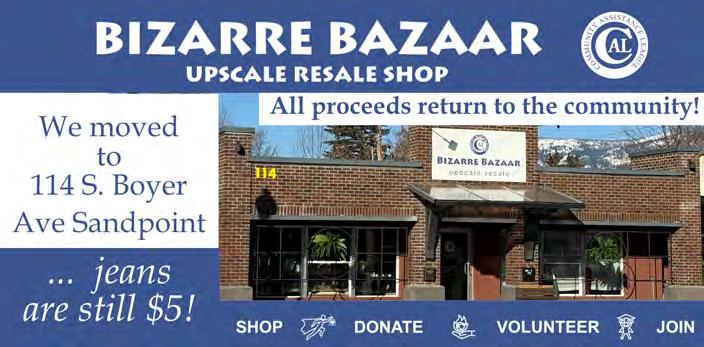

years but what I and many others who grew up in Bonner County are experiencing in looking at home ownership is that our once “affordable” hometowns now have real estate prices that couldn’t have been dreamed of just 10 to 15 years ago. That is one of the reasons that my first home ended up being in Boundary County. It was my maternal grandparents’ home and the market in 2019 wasn’t exploding in Boundary County the way it was in Bonner County. I am planning on moving back to the Clark Fork area because I am fortunate enough to have family land options. Without that, the options would be much more limited, and I don’t even really look at real estate in and around the Sandpoint area due to prices. With the job I have, I do feel I am able to afford the amenities of living in this area.
What do you miss about the Sandpoint area that is no longer around?
Hands down, it would be the Sandpoint Cinema 4 movie theater that was demolished to make way for the Panhandle State Bank back in 2006.
What are some fun memories?
The best memories I have are participating in the Sandpoint Rec sports in grade school and junior high—rec soccer, rec basketball and rec volleyball. I would like to thank all the parents who volunteered to coach our sports teams all those years and the parents and community members from Clark Fork who would come and support us.
What is it you like to do in Sandpoint? Outdoor recreation?
Anything outdoors—hiking, hunting, golfing, boating. I love to watch my young cousins participate in their activities. Those I do mostly in the Clark Fork/ Montana area, but Sandpoint has quite a few options for restaurants and nightlife.
Why do you stay here?
While the wonderful job I have is obviously an incentive to stay in the area, it hasn’t been the determining factor—my family and the family business, the cattle ranch, are here. Besides, I’d miss out on the milestones of my younger cousins. And, of course, where could you beat the views… and Lake Pend Oreille?
JULY 24
NEON TREES
JULY 25
SIERRA FERRELL
JULY 26
TOAD THE WET SPROCKET WITH SEMISONIC & SIXPENCE NONE THE RICHER
JULY 27
THIRD EYE BLIND


JULY 31
BROTHERS OSBORNE
AUGUST 1 KANSAS
AUGUST 2 DISPATCH
W/ JOHN BUTLER (WITH BAND)
G. LOVE & SPECIAL SAUCE DONAVON FRANKENREITER
AUGUST 3
GRAND FINALE

SOUNDS OF SUMMER




by Renée Sande
With no less than 300 charitable organizations in Sandpoint, local breweries and taphouses get their share of requests to help their community. The good news? Empowering them to answer the community’s call is as simple as grabbing a cold one.
“We have a really clear vision of what it means to be community-driven, and that means being present in our community, hearing the needs in real time and responding,” said Andrea Marcoccio, who co-owns Matchwood Brewing Company with husband Kennden Culp.
“We feel lucky to be in the center of that and get to say ‘yes’ a lot,” she added.
The couple moved to the area 10 years ago, when
they decided that their interest in craft beer and desire to be closer to family made Sandpoint the ideal location to start a brewery.
Now in their seventh year in the historic Granary Arts District, Matchwood’s Community Can program has become their signature initiative.
Artsy, co-branded cans sold in four-packs have so far helped Kaniksu Land Trust save Sandpoint’s beloved “sled hill” of 50 years and the Sandpoint Reader newspaper to continue its weekly operations, just to name a couple of beneficiaries.
“These pillars of our community are what make Sandpoint so special,” Marcoccio said. “When we choose a recipient, we ask ourselves, if this thing went away, would [our town] feel the same, or would it feel just like



any other PNW town?”
Brother duo Mickey and Duffy Mahoney decided to give it a go with MickDuff’s Brewing Company almost 20 years ago. Originally located on First Avenue, MickDuff’s moved their brewpub into the historic federal building (built in 1927) on Second Avenue in 2019, but they credit their first location with their success. Duffy said that’s where they learned community support would be key to the business’ longevity.
“Anything and everything for the community,” Duffy said. “We learned early on that tourists are good, but without the locals, you don’t succeed.”
To give back, MickDuff’s—which also has a beer hall at 220 Cedar Street— hosts an annual fundraiser for the Idaho Panhandle Avalanche Center and also sponsors Pend Oreille Pedalers and Community Cancer Services.
“There are so many great nonprofits in Sandpoint doing good things,” Duffy said. “From hosting events to donating













Above: Matchwood’s Andrea Marcoccio, center, hosted the “Live Give 7B” event, which culminated with the presentation of a $20,000 check from the Innovia Foundation to Panhandle Special Needs. She was joined from right by Innovia field rep Dig Chrismer, leadership council members Becca Orchard and Heather Upton and PNSI’s Trini Nicholson. Courtesy photo.





time, we like getting involved in a bit of everything.”





The same applies to fellow Cedar Street mainstays and pint-slingers Idaho Pour Authority and Eichardt’s Pub. While Idaho Pour Authority is known for its monthly nonprofit benefits, Eichardt’s has a long history of supporting a number of causes. Chief among them is the beloved annual K9 Keg Pull, which serves as the finale of Sandpoint’s Winter Carnival and raises funds for Better Together Animal Alliance.
Another business with local pups close to its heart is Utara Brewing Company. Opened in 2018, owners Dave Kosiba and Christina Stecher were unsure if the community could support another brewery. It wasn’t long before they discovered Sandpoint was eager to welcome them.
Located at 214 Pine Street—home to the first blacksmith shop in Sandpoint in 1908—the business not only serves up a new brew weekly, but also Indian fare and beer cocktails made with handmade syrups and curated cordials. Aside from the pints and plates, Utara also serves up its share of community contributions.
Utara has been known to raise funds for BTAA by organizing “breed reveals.”

“You donate $10 at the brewery to guess the breed of a BTAA dog and get the chance to win a beer pairing for six,” said Stecher. “Leading up to the ‘reveal,’ we get the dog out and about as much as possible, with the hopes that someone falls in love and adopts him or her. It’s been a really fun and heartwarming experience.”
The couple also supports KRFY public radio, Kaniksu Land Trust and North Idaho CASA, which supports child abuse and neglect victims in North Idaho. In addition, when Laughing Dog Brewing announced the closure of its taphouse in March 2025, Utara absorbed Laughing Dog’s mug club through October, honoring the patrons’ claims to special deals on their pours.
“We love Sandpoint and being a part of the brewing community,” Stecher said. “There’s nothing like it.”

B’s Beacon at Hotel Hope has a
by Lyndsie Kiebert-Carey
hen a restaurant opens, there is a lot of talk about what the owners are hoping to create for their clientele. From food to atmosphere to service, aspirations provide a glimpse into personal style and philosophy. This is true of Antone and Brianna Changala, the brother-sister duo behind B’s Beacon at Hotel Hope. A conversation with the pair covers all of those aspirations, but it also goes beyond plates and impeccable service to cover a more transcendent goal: to build a place of work, personal growth and belonging for North Idaho’s next generation.







Brianna and Antone spent decades at the Floating Restaurant at Hope Marina working with owner Elissa Robbins, and had ambitions to one day own and operate the Floater themselves. While that particular dream didn’t come to fruition, the spirit of the dream lives on at B’s Beacon, located on the ground floor of the historic Hotel Hope, built in 1897.
The siblings said they owe a lot to Robbins.
“To be able to learn [the restaurant business] and not have to leave the area that we live in and love, and be able to continue on, is pretty beautiful,” Brianna said.
Brianna manages the front-of-house operations, often found behind the bar interfacing directly with customers, while Antone handles back-of-house operations in the kitchen.
“I think for a restaurant to be successful, it’s hard to have one person in those two roles,” Antone said. “It takes a lot off her shoulders when she doesn’t need to worry about the food. It takes a lot off my

Now Available With






shoulders when I don’t have to worry about the book work, or the front of the house. There’s a separation of powers there.”
The B’s Beacon menu sees regular updating, with Chef Antone always committed to quality. A variety of proteins—from prime rib to lamb to fresh fish and scallops—are in constant rotation, as well as housemade sides and sauces.
“It is all over the board, but it is all high quality,” Antone said of his cooking style. “I’ve worked on each item on that menu to get it up to where we want it. There is no filler.”
On the service side, frequent Floating Restaurant diners will remember Brad Banks, who moved to the area about five years ago.
“His ability to connect with people is priceless,” Brianna said of Banks.
He’s one of a handful of B’s Beacon crew members who Brianna and Antone have made a part of their extended family, and has become a fixture of Hope’s dining scene.
“People walk in here with a smile just because they’re able to be in here,” Banks said of Hotel Hope, which remains a private residence as it leases to B’s. “Then they leave with a smile after a great experience.”
Brianna’s two children, along with other young adult employees at B’s Beacon, are a huge part of the Changalas’ “why.”
“They are learning work ethic, and that will transfer to anything they do in life,” Antone said.
B’s Beacon is named for Brianna, as well as for its location—a focal point on Hope’s mountainside. But the Changalas also want it to be a beacon of hope for local youth who envision a life for themselves on the shores of Lake Pend Oreille.

B’s Beacon is proof of what’s possible when local kids receive the investment and love of a community. Now, Brianna, Antone and their whole team is seeing that those gifts make it to the next generation.
“How lucky are we,” Brianna said, “to be able to keep going?”





by Lyndsie Kiebert-Carey
Between the bustling Sandpoint dining scene and the burgeoning seasonal restaurant options on the lake in Hope, there’s a hidden gem tucked behind the trees and nestled on the bank of the Pack River.
The Clubhouse Restaurant, part of the Idaho Club golf course and gated community, is open to the public and strives to offer a dining experience to remember.
“We know we have a beautiful building right here on the Pack River,” said Idaho Club General Manager John Herndon, “so we wanted to create a dining experience to match.”
At the helm of that effort is Executive Chef Mike Drabowski, who came to the Idaho Club after leading the kitchen at the since-closed Sandpoint dining hotspot Forty-One South. A Sandpoint native, Drabowski began his career on Schweitzer before his formal training at the Seattle Culinary Academy and further development at notable Tom Douglas restaurants.
Drabowski brings his extensive knowledge of eclectic, northwest-style dining to the Clubhouse. Vegan and vegetarian options, alongside high-quality proteins and fresh salads, round out a menu that sees regular updates.
“It’s not pretentious food, but it’s good food,” Drabowski said. “It’s all scratch made. That’s something I’m very passionate about as a chef—everything in my kitchen is made from scratch. I don’t buy salad dressings. I don’t buy desserts. If it’s served to you here, it’s made in house.”
The Clubhouse Restaurant boasts a full bar and expansive dining space, with the possibility of a wildlife sighting far from slim.
“We have one of the best patios in town,” Drabowski said.
As potential diners plan their next adventure outside city limits, Herndon said he hopes they might consider a meal at the Clubhouse.
“It’s really important to us to be welcoming to the community,” he said.






Respecting the summer hustle with The Float House’s Emily Evans and Sweet Lou’s’ Meggie Foust
by Lyndsie Kiebert-Carey
Anyone who has worked in dining has their share of busy shift stories, when there wasn’t a moment to breathe between clock in and kitchen clean up. Local restauranteurs are some of North Idaho’s hardest workers during the summer months. Among them are Emily Evans, general manager at The Float House in Hope, and Meggie Foust, owner of Sweet Lou’s, with locations in Ponderay, Athol and Coeur d’Alene.
Sandpoint Magazine: Describe an average summer day at your business. How many people will you expect to serve? What is the energy like in the restaurant?
Emily Evans: The restaurant is definitely buzzing with “summer vibes.” You have friends and family reuniting, endless activities on the lake, not to mention the best sunsets on our patio. You pair that with amazing summer cocktails and unique, flavorful menu items, all while floating on the beautiful waters of Lake Pend Oreille it just doesn’t get any better than that. During peak months we will serve upward of 500 guests.
Meggie Foust: Summer days are exciting and busy at Sweet Lou’s, especially in Athol and Coeur d’Alene, where guests can enjoy our patios. From the minute we open the doors until the last beer is poured, the energy is always vibrant. Any day of the week we can expect to serve 450 to 800 customers per location.
What are some of the skills you use to help make it through the busiest shifts?
EE: We are very lucky to have a strong team dynamic. … It’s all about balancing efficiency on those hectic days. Important skills are time management, multi-tasking, physical stamina and, most importantly, resilience and positivity.
MF: We are all about teamwork at Sweet Lou’s. If you can help the person next to you, do it. If you can re-stock and clean for the shift after you, you’re setting up your teammates for success.
What is your advice to potential diners headed into peak season?
EE: Patience. I think it gets forgotten that we live where everyone else chooses to vacation. We are here from open to close to ensure our guests have the most enjoyable experience possible… You’re on the lake to enjoy your time, so when the restaurant is slammed, just be patient and kind, for our staff has been hustling all day in 90-degree weather to ensure everyone has the incredible experience they came for.
MF: For locals, be patient and be prepared to wait. In the summer, our population explodes there are more orders to fulfill. We are doing our best to serve everyone. For visitors, if there is something wrong with your dish, please let us know and give us a chance to make it right. It’s frustrating to read a review about a problem we could have easily fixed. Also, takeout may not always be available. Our number one goal is to take care of the people sitting at our tables and bar top.
When you’re not on a job, how will you enjoy this North Idaho summer?
EE: Being the general manager will not give you much time, so it’s all about making the most of that time. If I can get a few hikes or beach days in with my family, a couple country concerts under my boots and Sundays on the lake, then I will be happy. Thank God my sister’s boyfriend has a boat!
MF: On or near the lake as much as possible.




by Pam Webb
Grabbing a quick bite isn’t limited to franchise drive-ups. One consideration is the delectable menu variety of food courts, an extension of the popular food truck model. In and around Sandpoint, there are three main food courts. For the most current hours, give them a call or check out their social media.
OAK STREET Located across from Farmin Park; convenient while attending downtown events like the Farmers’ Market at Sandpoint.
Mountain Food Company, in its bright yellow trailer, has earned a reputation for great cubanos, burgers and sandwiches. Owners Kevin Kenney and Kristen Redman look forward to sharing their talent and passion about putting fresh ingredients together with customers. Open every day but Tuesday / 208-627-7419 / www.mtnfoodco.com
La Catrina has served Mexican fare for six years. Server Martin Rodriguez believes keeping the food simple and authentic by using owner Nati Dorantes’ family recipes is what makes their menu stand out. Inquire for veterans’ specials. Open Tues-Sat / 208-568-0008
BONNER MALL Near Sandpoint Cinema; grab a bite at this food court before or after watching the latest flick.
Beet and Basil, formerly downtown on First Avenue, creates from scratch a




world street food menu utilizing local produce. Manager Jeremy Holzapfel notes that going from a restaurant to a food truck means more personal encounters with customers, an aspect of food service he values. Look for them at The Festival at Sandpoint. Open Mon-Fri / 208-627-7715 / www beetandbasil net
Loco’s Kitchen specializes in serving up Mexican cuisine with an added twist that blends modern tastes with traditional recipes. Owner Alexandra Ibarra says their recipes are straight from the streets of Mexico. Open Mon-Fri / 208444-7932 / www.locoskitchen.com
KOOTENAI CUTOFF Next door to Better Together Animal Alliance, this accessible eatery choice expands lunch options beyond traditional fast food while out running errands.
Taco Taco owner Jimmy Lomeli has been in the business 12 years (previously located near Squeaky's) and serves his family recipes from scratch. His stand sees a steady clientele grabbing their selection of burritos, tacos and quesadillas throughout the year. Open Mon-Fri / 208-304-1335
Little Munich owner and Munich native Petra Schoetz, dressed in her colorful dirndl, cheerfully serves her customers unique, authentic German food such as Bavarian potato salad, kasespätzle and lebkuchen. Open Wed-Sat / 208626-5011 / www visitlittlemunich com
All food courts provide covered areas to sit down and savor menu selections. Inquire about catering.
with Lyndsie Kiebert-Carey
While the winter saw news of Monarch Mountain Coffee’s cafe at 119 First Ave. closing after 13 years, this spring that address is seeing new life and a new look.
Pivo Peaks Alehouse owners Joey and Sara Bowden have been hard at work restoring the location, digging down to the old bones of the early-1900s building to elevate the ceiling and prepare to welcome thirsty patrons to enjoy 24 taps, hoagie sandwiches and more.
At the time of publication, Sara said Pivo Peaks could open its doors to customers sometime in July, but keep an eye on the business’ Facebook and Instagram pages for updates.
Also seeing a new look will be Utara Brewing Company (214 Pine St.), whose Pine Street location will see a major expansion of seating as it moves its brewing operations to a new building at 2617 North Boyer Ave.
“This will allow the production room to flawlessly operate at the capacity we have planned,” said Utara owner Dave

Kosiba. “The additional seating [at the Pine Street location] will [help] us comfortably accommodate the busy nights we routinely have and will no longer subject the public to the occasional industrial pump running while we are open.”
Kosiba said Utara’s new Boyer location will play host to occasional tasting hours and events. For the most updated information, he recommended following Utara Brewing Company on social media.
While locals know Utara has been slinging Indian and Indian-inspired eats since opening in 2018, Sandpoint’s Indian cuisine scene saw expansion in the past several months thanks to the addition of Mango Tree (102 S. First Ave. Ste. 101) in the former location of Ivano’s and Blue Room, as well as Tandoori Grill (202 N. Second Ave.).























Also new and notable is Paneah’s Bistro (334 N. First Ave. Ste. 200), located upstairs in the Cedar Street Bridge. Boasting a sizable menu of hot and cold drinks, as well as sourdough cinnamon rolls and other good eats, Paneah’s hopes to establish itself as a revered meeting place among Sandpoint’s cafe culture. Neighbor Sunshine on Cedar (334 N. First Ave. Ste. 208) is also new on the scene, offering Hawaiian cuisine along with wine, beer and canned cocktails.

















Shifting to Sandpoint’s bar scene, Mitzy’s Lounge and Bar (807 N. Fifth Ave.) saw a rebirth in the spring, opening Thursday through Sunday at noon each day.

Meanwhile, local dining has also bid farewell to a number of businesses since the fall, including Simply Pho and Bubble Tea Bar (476534 U.S. Hwy. 95 Ste. B) in Ponderay, as well as Savory Neigh-


borhood Grill (120 S. First Ave.), which occupied the former longtime home of Panhandler Pies for less than two years. Upon its closing in January, Savory encouraged customers to “stay connected with familiar faces and tasty meals” by heading to Farmhouse Kitchen BBQ (477227 U.S. Hwy. 95) in Ponderay, which has shared ownership.
Connie’s Cafe and Lounge (323 Cedar St.) welcomes diners to its newly renovated upper dining room, which has “historic photos of Sandpoint and the surrounding area” along with


Far left: Sara and Joey Bowden stand at the job site of what will become Pivo Peaks Alehouse, inside the renovated former location of Monarch Mountain Coffee. Staff photo.
Left: Patrons enjoy a cold beverage at Smokesmith Bar-B-Que, which has a full lineup of live music this summer. Courtesy photo.
“new booths, brighter surroundings and a lovely new sign.” The large sign proudly displays the cafe and lounge’s home since 1952: “SANDPOINT IDAHO 7B.”
Connie’s has also stepped up its event game, with a full slate of live music, food specials, pool, cribbage and trivia each week which is shared on social media.
Writing of events, Smokesmith Bar-B-Que (102 S. Boyer Ave.) is making the most of its prime location at the intersection of Boyer and U.S. Highway 2 by ramping up entertainment this






summer to include live music every weekend—on the eatery’s expansive lawn as weather permits. Smokesmith is making itself known as one of Sandpoint’s premier party hosts, with 2025’s schedule including an anniversary party, Sausage Fest, Oktoberfest and “other meat parties which are now yearly events,” said owner Katie Smith. Once summer concludes, Smokesmith Bar-B-Que will keep the festivities going thanks to their NFL Sunday Ticket, showing all professional football games across 11 TV screens.
This will be the first summer in more than two decades that Sandpoint’s hungry won’t find a restaurant at City Beach, as Trinity will be demolished to make way for the redevelopment

“The Ole Lady on the hill in Hope has been woken up and is ready to work and serve you”
Left: The fresh and flavorful fare available at 113 Main, owned and operated by Justin Dick, former owner of the now-closed Trinity at
Left: Think the smash burgers at The Fat Pig are legendary? Try them with a side of lake views as The Fat Pig’s owners bring their culinary talents to Bottle Bay Resort in the form of new restaurant Burger Bay. Courtesy photo.
of the expansive hotel property. There is good news, however, as Trinity owner Justin Dick has simply transitioned fully to 113 Main (113 Main St.), an eatery that’s solidly established itself in its first two years as a must-visit for culinary and cocktail enthusiasts alike.
Similarly established Sandpoint restaurateurs Brett Mullinder and Kelley Kennedy of The Fat Pig (301 Cedar St. Ste. 102) are the people behind Bottle Bay Resort’s new restaurant Burger Bay (115 Resort Rd. in Sagle), set to serve up a fast, casual burger menu and plenty of delicious libations to wash it all down.

• Open 7 Days a week from noon to close
• Brunch every Sunday 10am to 1pm
• Prime Rib every Sunday night
• Locally owned and operated
• Family environment, feels like home

• Oldest & Newest restaurant in Hope
• Best sunsets on Lake Pend Oreille







EVANS BROTHERS COFFEE, ROASTERY & CAFE
524 Church St. Roasted onsite. Handcrafted seasonal drink menu. Local pastries, burritos, breakfast sandies and more. Voted USA Today’s 3rd Best Independent Coffee Shop in the country. Open 6:30 a.m. to 5 p.m. daily. 208-265-5553 www.evansbrotherscoffee.com
MOJO COYOTE CAFE
10000 Schweitzer Mtn. Rd. Enjoy a fresh Evans Brothers espresso, Lotus or matcha latte and treat your sweet tooth to a warm scone. Fresh-baked pastries, breakfast burritos, and lunch specials. 208-255-3037 www schweitzer com
CABINET MOUNTAIN COFFEE
10000 Schweitzer Mtn. Rd. The closest coffee to the lifts is Cabinet Mountain. Stop into the Lakeview Lodge and there you'll find a great selection of quick bites and snacks, perfect for nibbling on the go. In the summer, enjoy refreshing beverages and cocktails while exploring the mountain. www.schweitzer.com
MILLER’S COUNTRY STORE & DELI
1326 Baldy Mtn. Rd. Wholesome goodness with a selection of fine deli meats and cheeses, bulk food items, pie fillings, fresh-baked pies, breads and pastries—plus soup and sandwiches, take-home dinners and more. Now serving breakfast sandwiches. Open Monday-Friday. 208-263-9446 www.millerscountrystoresandpoint.com
WINTER RIDGE NATURAL FOODS
703 Lake St. An independently owned natural foods grocery store specializing in local produce, meat, dairy, beverages, goods and more. Open daily and featuring an in-house deli, from scratch bakery, juice and espresso bar, and full hot bar with indoor seating. Since 1997. 208-265-8135 www.winterridgefoods.com
GOURMANDIE
10000 Schweitzer Mtn. Rd. A specialty foods market located in the White Pine Lodge at Schweitzer,
focusing on artisanal items from around the world while highlighting the culinary craftsmanship of the Northwest. Gourmandie features farmstead cheese, cured meats and salads as well as a unique selection of beer and wine. Look for a rotating selection of freshly made soups, charcuterie boards and shareables. www.schweitzer.com
113 MAIN
113 Main St. Cozy, historic, downtown corner location offers delicious scratch cooking, a full beer and wine bar plus premium handcrafted cocktails and mixed drinks. Offering lunch and dinner daily from 11 a.m. to 9 p.m. 208-946-5309 www.113mainsandpoint com
B’S BEACON
126 W. Main St. in Hope. The beautiful Hotel Hope is alive and well thanks to B’s Beacon, a full bar and restaurant inside the building’s ground floor. B's offers carefully crafted and curated food and beverages served up by lifetime locals Brianna and Antone Changala. Come for the sunset, stay for good company. 208-264-5952
THE BANK BARROOM & EATERY
105 S. First Ave. Located on the bank of Sand Creek in historic downtown Sandpoint, The Bank is a refined-yet-approachable restaurant and craft cocktail bar. It offers inspired family-style dining with bold flavors and the highest quality ingredients. The space combines classic charm and outdoor dining over the marina, making it a standout destination for both casual dinner and special occasions. 208948-2952 www thebanksandpoint com
THE CLUBHOUSE AT THE IDAHO CLUB
151 Clubhouse Way. The perfect fusion of fine dining and authentic Idaho hospitality, the Clubhouse Restaurant offers an eclectic, fresh menu made all the better by impeccable service. Open for dinner Wednesday-Saturday 4:30 to 9 p.m. Sunday dinner is available beginning May 25. Lunch Wednesday through Sunday from 11 a.m. to 3:30 p.m. Tuesday lunch is available beginning June 3. 208-265-2345 www.idahoclubhospitality.com
CONNIE’S CAFE
323 Cedar St. Welcoming atmosphere in the heart
of downtown Sandpoint, Connie’s Cafe is all about good people, good drinks and good food. Serving breakfast, lunch and dinner, plus a lounge with a full bar hosts many local musicians. Open daily. 208-255-2227 www.conniescafe.com
CROW’S BENCH
10000 Schweitzer Mtn. Rd. Located in the Humbird Hotel, Crow's Bench serves a selection of après cocktails and elevated eats in a cozy, central setting. Reservations recommended. www.schweitzer.com
THE FAT PIG
301 Cedar St. Suite 102. Enjoy an extensive draft beer selection in a warm pub environment with a rotating wine list. Classic pub fare and vegetarian menu. Summer hours Tuesday-Wednesday 4 to 10 p.m. and Thursday-Saturday 11:30 a.m. to 10 p.m. 208-265-PORK (7675) www.sandpointfatpig.com
THE FLOAT HOUSE
47392 Hwy. 200, Hope. The area’s only floating restaurant featuring modern American food. Full bar and lounge. Indoor and outdoor seating. 208920-5027 www.thefloathouseidaho.com

JALAPENOS RESTAURANT
314 N. Second Ave. Jalapeños Mexican Restaurant in downtown Sandpoint offers fantastic Mexican favorites in a fun and lively atmosphere. A full bar, deck dining and party room make Jalapeños a must-visit. Friday-Tuesday 11 a.m.-8 p.m. 208-2632995 www.sandpointjalapenos.com
MARIGOLD BISTRO
414 Church St. in the Sandpoint Business Center. A local favorite formerly known as Tango Cafe. Serving breakfast and lunch, Monday-Friday, featuring fresh ingredients and from-scratch cooking. A community gathering place for large and small events. Available for off-site catering. 208-263-9514 www marigoldbistro7b com
POWDER HOUND PIZZA
201 E. Superior St. AND on Schweitzer Mountain! Legendary pizza with a wide selection of greens, appetizers, and sandwiches. Beer, wine, outdoor patio. Now featuring an expanded sandwich menu at the downtown location. 208-255-0685 (town) 208-2555645 (mtn) www.powderhoundpizza.com



www.sweetlous.com


215 S. Second Ave. Piled-high specialty pizzas, calzones, salads and sandwiches. Gluten free choices. Beer and wine. Take-and-bake pizzas available. 208-263-9321 www.secondavenuepizza.com
10000 Schweitzer Mtn. Rd. Experience a lunch outing unlike any other at the summit of Schweitzer. Soak in the panoramic views while enjoying a chef-inspired menu with locally sourced, farm-fresh ingredients. 208-263-9555 www schweitzer com
102 S Boyer Ave. Serving up bold, live-fire, craft barb-que with cold draft beer and cider on tap, canned cocktails and crushable wine. Kick back on the big outdoor deck or lawn and catch live music every weekend. Dine in, hang out or grab it to go. Located conveniently on US-2 along the bike path. 208-9200517 www.smokesmithidaho.com
SUNSHINE ON CEDAR
334 N. First Ave. Located on the second floor of Sandpoint’s iconic Cedar Street Bridge, Sunshine on Cedar brings the warmth of the islands to North Idaho with traditional Hawaiian eats, as well as a selection of wine, beer and canned cocktails. Come enjoy a plate with a side of aloha spirit. 208-5977055 www instagram com/sunshine on cedar
SWEET LOU’S
477272 U.S. Highway 95 in Ponderay. Terrific traditional and regional fare. Family friendly restaurant with full bar. Two more locations in Coeur d’Alene and
BURGER BAY
115 Resort Rd. in Sagle. Bottle Bay Resort's new fast casual burger joint, brought to you by the local folks behind downtown Sandpoint's The Fat Pig. They are putting the booze in fast food starting in late May and into the fall. 208-263-5916 www.burgerbaysandpoint.com
EICHARDT’S PUB & GRILL
212 Cedar St. Relaxing pub and grill mixes casual dining with seriously good food. Completely family friendly. More than a dozen beers on tap, good wines and live music. Upstairs game room with fireplace. 208-263-4005 www eichardtspub com
MICKDUFF’S BREWING CO. BREWPUB
419 Second Ave. Enjoy craft ales in the iconic restored old federal building downtown. Traditional and updated pub fare. Open daily. 208-255-4351 www mickduffs com
BARREL 33
100 N. First Ave. Local wine, beer, cider tastings and a curated food menu in a historic, waterside setting. Open daily from 11 a.m.-8 p.m. (Sun-Thurs) and 11 a.m.-9 p.m. (Fri-Sat). Dog and kid friendly with a tiki bar, cowgirl taco Tuesday, live music and summer events. Follow @barrel33sandpoint on social media.

208-920-6258 www.barrel33.com
MICKDUFF’S BREWING CO. BEER HALL & BREWERY
220 Cedar St. Tasting room boasts 16 taps, local art, free popcorn and weekly entertainment. Beer Hall is bring-your-own-food friendly. 21 years or older. Open daily. 208-209-6700 www mickduffs com
PIVO PEAKS ALEHOUSE
119 N. First Ave. Sandpoint's newest destination for a wide variety of craft beer, cider and seltzer. Twenty-four rotating taps from around the town, region and world. Serving hot and messy hoagie sandwiches with house made sauces and other fare. Located in a freshly restored historic building from the early 1900s right across from City Beach. www pivopeaks com
ROXY’S LOUNGE
215 Pine St. This iconic Sandpoint bar and lounge is back to the name that first graced it in 1981, but almost every other part of the business is new. Come for the drinks; stay for the Diamond pool tables, dart boards, pin ball machines and eight TVs. 208946-5376 www roxyslounge com

UTARA BREWING COMPANY
214 Pine St. Utara is an award-winning craft brewery featuring beer made on site in a smallbatch, seven-barrel system, as well as fast-casual traditional Indian, Indian-inspired and pub cuisine. Family friendly with ample outdoor seating that is dog friendly. 208-627-5070 www utaraidaho com
















Alpine Motors is your GMC truck dealer. New and used sales and leasing. Full service, parts and body shop.
Highway 95 N., Ponderay (208) 263-2118 (800) 430-5050 www.alpinemotors.net

Sandpoint Super Drug The Center for Functional Nutrition offers a full line of clinical nutrition products including Klaire, Thorne, Pure, Ortho Molecular, and Apex. 604 N. 5th Ave. Sandpoint (208) 263-1408 www.sandpointsuperdrug.com
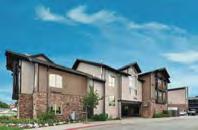



By now, most people are aware of AI—artificial intelligence—and its increasing, everyday role in our lives through things like internet searches, home assistants (Alexa, Siri) and spelling and grammar correction, to self-driving cars, facial detection and even refrigerators that can order our groceries when we get low.
Then ChatGPT became the first chatbot widely available to the public at the end of 2022 (followed quickly by others like Gemini, Co-pilot, Claude, Perplexity) and suddenly, everyone became a “content generator,” developing stories, artwork and even music with the friendly, helping hand of AI.
It was quickly discovered that AI makes no real distinction between what’s true and what’s false, a charming little quirk dubbed “hallucinations” or “confabulations.” To be fair, humans can have a hard time with this, too. But as more and more data is fed into the various AI machines, they get better and better at approximating human effort, even though some limited studies have shown they will get factual information wrong (or create their own truth) more than half the time.
As content generators ourselves here at Sandpoint Magazine, we decided to give the chatbots a go. After giving “Chatty” free rein over a variety of information about our town (including this magazine), we asked for a short article roasting Sandpoint… and then kept tweaking our ask. The result made those of us in the office laugh, and we share it here in the hope you will do the same. Here’s what Chatty wrote.
Ah, Sandpoint—Idaho’s little slice of heaven, assuming heaven is full of Subarus, craft beer and people who moved here to “get away from it all” only to start a podcast about it. Nestled between mountains and Lake Pend Oreille, Sandpoint is the kind of place where everyone knows your name, your dog's name and exactly how many times you’ve tried—and failed—to summit Scotchman Peak or the Mickinnick Trail.
Winters here are for the diehards. The ones who don’t flinch
at single-digit temps, ski in flannel and act personally offended when Schweitzer gets less than a foot of fresh powder. And summer? That’s when the town population triples overnight, as every lost soul with a van and a dream clogs up downtown traffic trying to find a parking spot within 10 miles of City Beach.
Of course, there’s no denying Sandpoint’s charm. The sunsets over the lake are disgustingly beautiful, the huckleberries are basically currency and the people are friendlier than a golden retriever at a brewery. But let’s be honest—between the endless roadwork, the “help wanted” signs in every restaurant and the never-ending debate over whether Sandpoint is still a hidden gem or officially ruined, it’s a miracle anyone gets anything done.
Schweitzer Mountain might have world-class skiing, but let’s be real—the real sport here is navigating the local traffic during peak tourist season. Everyone’s driving with their eyes on the scenic views—and that’s when they’re not getting distracted by the local moose walking through the coffee shop parking lot.
But don’t get me started on the tourists—half of them are lost, the other half are trying to “discover” the town like it’s a hidden gem no one’s ever heard of before and all of them are clogging up traffic because nobody can figure out the speed limit changes every five feet.
Visitors love us, but don’t let the “tourist town” moniker fool you. Sandpoint is more than that—it’s where nature’s beauty and a stubbornly quirky small-town vibe make for a place that’s as hard to leave as it is to stop talking about!
So raise a glass (likely filled with something locally brewed, small-batch or infused with pine needles). Sandpoint, you’re weird, wonderful and just chaotic enough to keep us all coming back for more.
Let’s face it… Chatty wasn’t wrong. Sandpoint, you are weird and wonderful and, often, pretty chaotic. We hope you stay that way.


